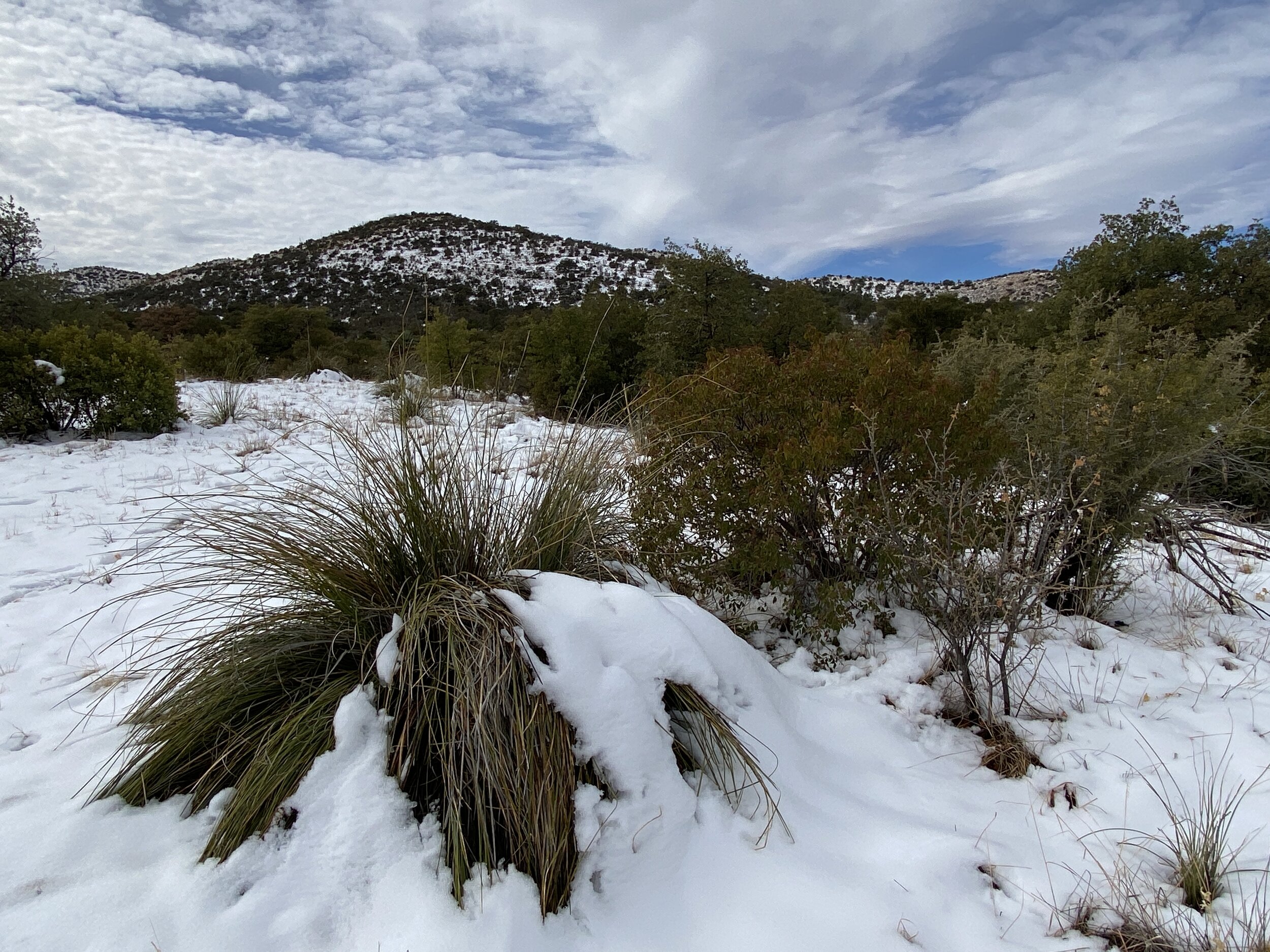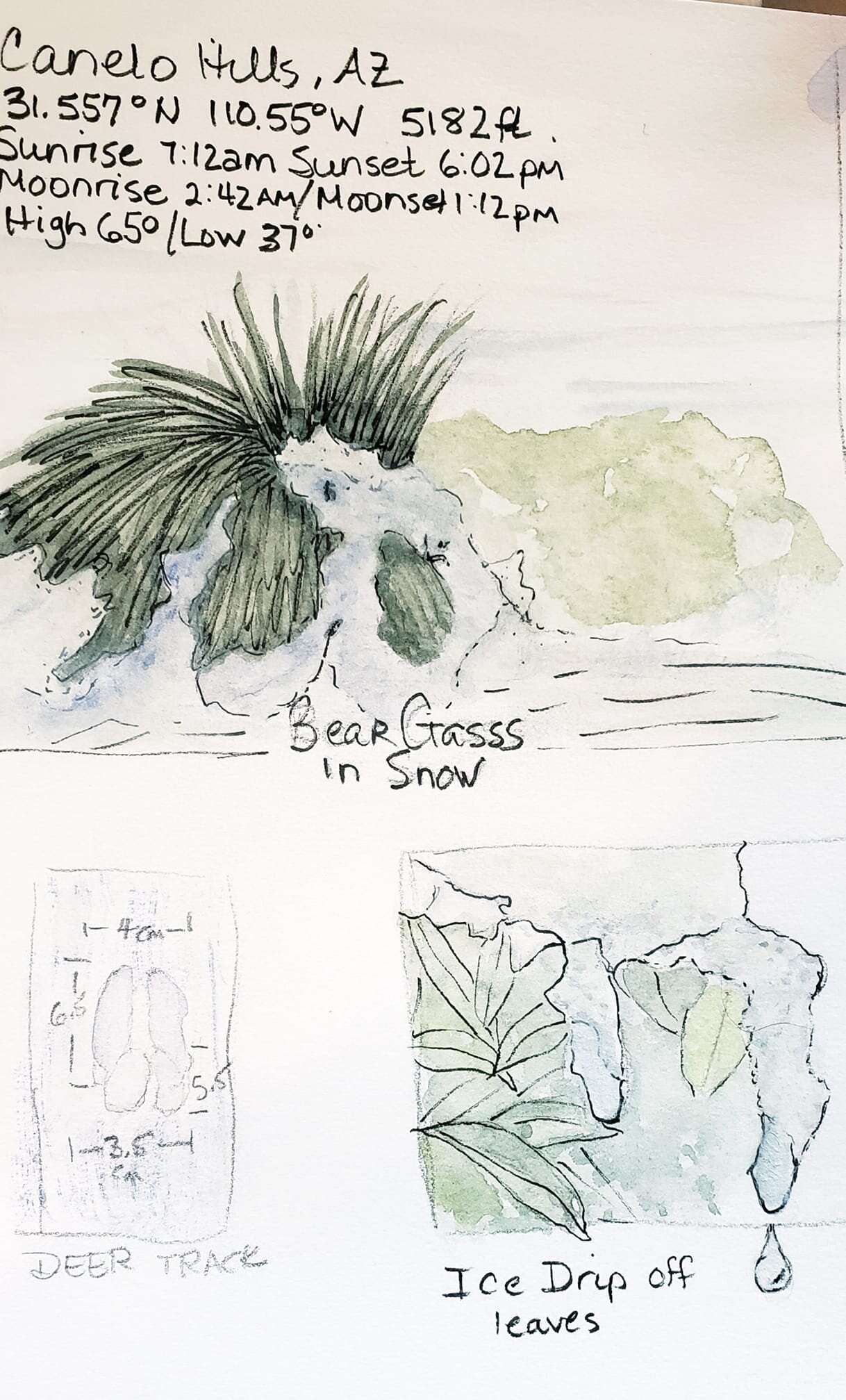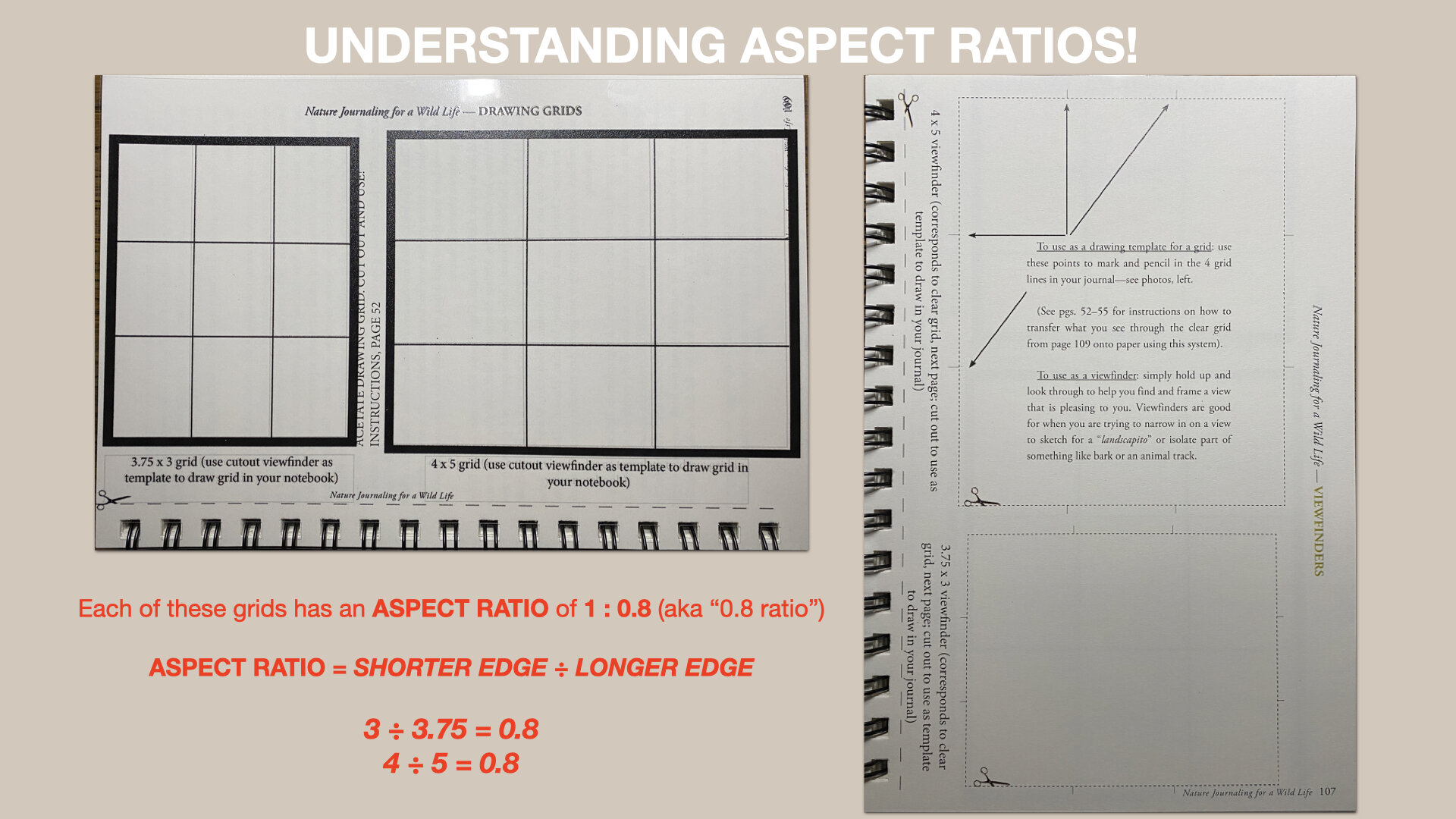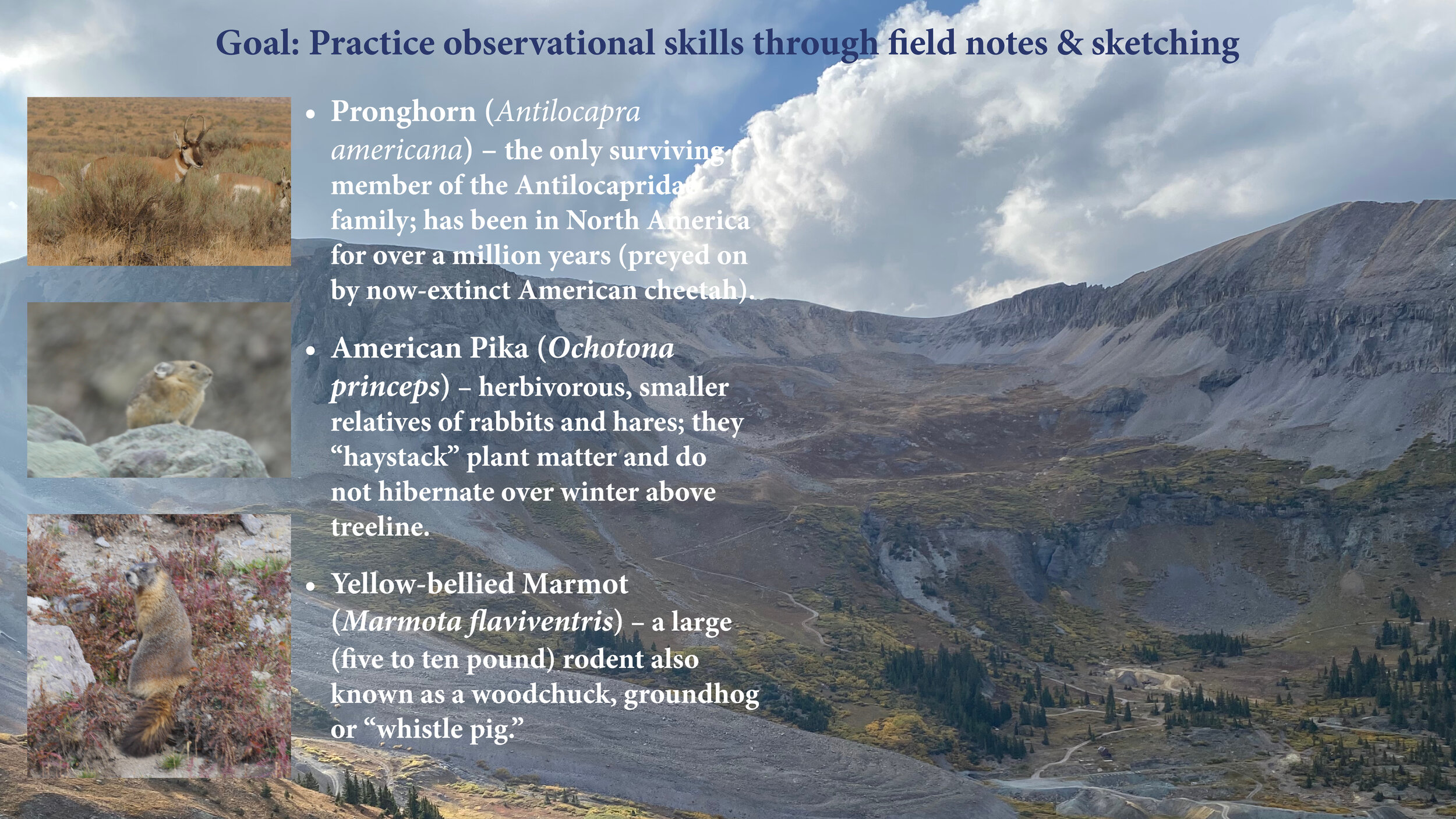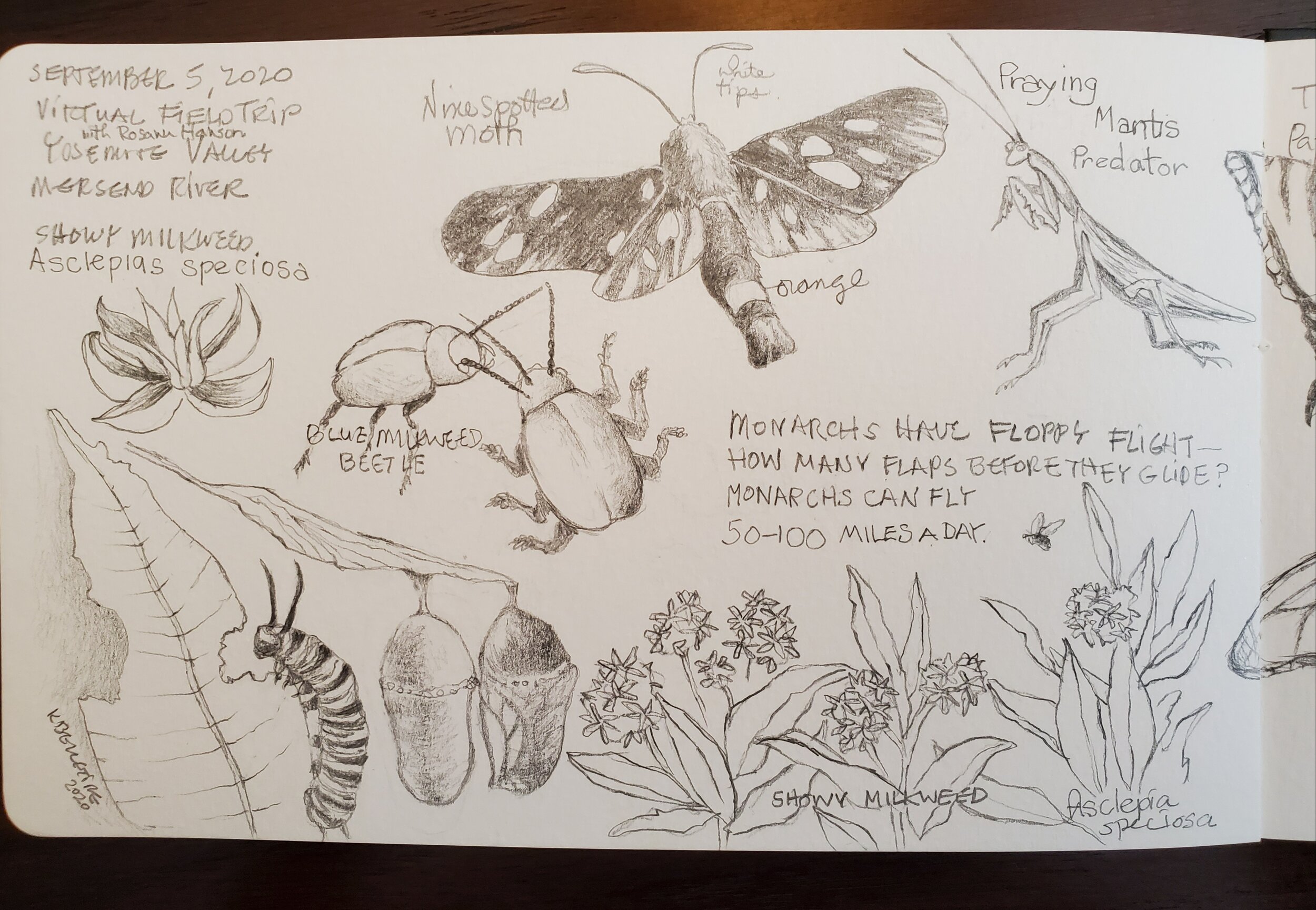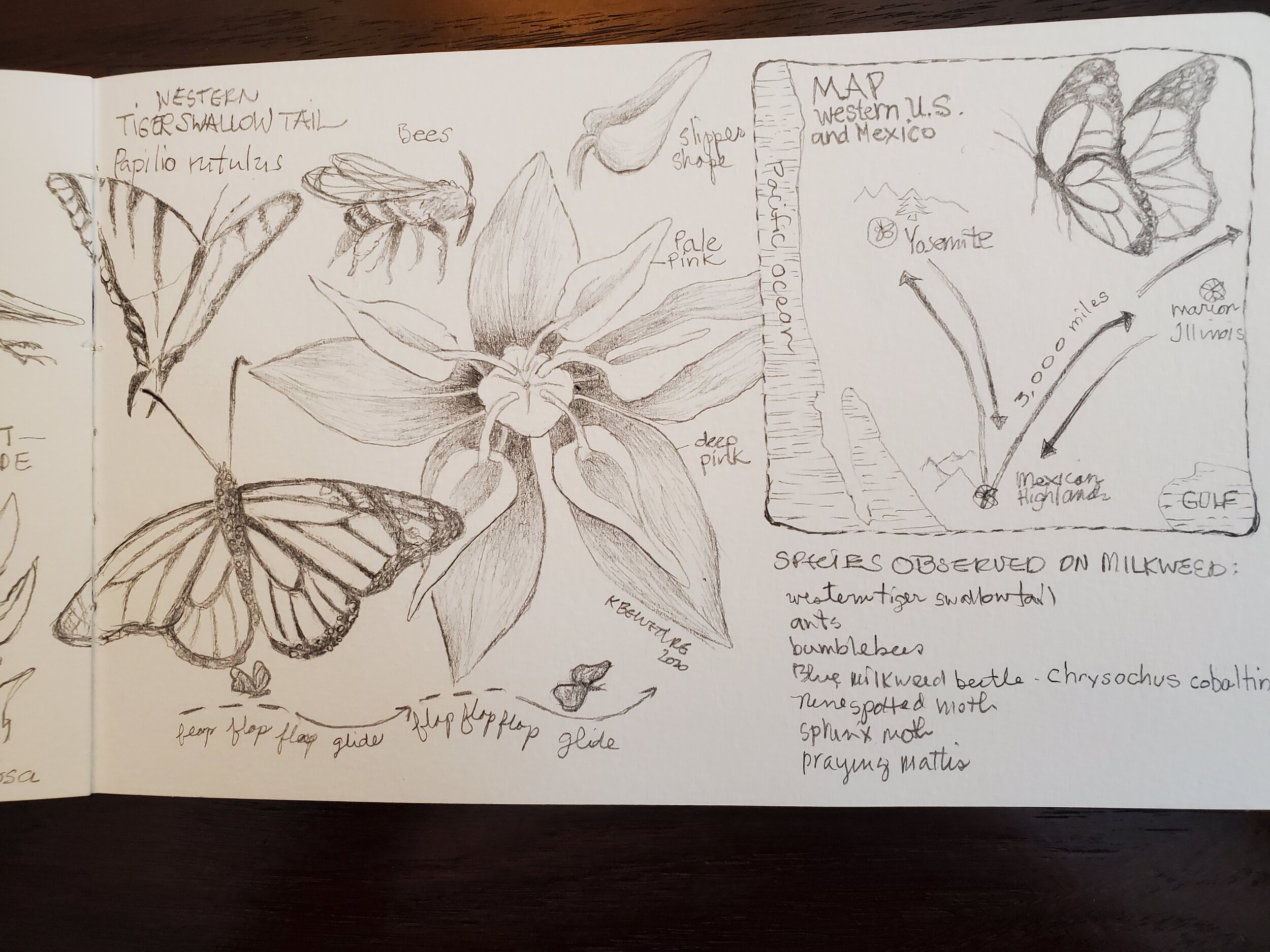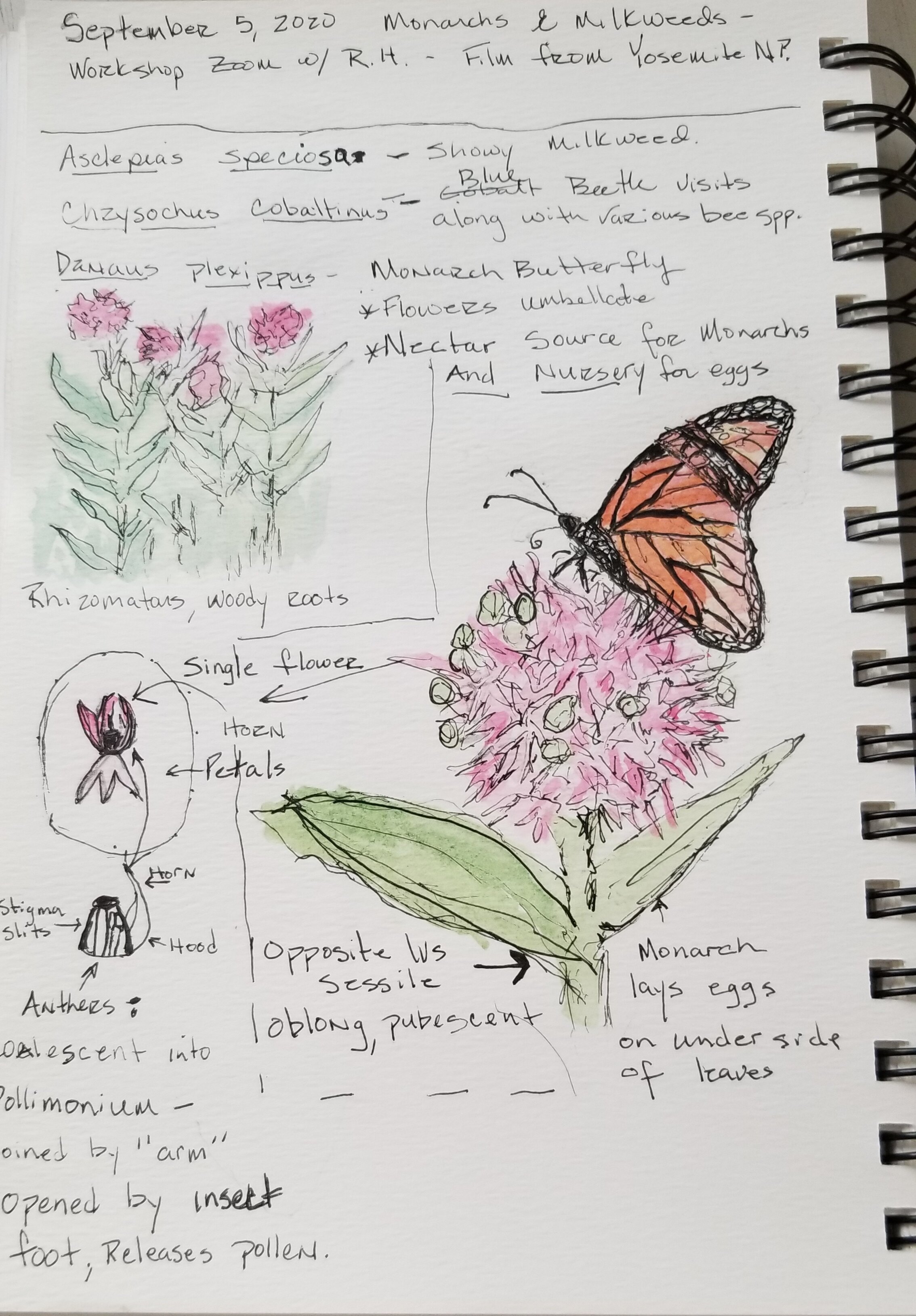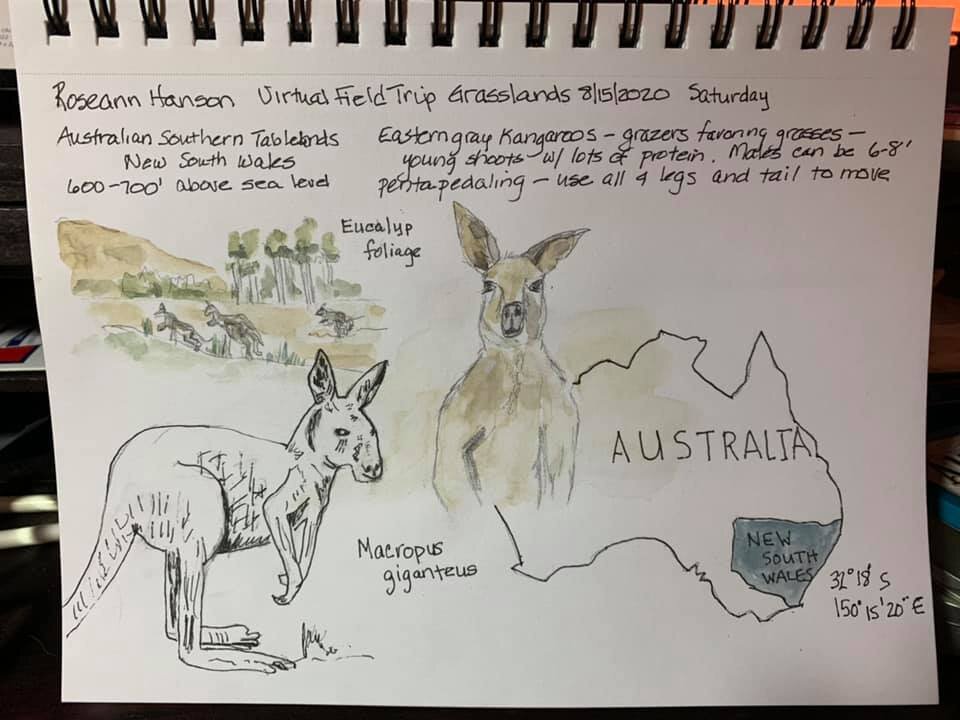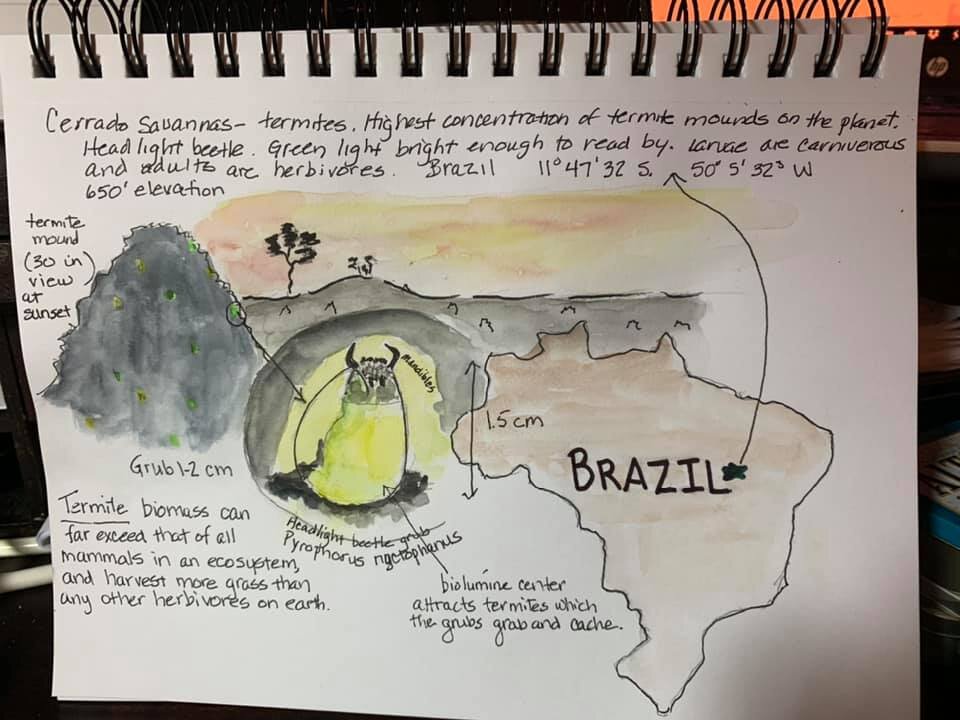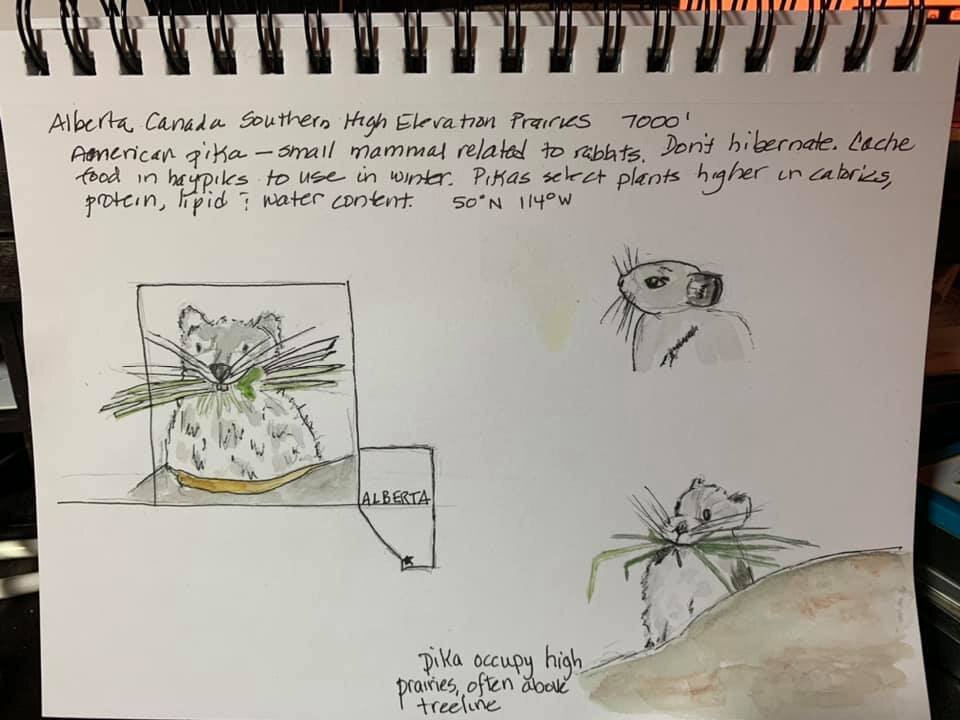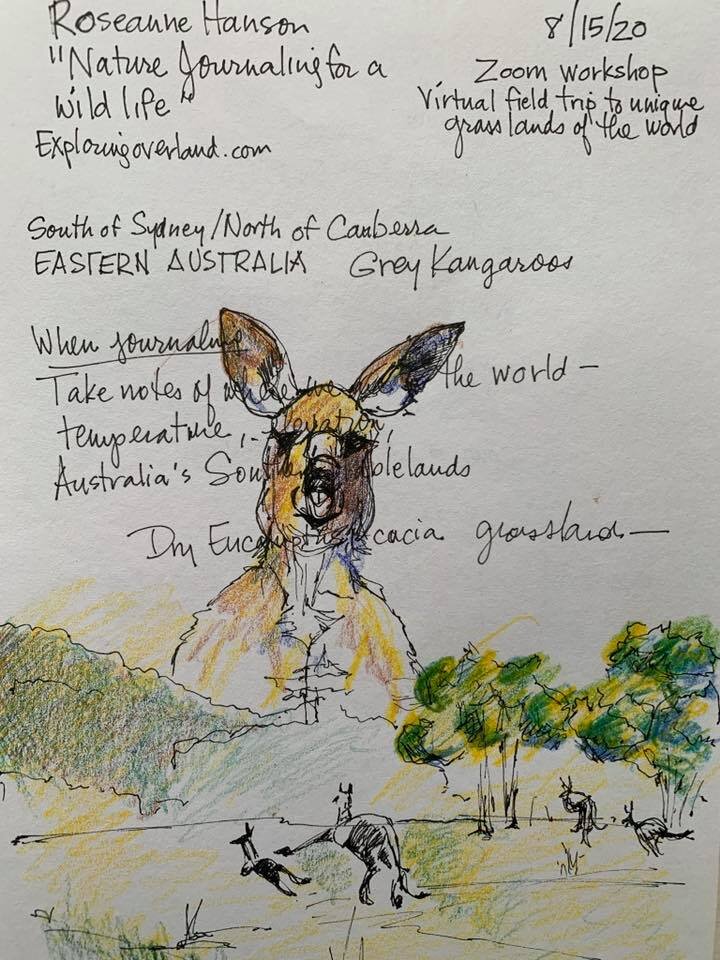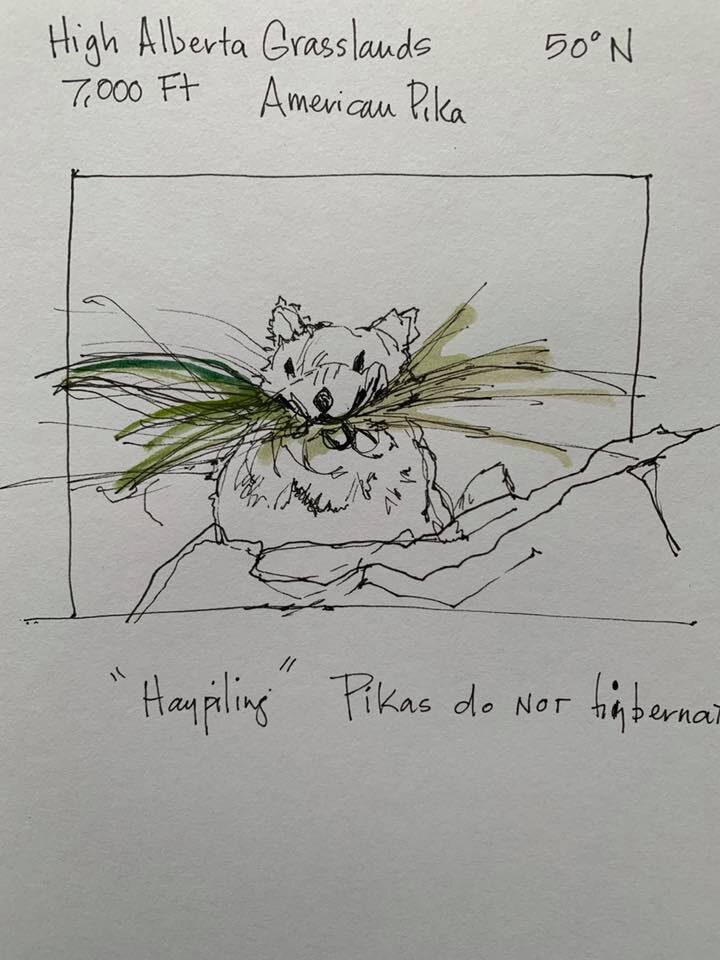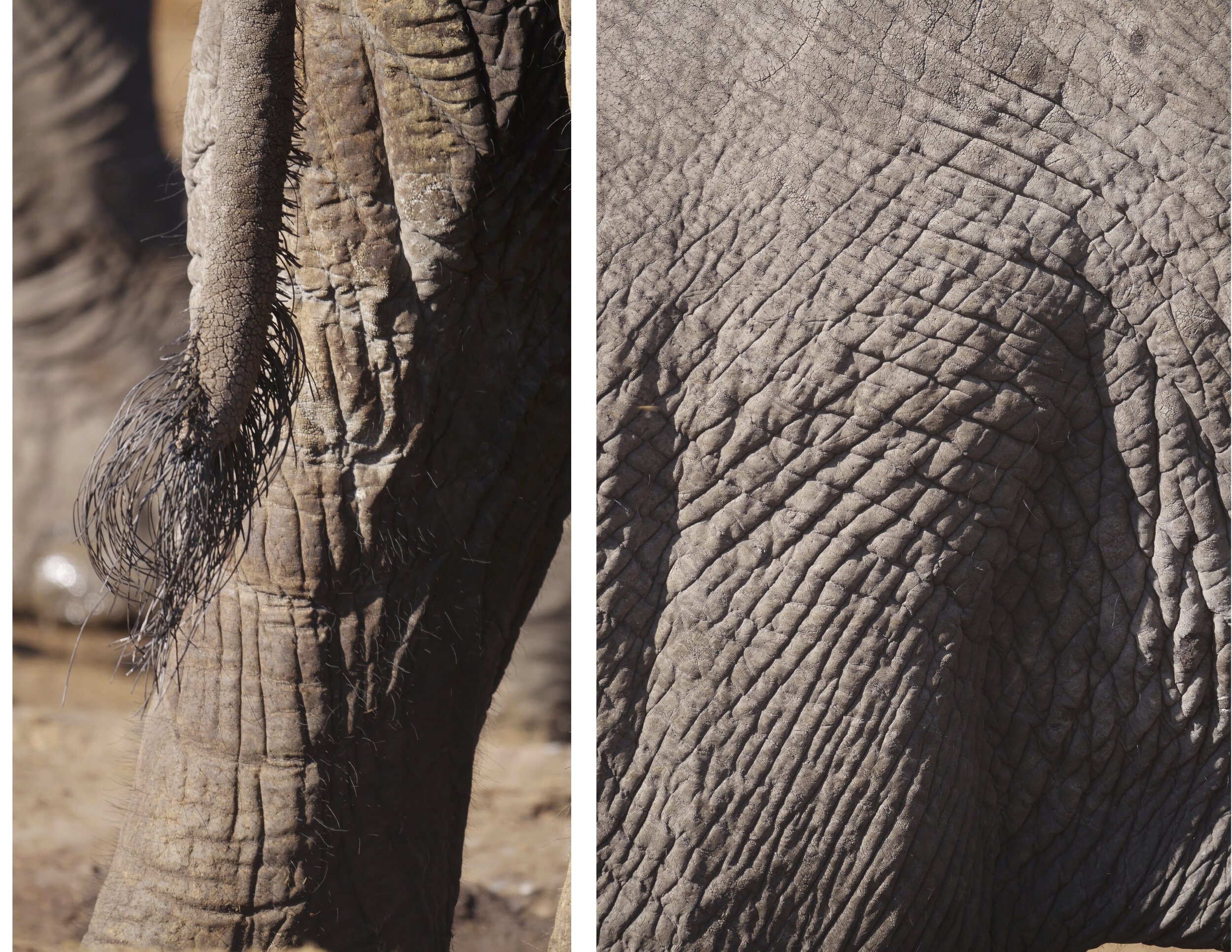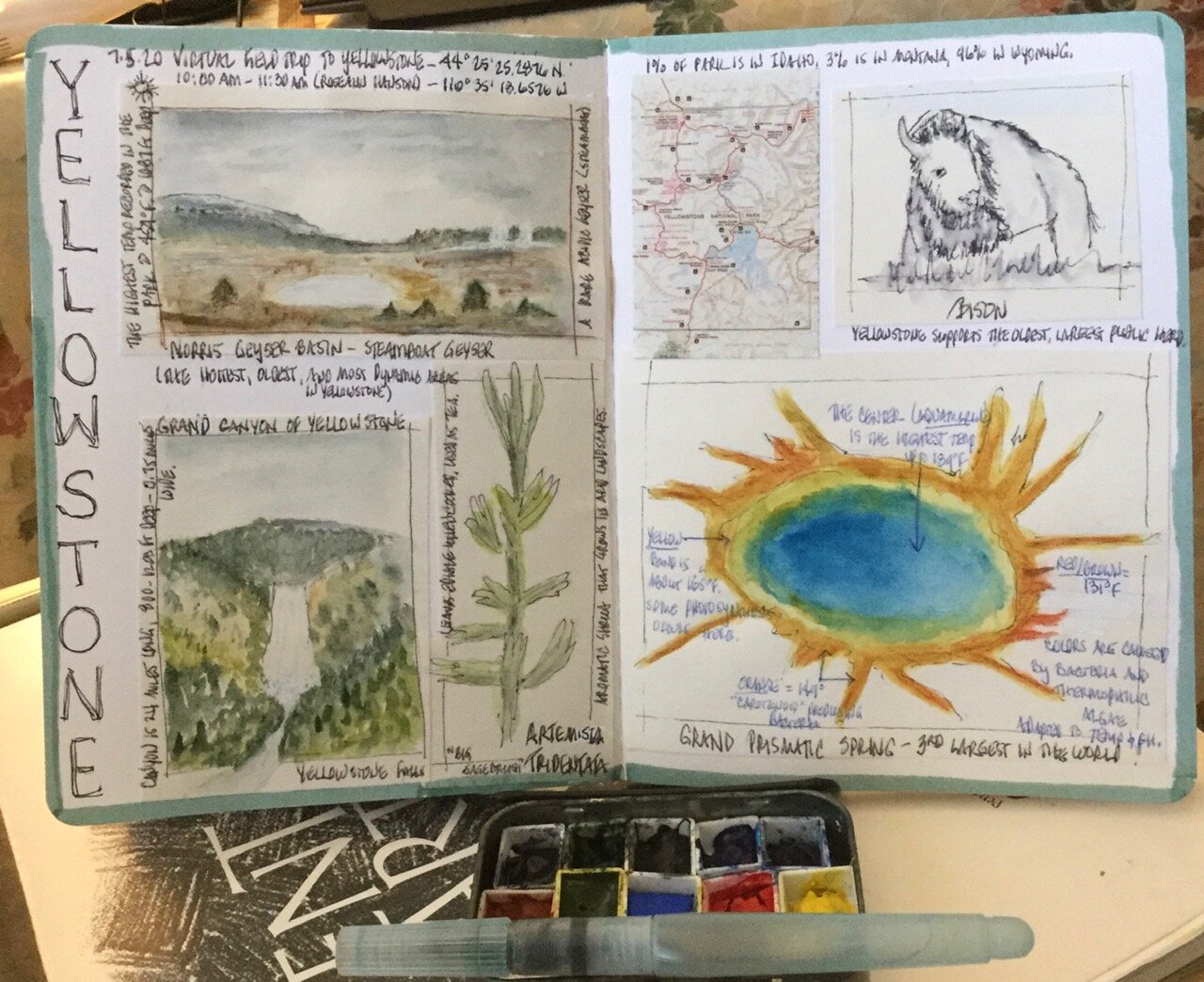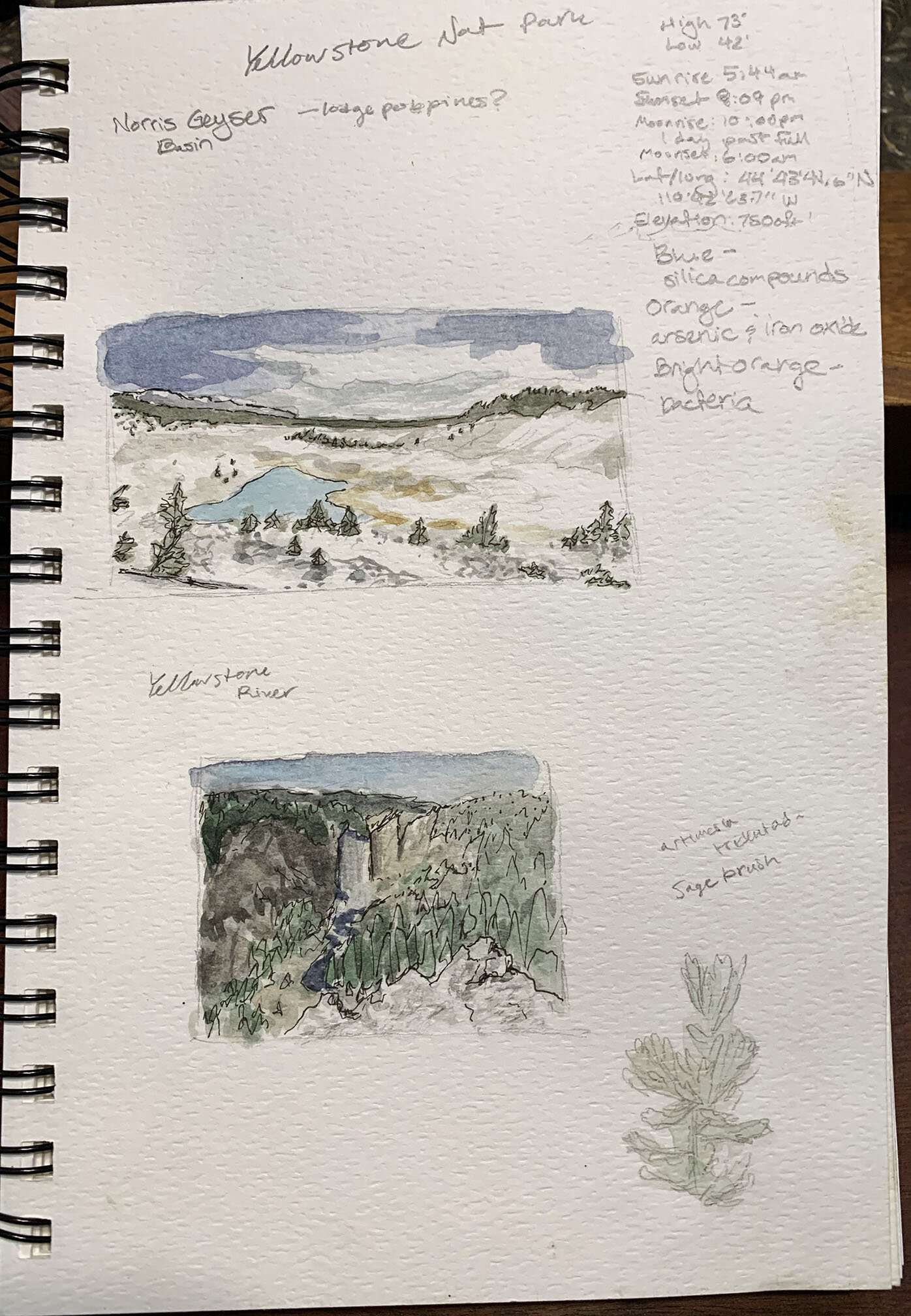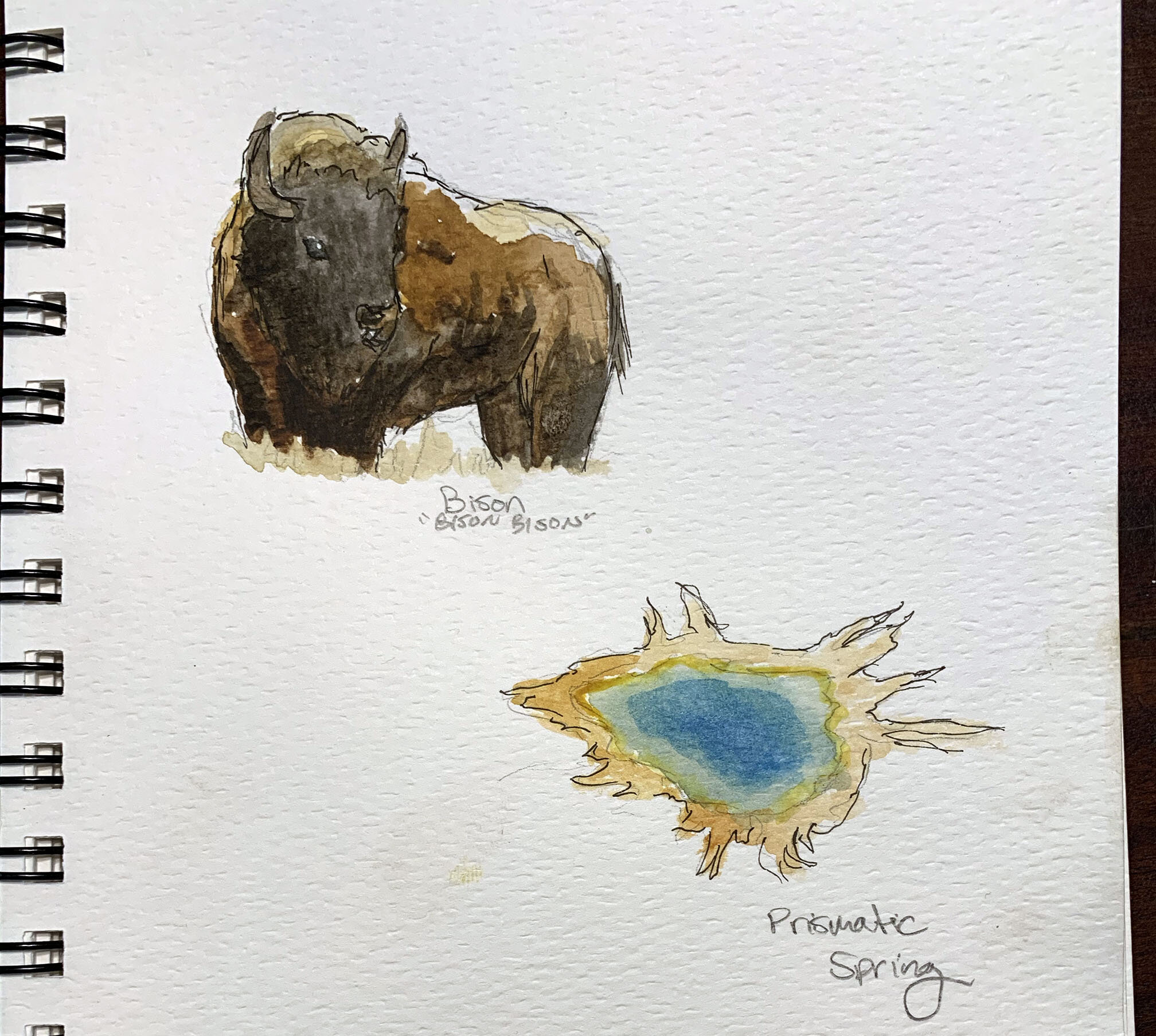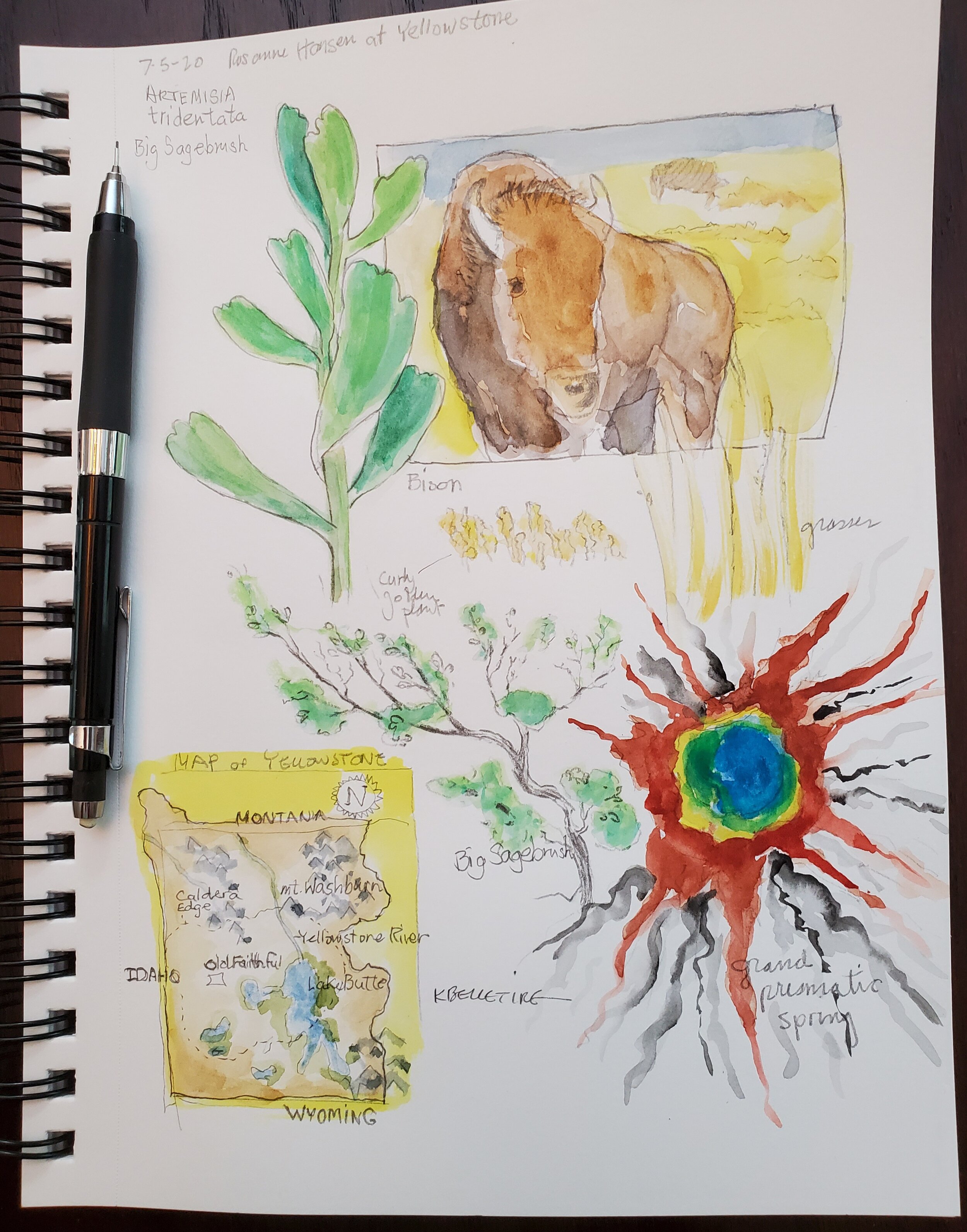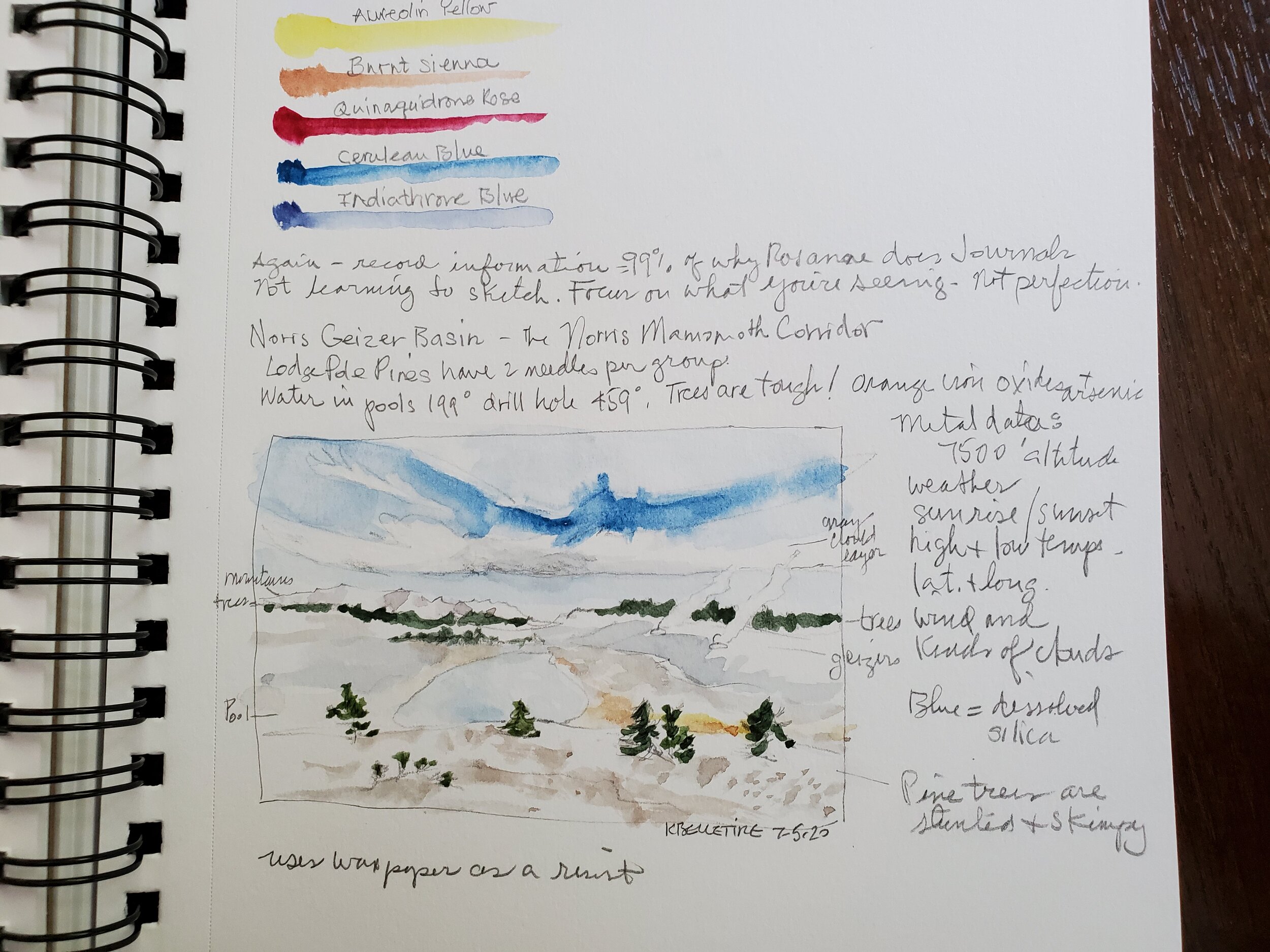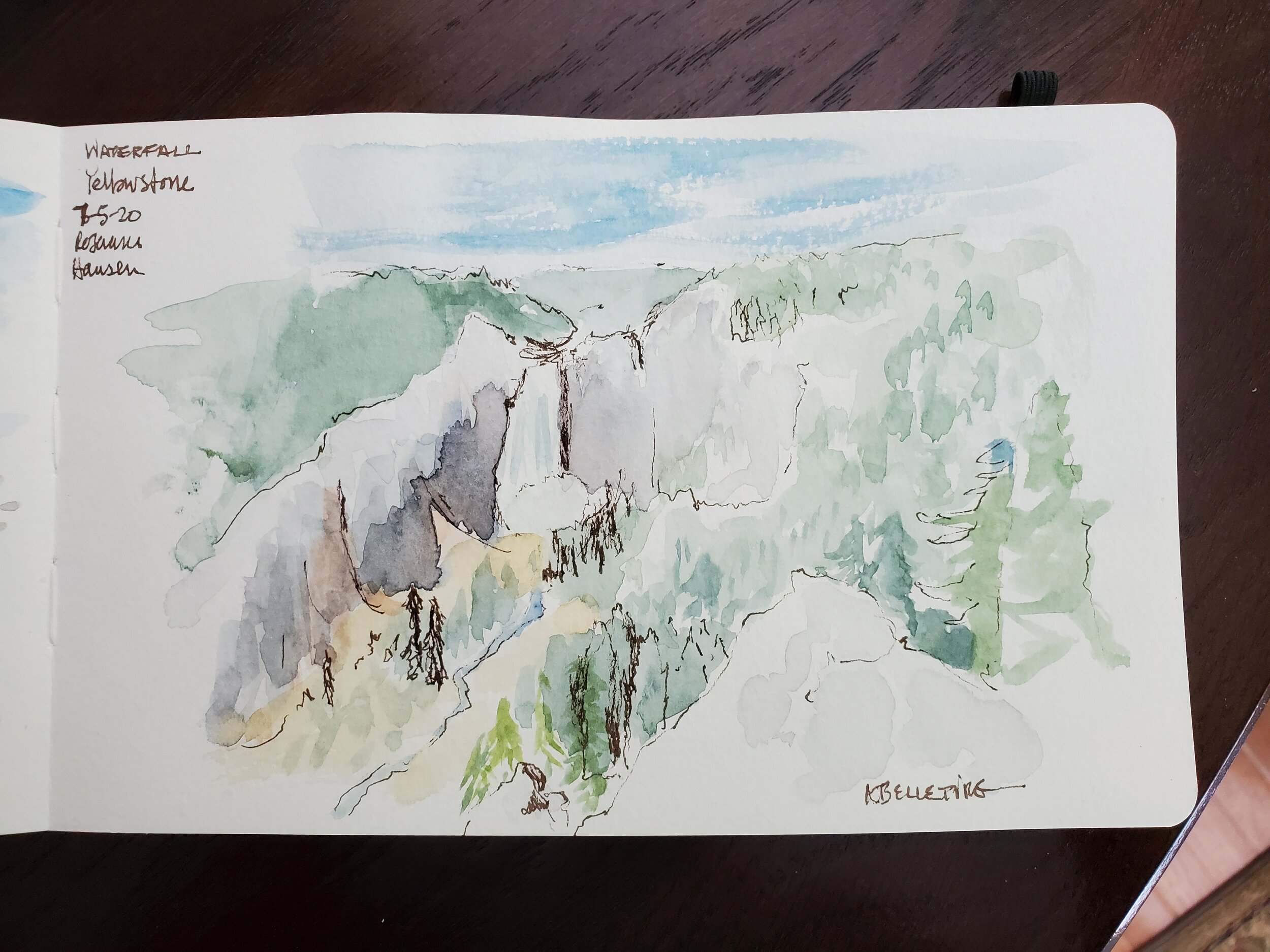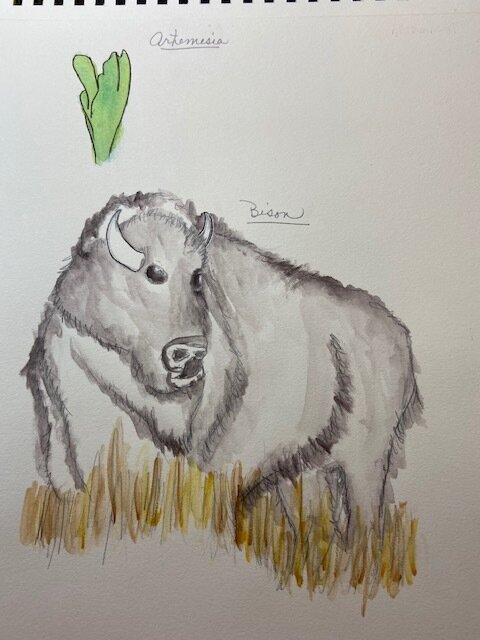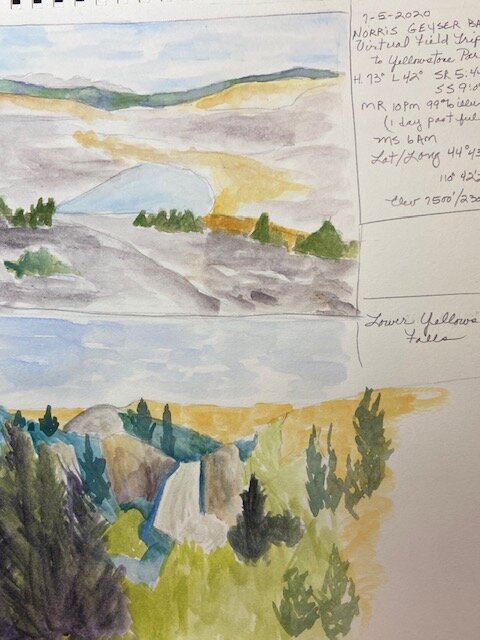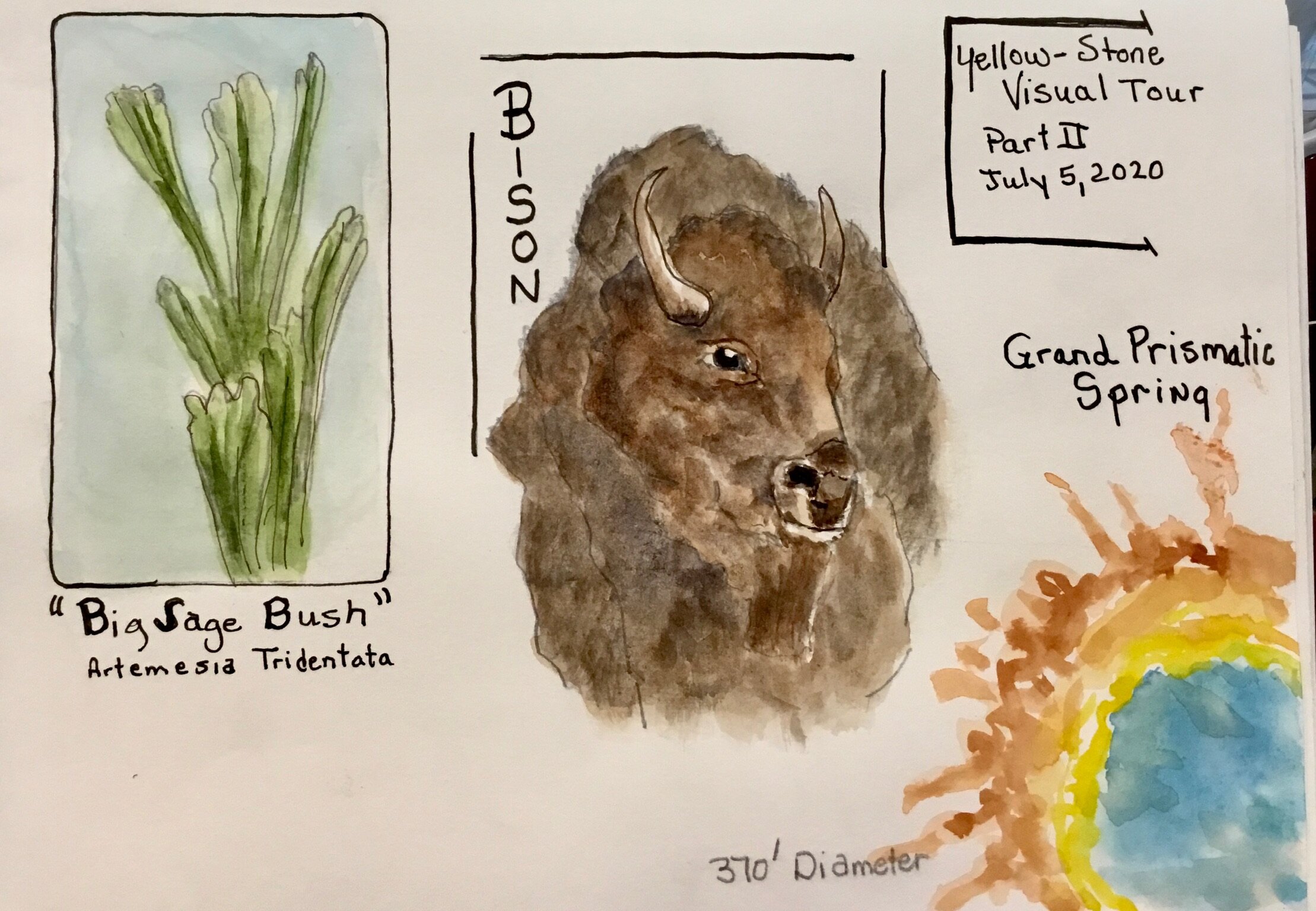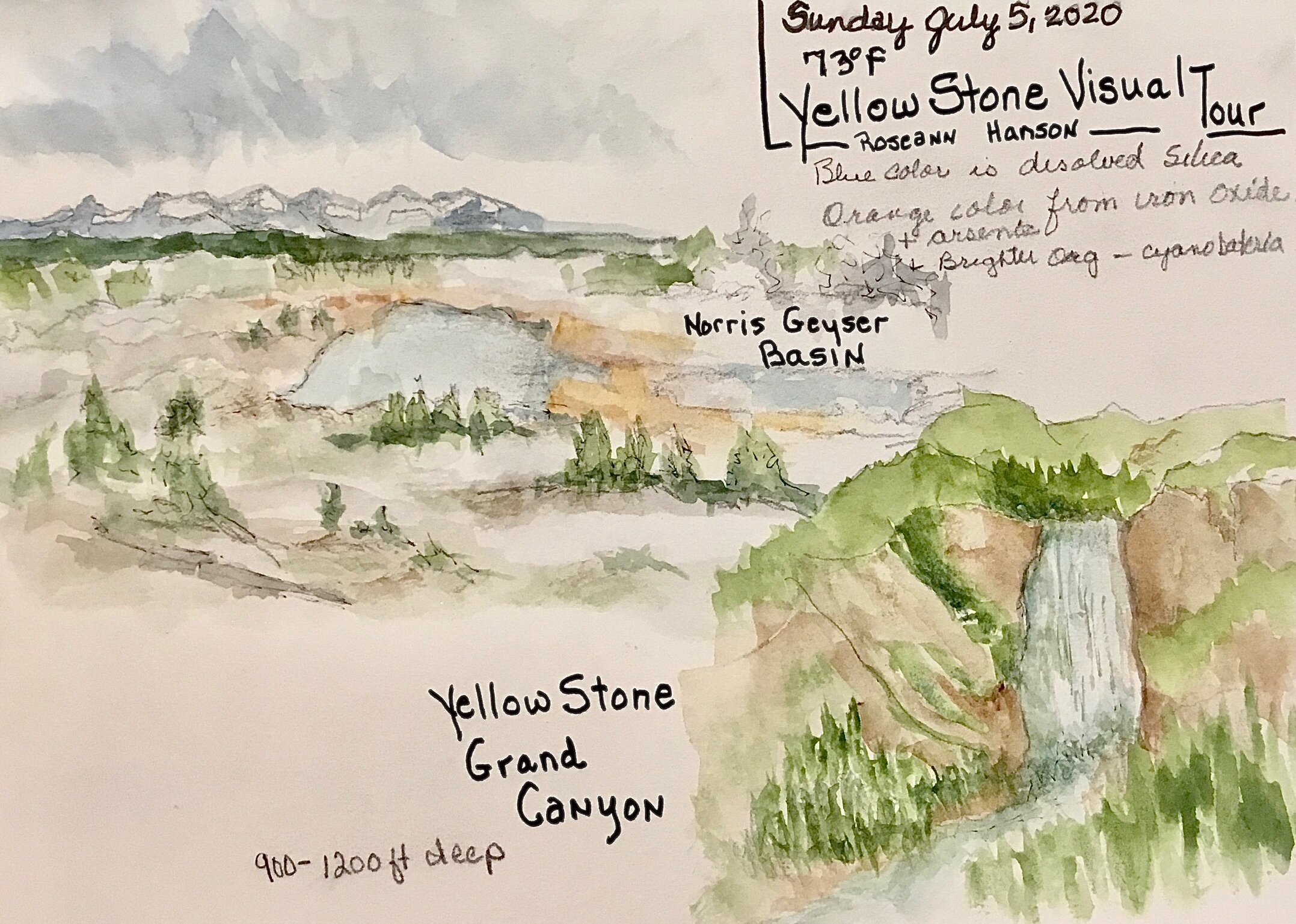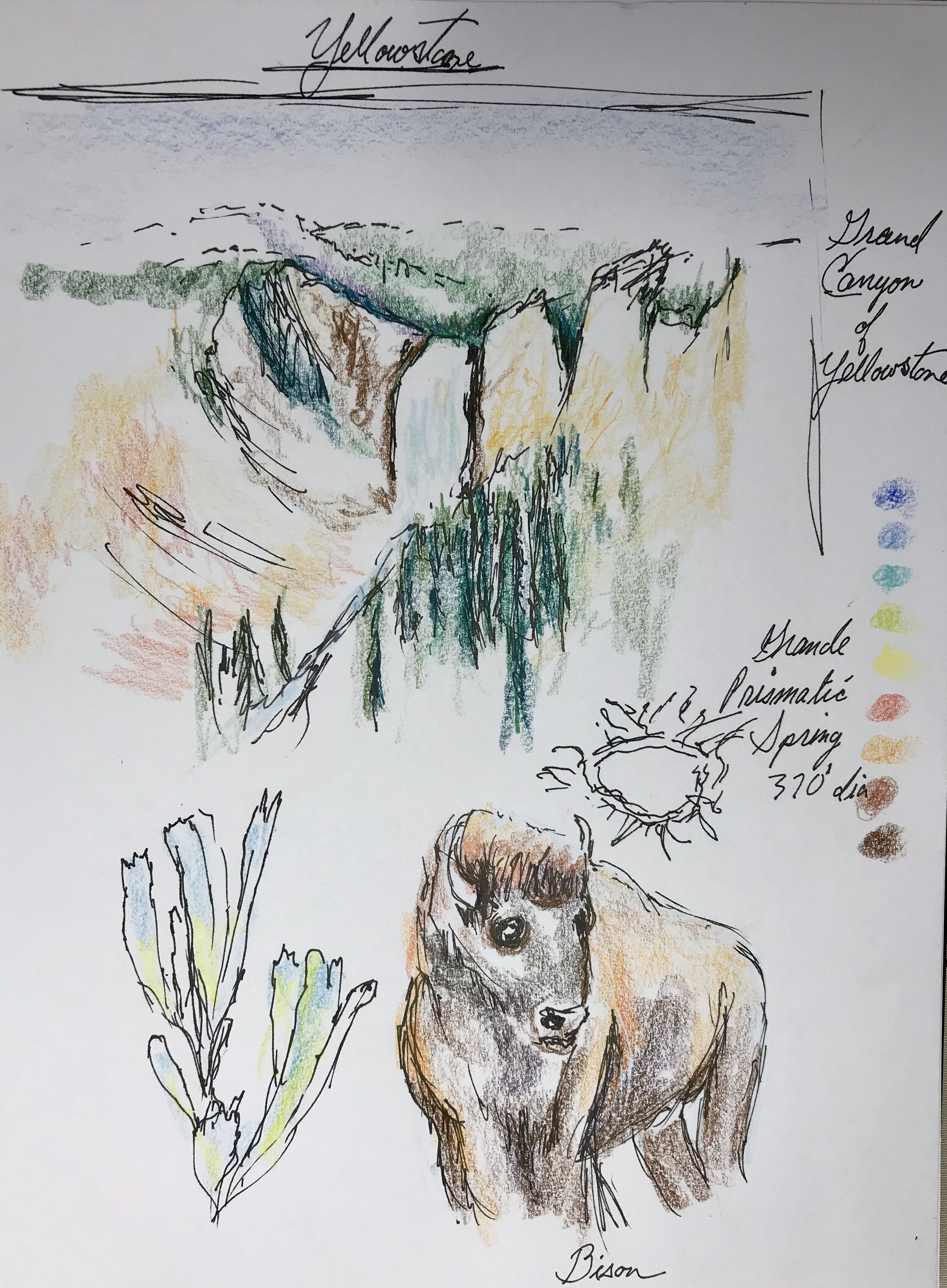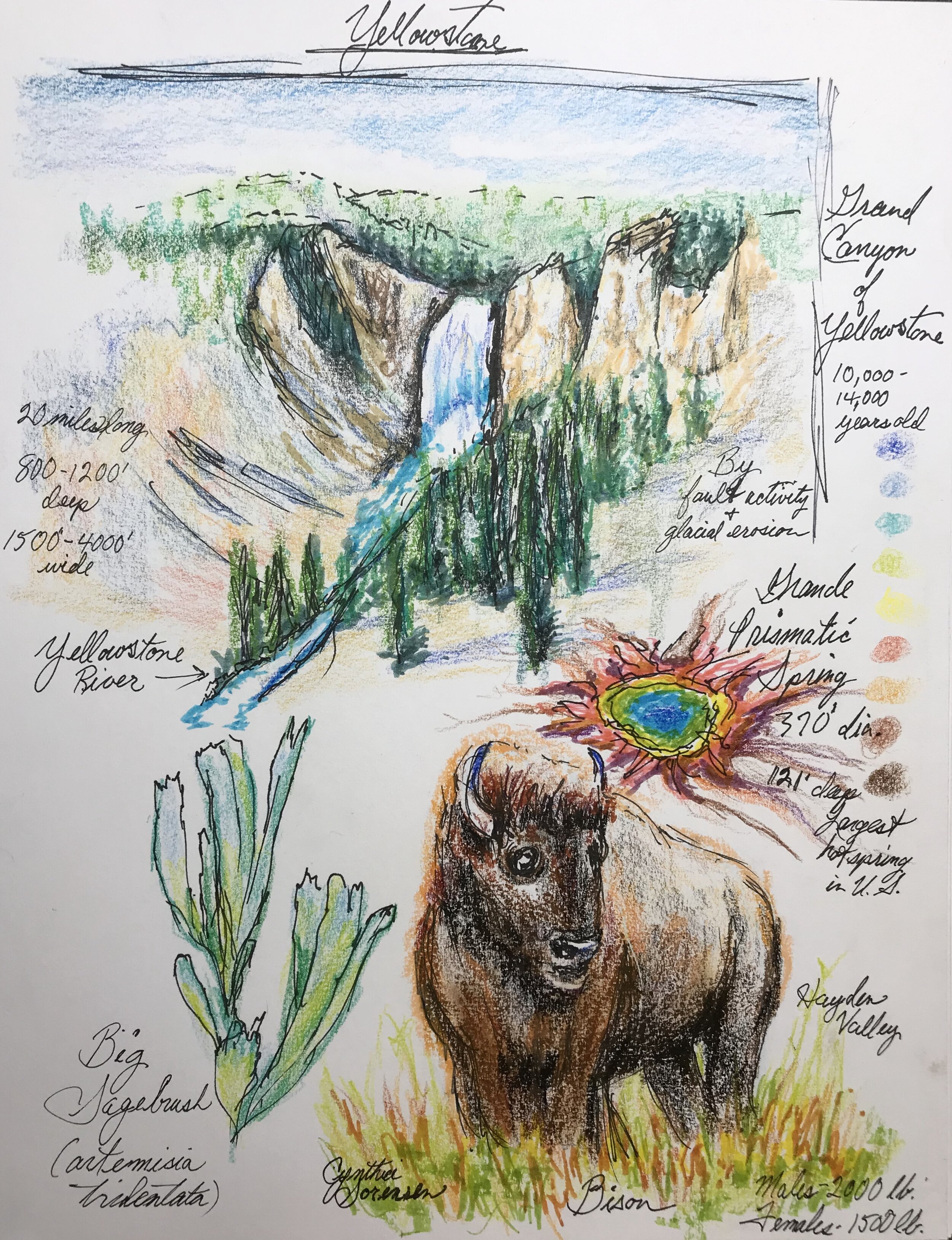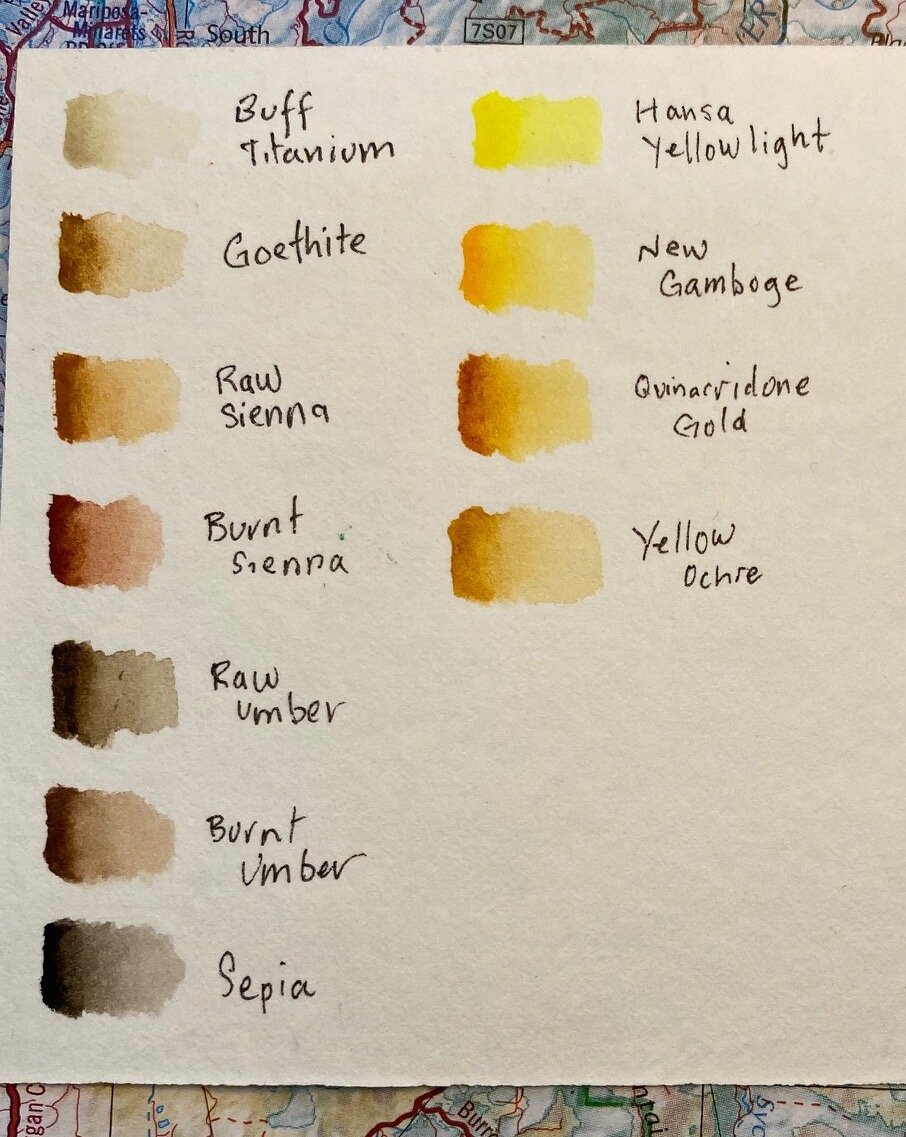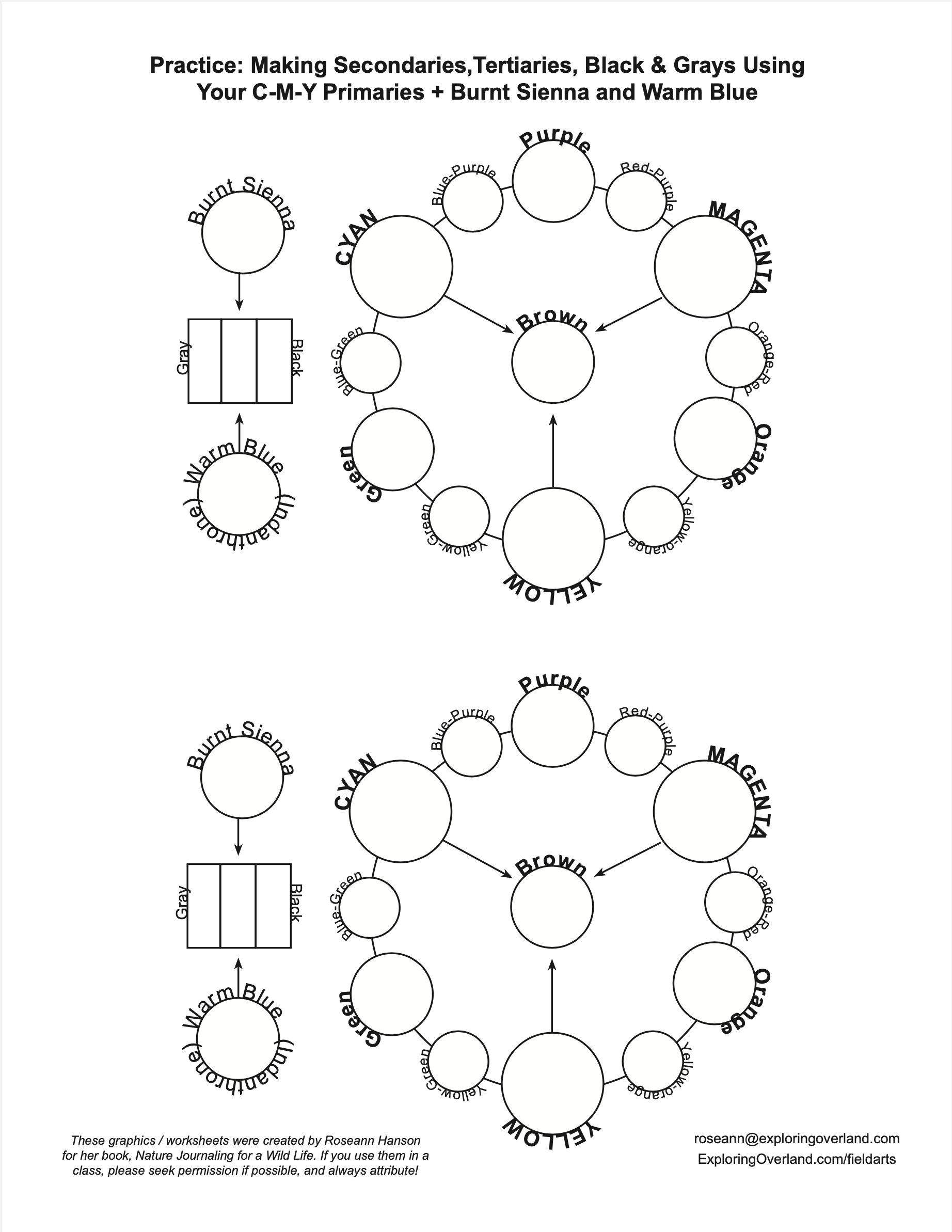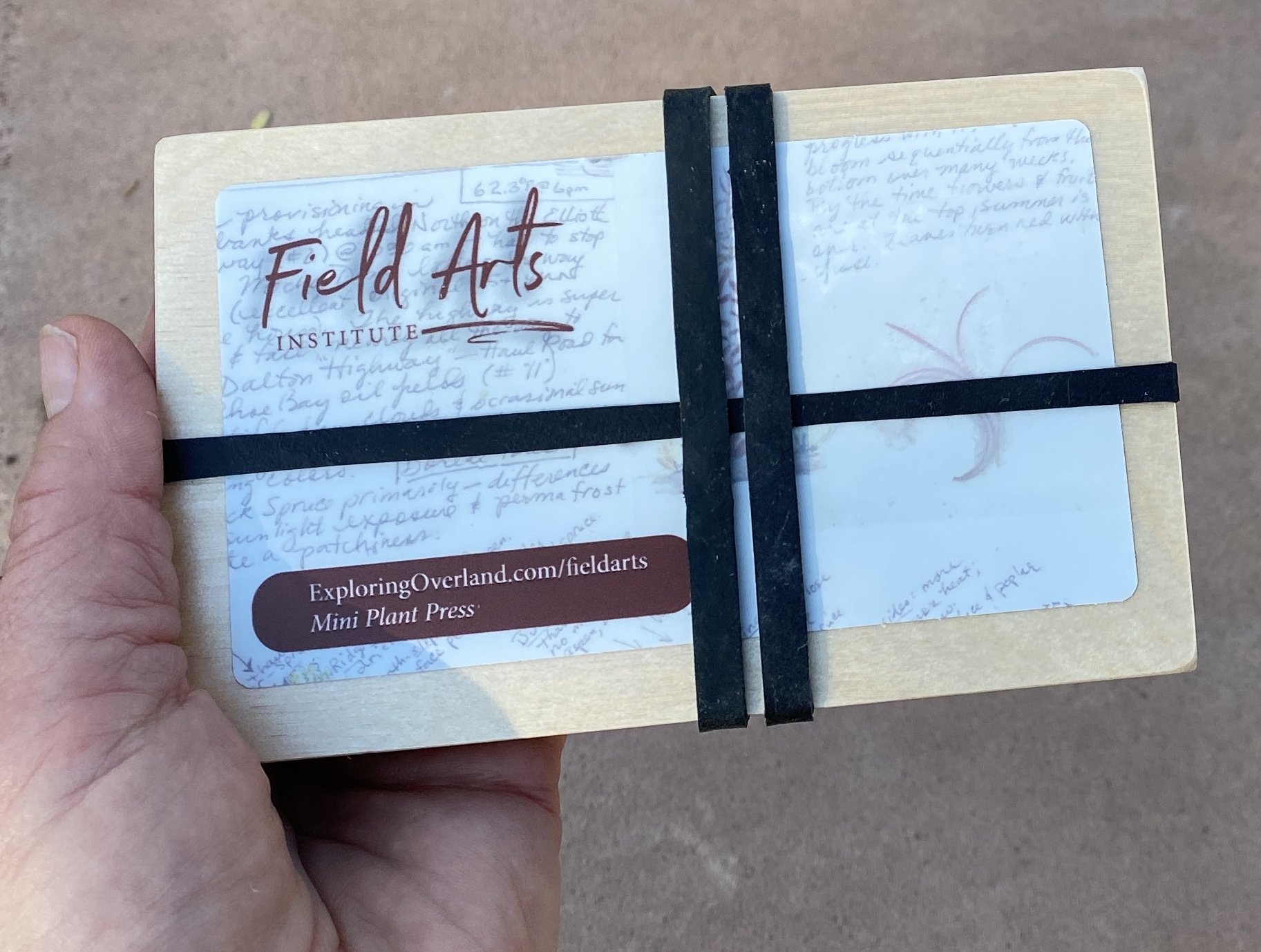Field Arts Workshop: Elegant Ink for Field Notebooks
Join me for a celebration of the art of elegant ink in our sketchbooks. While I do love color in my journal, I also love the beauty of well-wrought pen sketches.
We’ll cover types of pens and inks (from ballpoint to fountain pens, including the pluses and minuses of the types); practice mark-making and values; and work on a couple of different types of sketches using one image to create each, so we can see how different styles of linework each produce a different “feel” on your pages.
Length: 2 hours
Images at right: Creating various “palettes” for your marks is a great exercise and very useful to keep tucked in a pocket of your journal for reference. The different types of stroke, texture, and tone are like words in a language or paint colors in a palette: you choose each for a different effect, feel, tone, or emphasis.
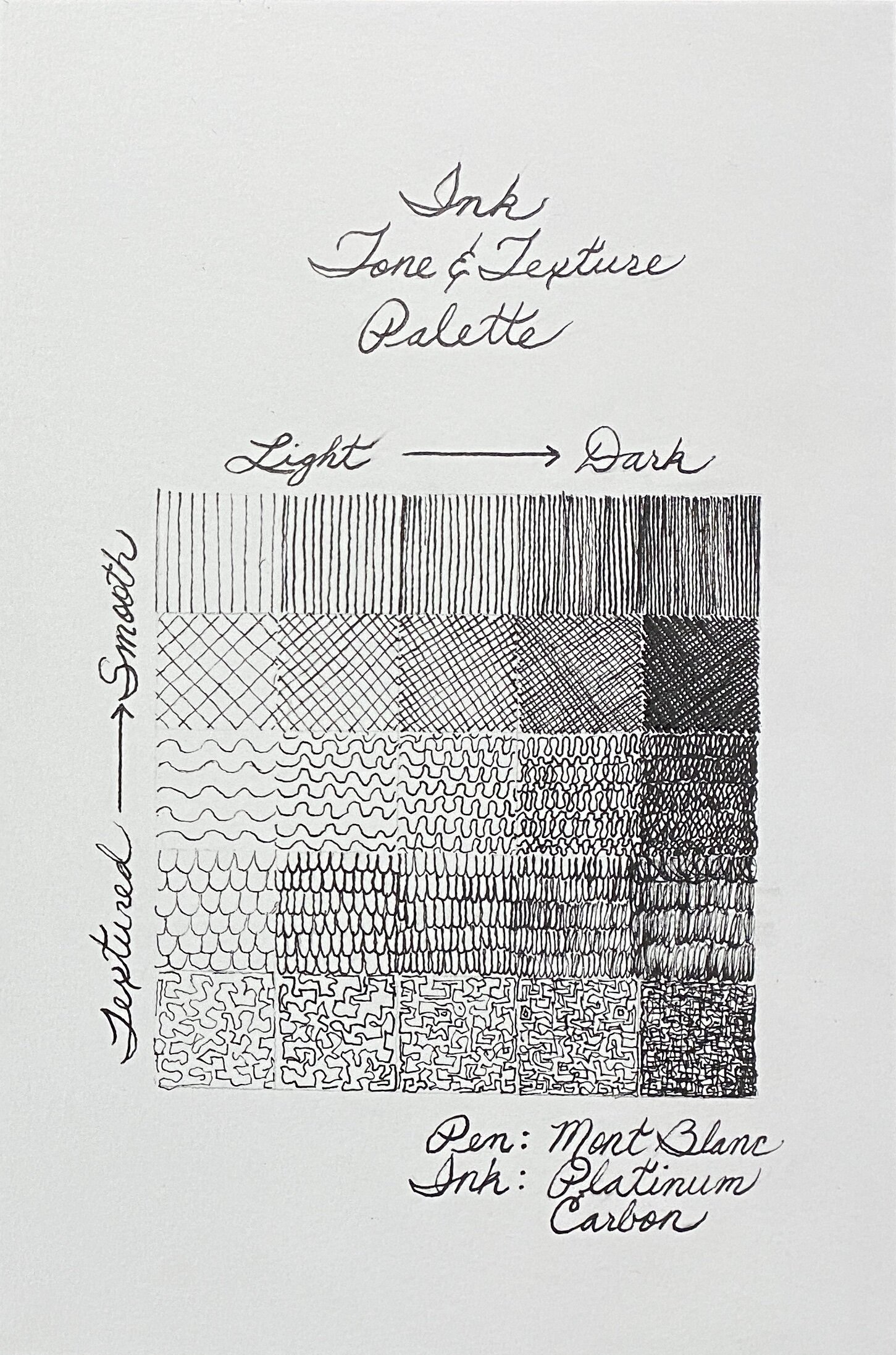
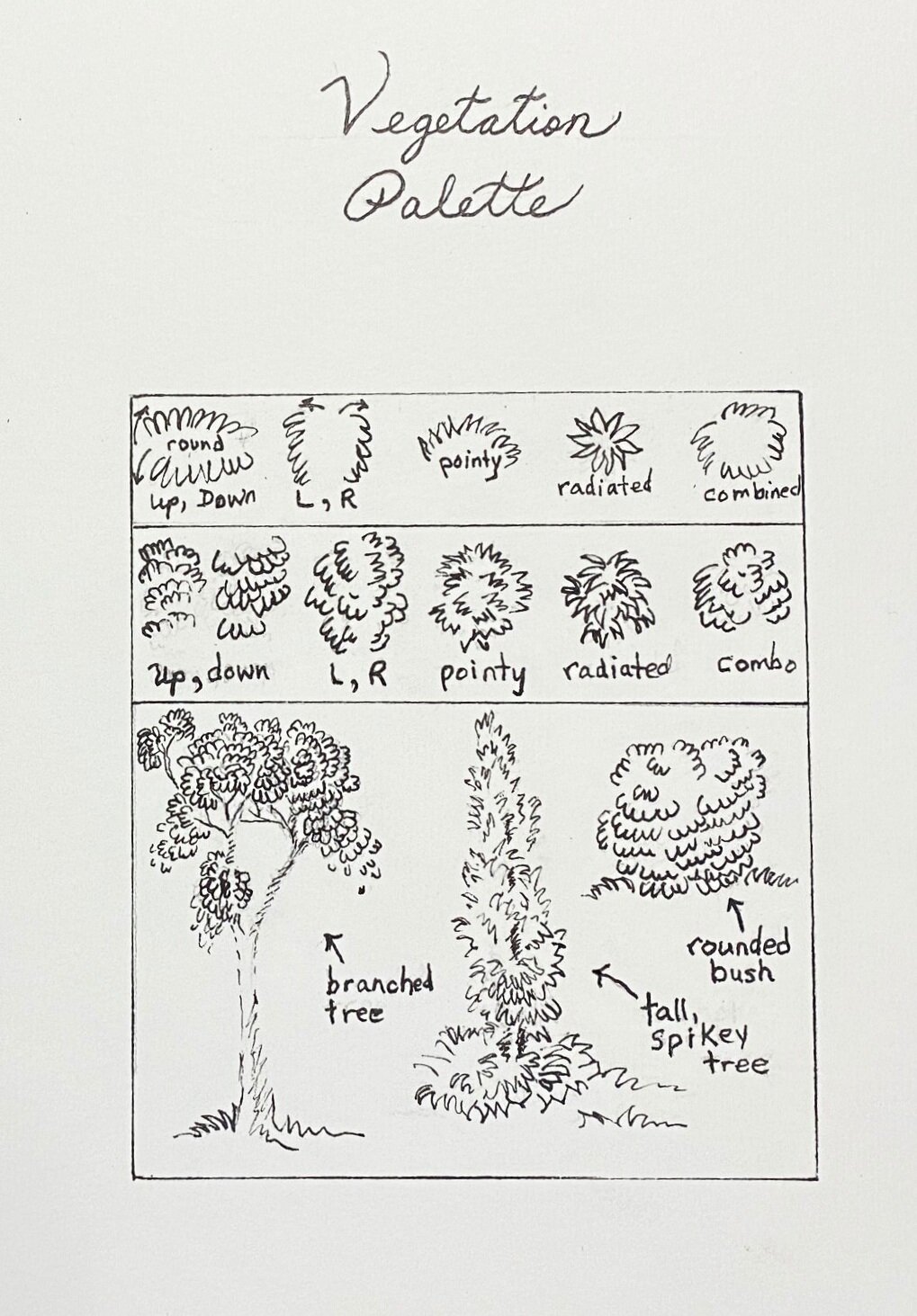
Resources from the Workshop
CHAT transcript — click > HERE <
Click image BELOW to initiate download for the workshop PDF with all the information, sample images, and links. Or, use: https://www.dropbox.com/sh/rvlzr0a9hezdgjr/AACw6pH9jwhj6sQ-rvmM_GGwa?dl=0
Bonus! I did a short video (no sound) of how to clean and refill a fountain pen:
DEMOS FROM THE WORKSHOP

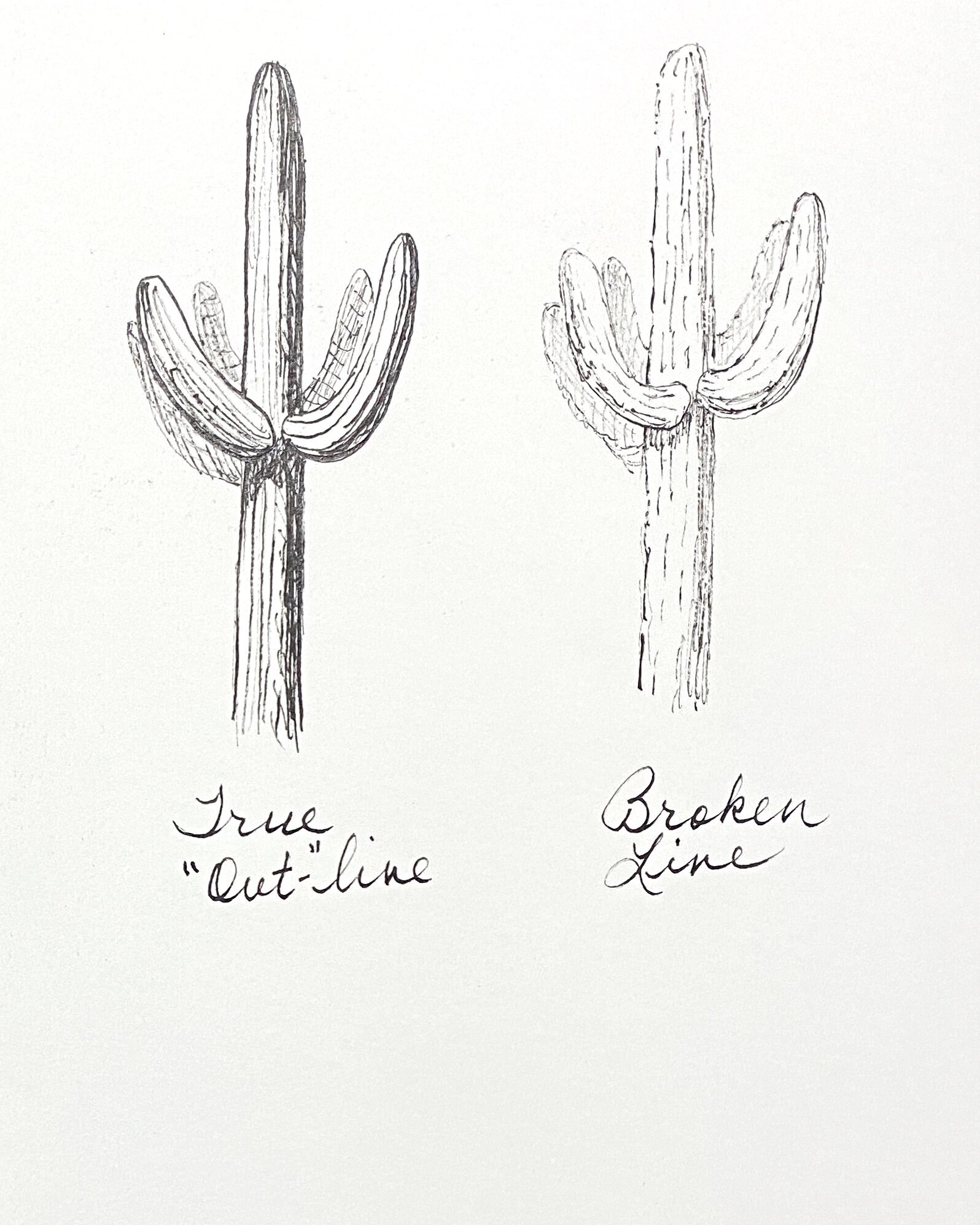
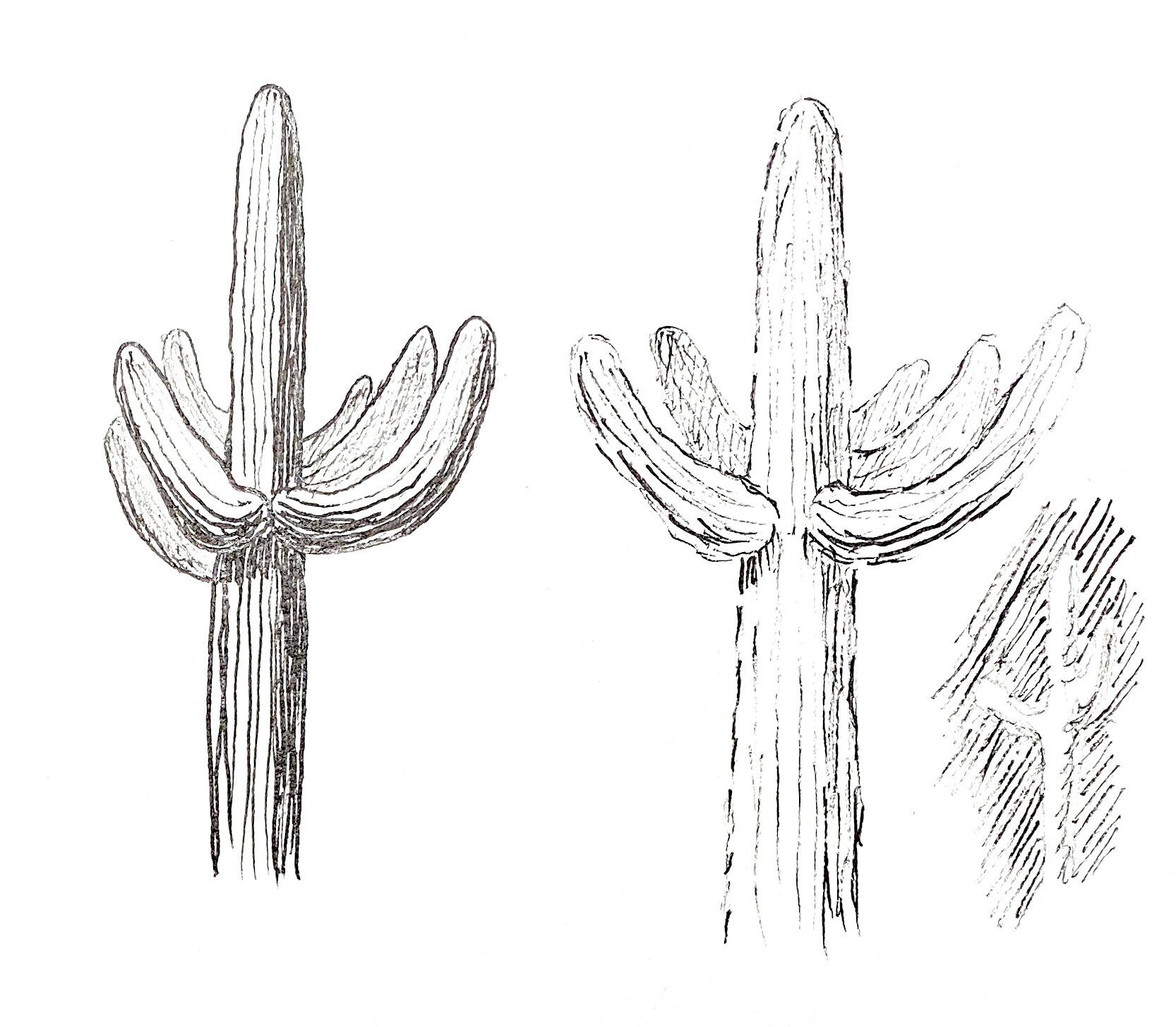
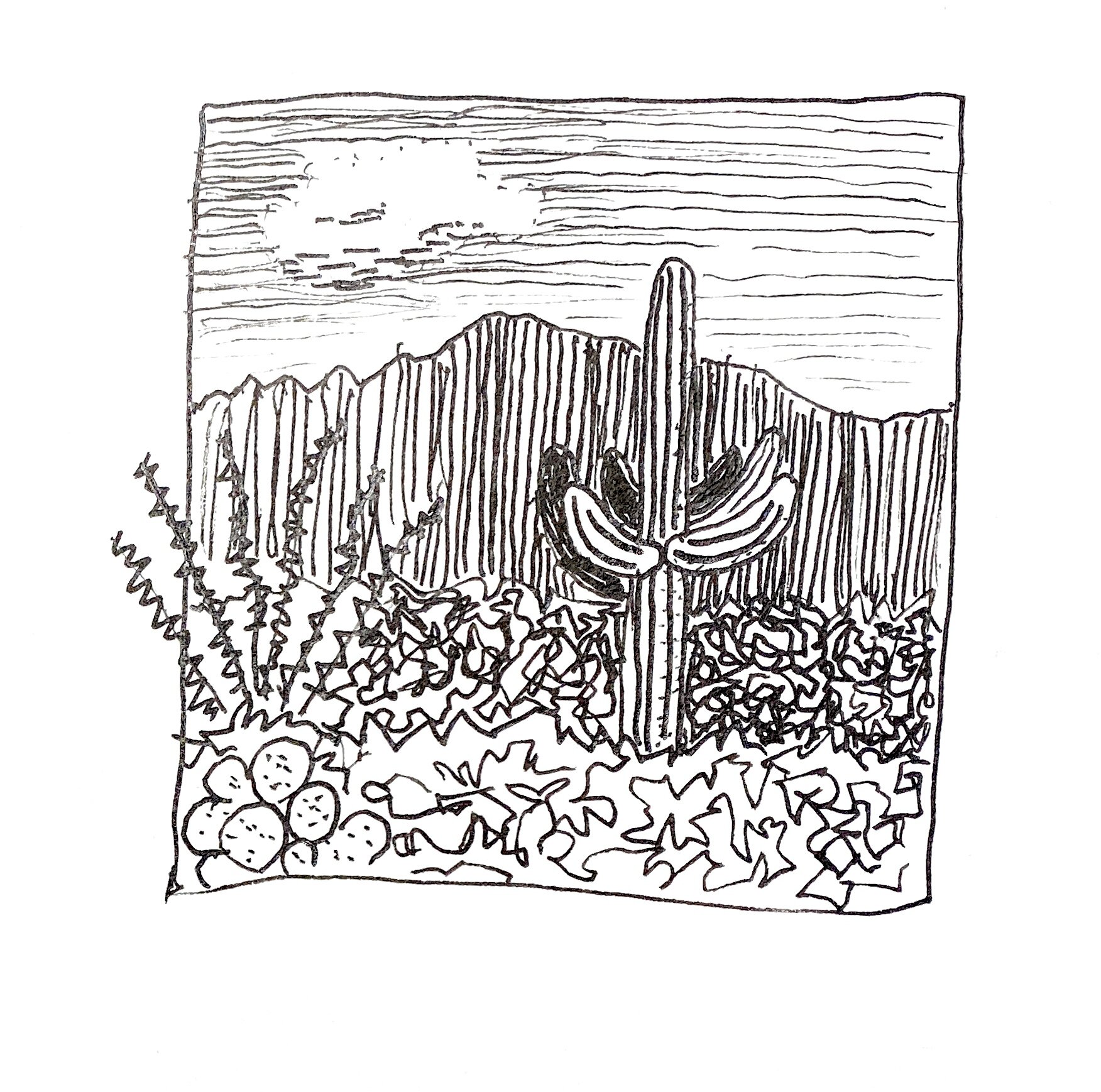

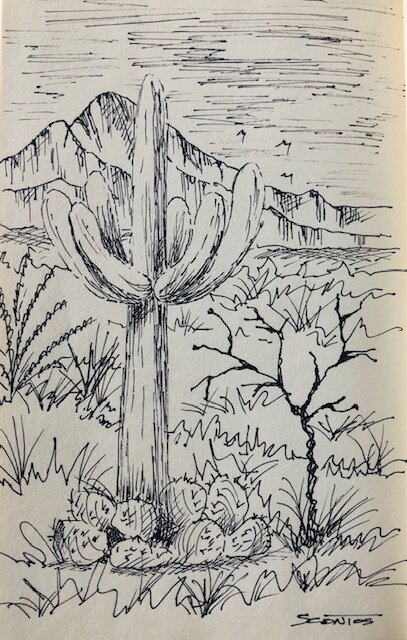
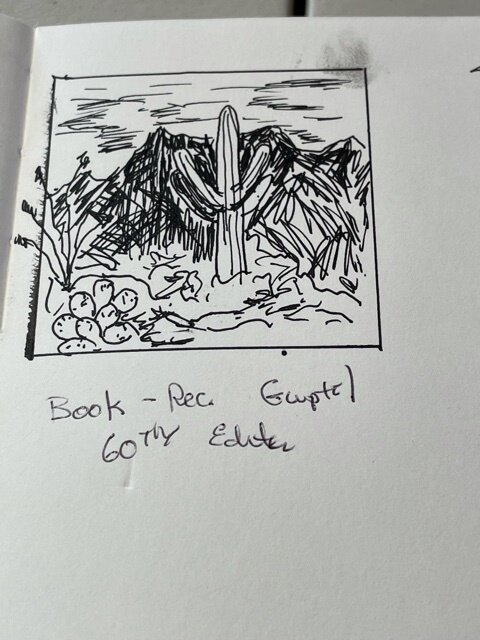
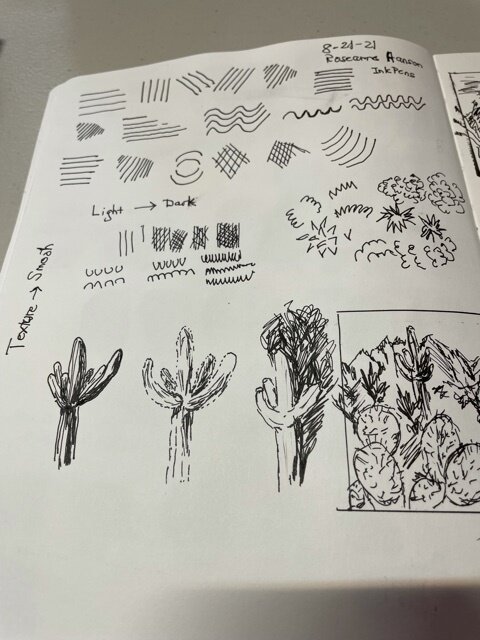
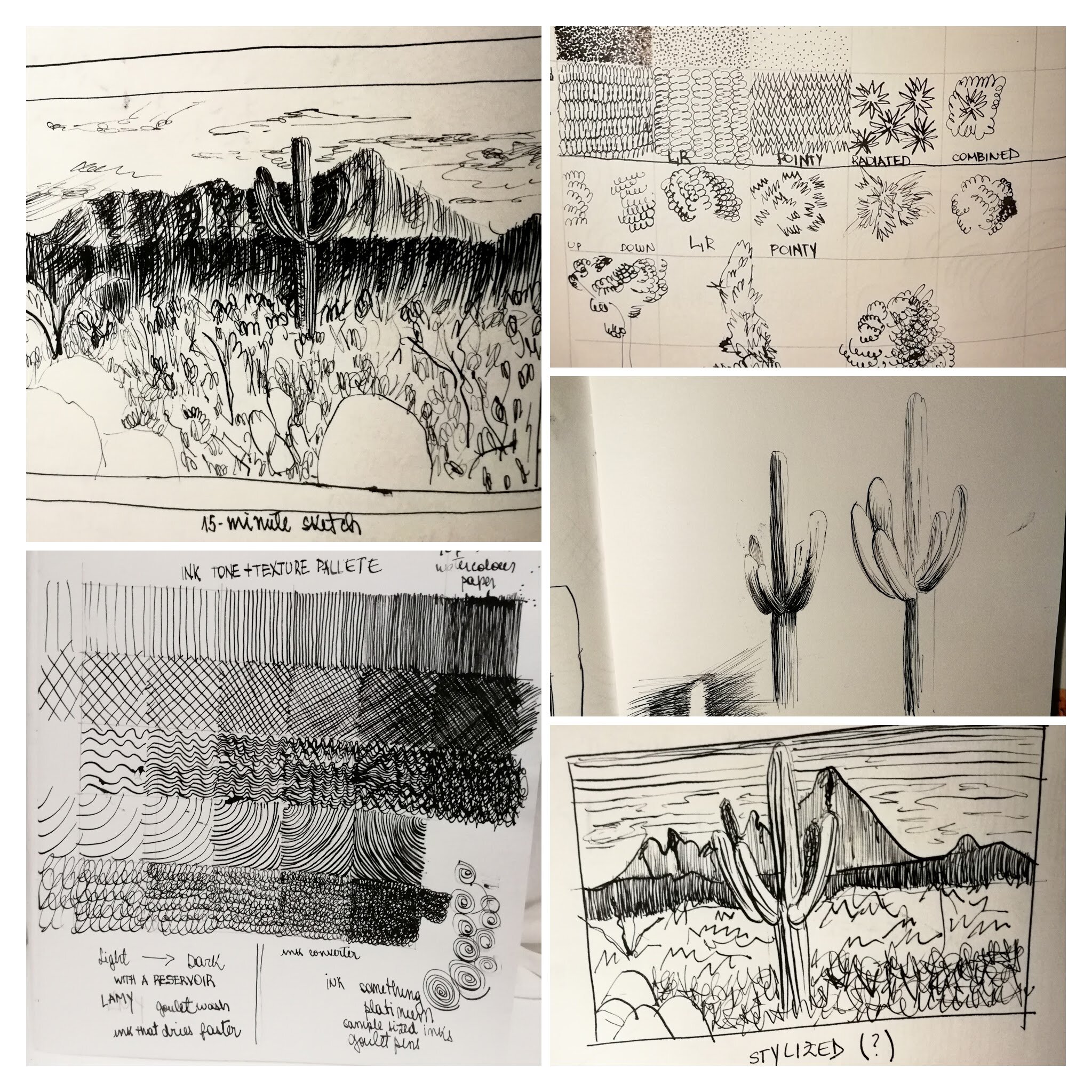
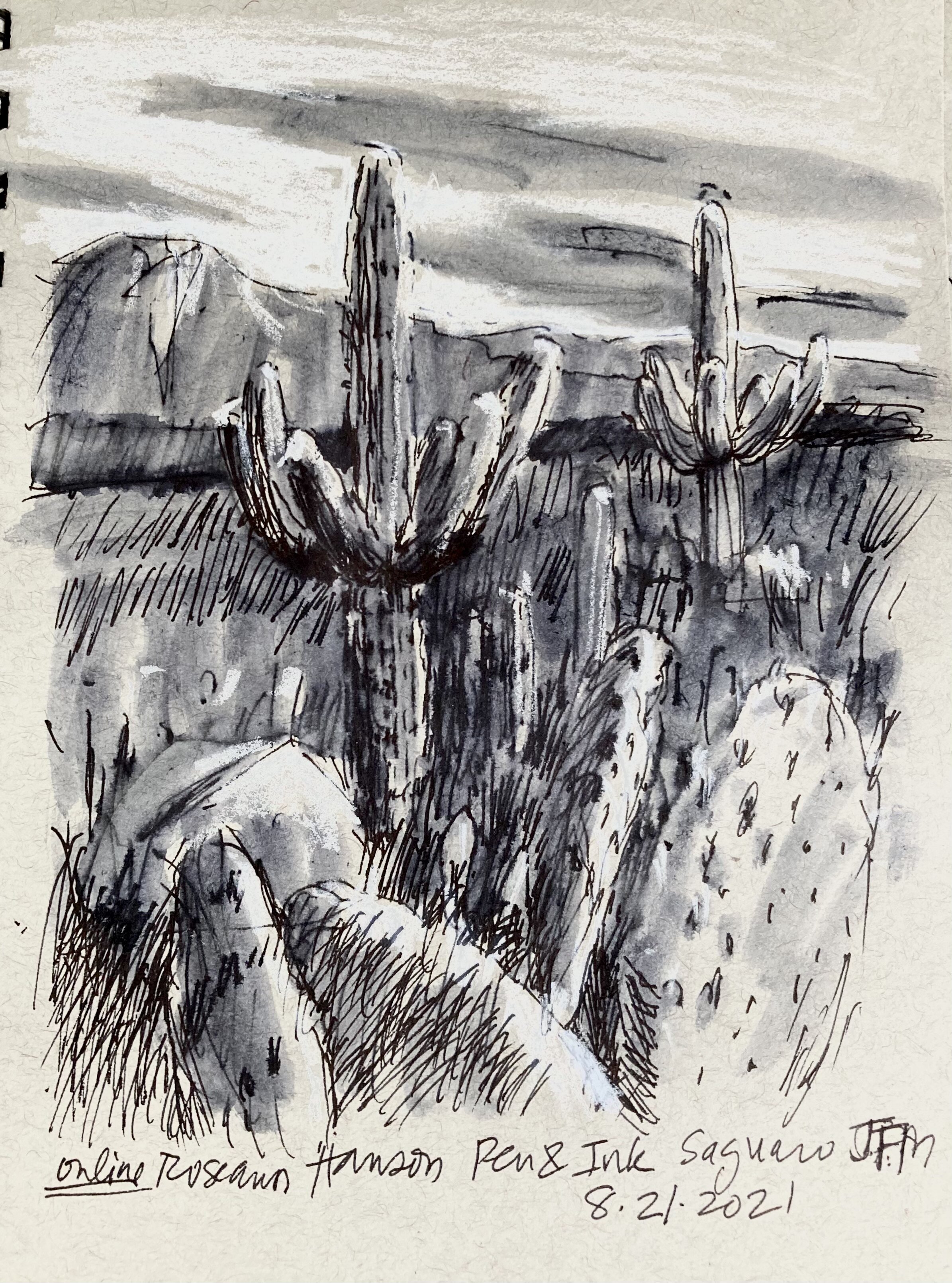
Virtual Field Trip: Winter Wonderlands
Join me on a virtual field trip sketching winter wonderlands around the world! Experiment with different ways to represent snow and ice . . . from the comfort of your warm studio!
We’ll learn about wavelengths and why snow is white and glaciers are blue; explore using blue for shadows in show; practice winter “colorways;” how to represent animal tracks; and sketch some icicles.
Sketch along or just observe, I’ll narrate as I go to demonstrate why I choose to focus on what subjects and how to quickly capture them in your field notebooks and nature journals.
If you’re shy, don’t worry—we don’t require anyone to share their work and you can remain completely anonymous and worry-free!
Length: 2 hours
Resources from the Workshop
WHAT COLORS?
French Ultramarine Blue - granulating, makes lovely grays by mixing with Burnt Sienna. Also makes beautiful snow-shadow and sky colors.
In my mini triad palette Daniel Smith (CMY = cyan, magenta, yellow) plus two extras —
Manganese Blue Hue
Quinacridone Rose
Aureolin Yellow (Cobalt Yellow PY40)
Burnt Sienna
Indanthrone Blue
Other useful colors:
Readymade grays - Payne’s Gray or Jane’s Gray (which is French Ultramarine and Burnt Sienna already mixed).
Fun - Shadow Violet and Moonglow, are more purpley grays.
PRACTICING WINTER COLORWAYS WEBLINKS
Study in Blue, by Scott Kranz Photography:
https://www.scott-kranz.com/landscape-portfolio
Lake Solitude, Grand Tetons, Wyoming:
Kenai Fjords, Alaska:
CANELO HILLS VIRTUAL FIELD TRIP IN 360-DEGREE VIEW:
https://360exploring.s3-us-west-1.amazonaws.com/WinterWonderland/output/index.html
METADATA AND NATURE DATA for CANELO HILLS, SOUTHEASTERN ARIZONA, USA:
31.557 degrees N
110.55 degrees W
5,182 feet
Sunrise 7:12AM / Sunset 6:02PM
Moonrise 2:42AM / Moonset 1:12PM
High 65 / Low 37
Clouds: Altocumulus “mackerel” sky
Original pages by Roseann, completed onsite during the real field trip in January.
Virtual Field Trip Pages by Roseann
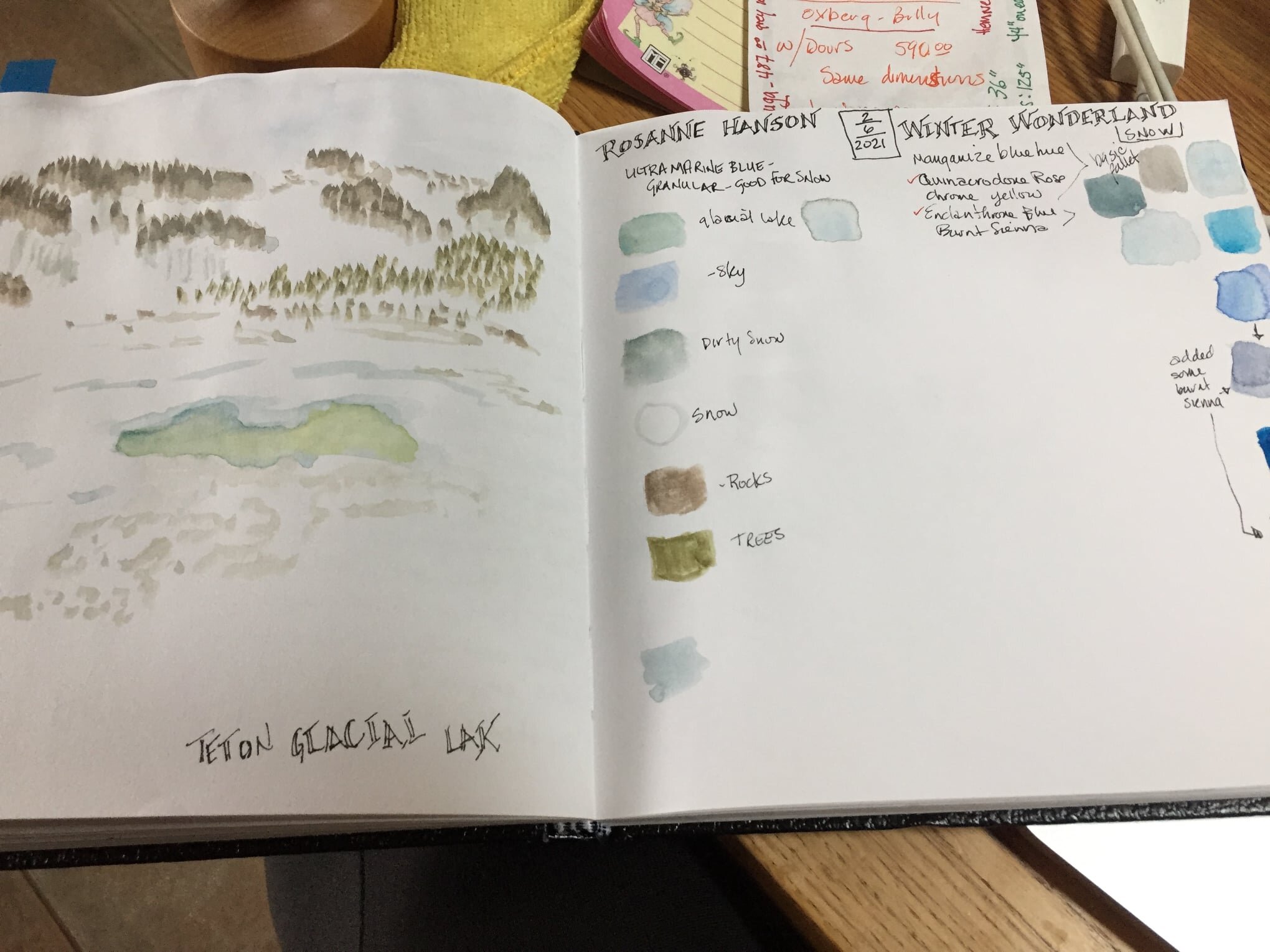
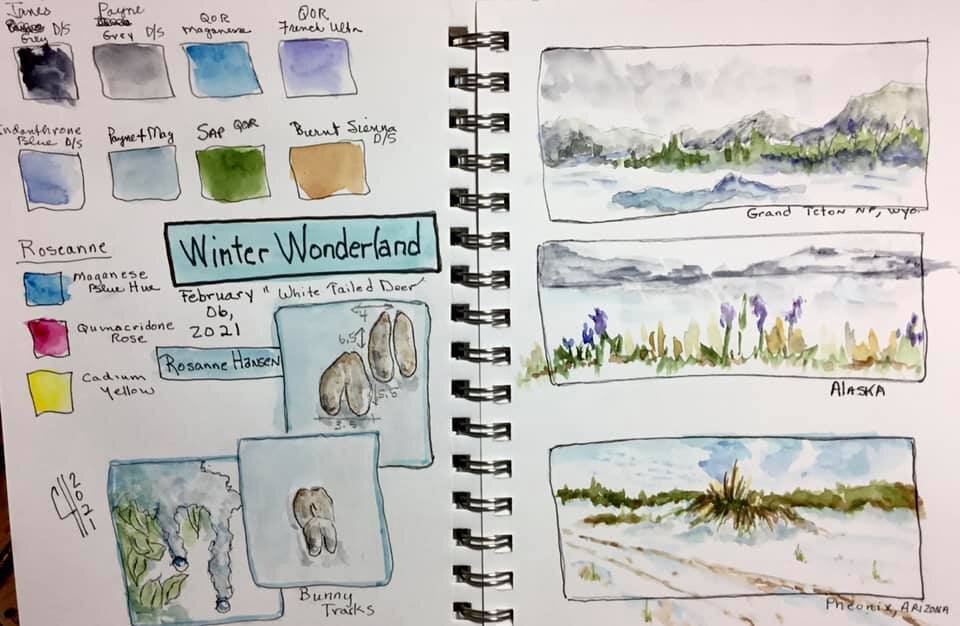
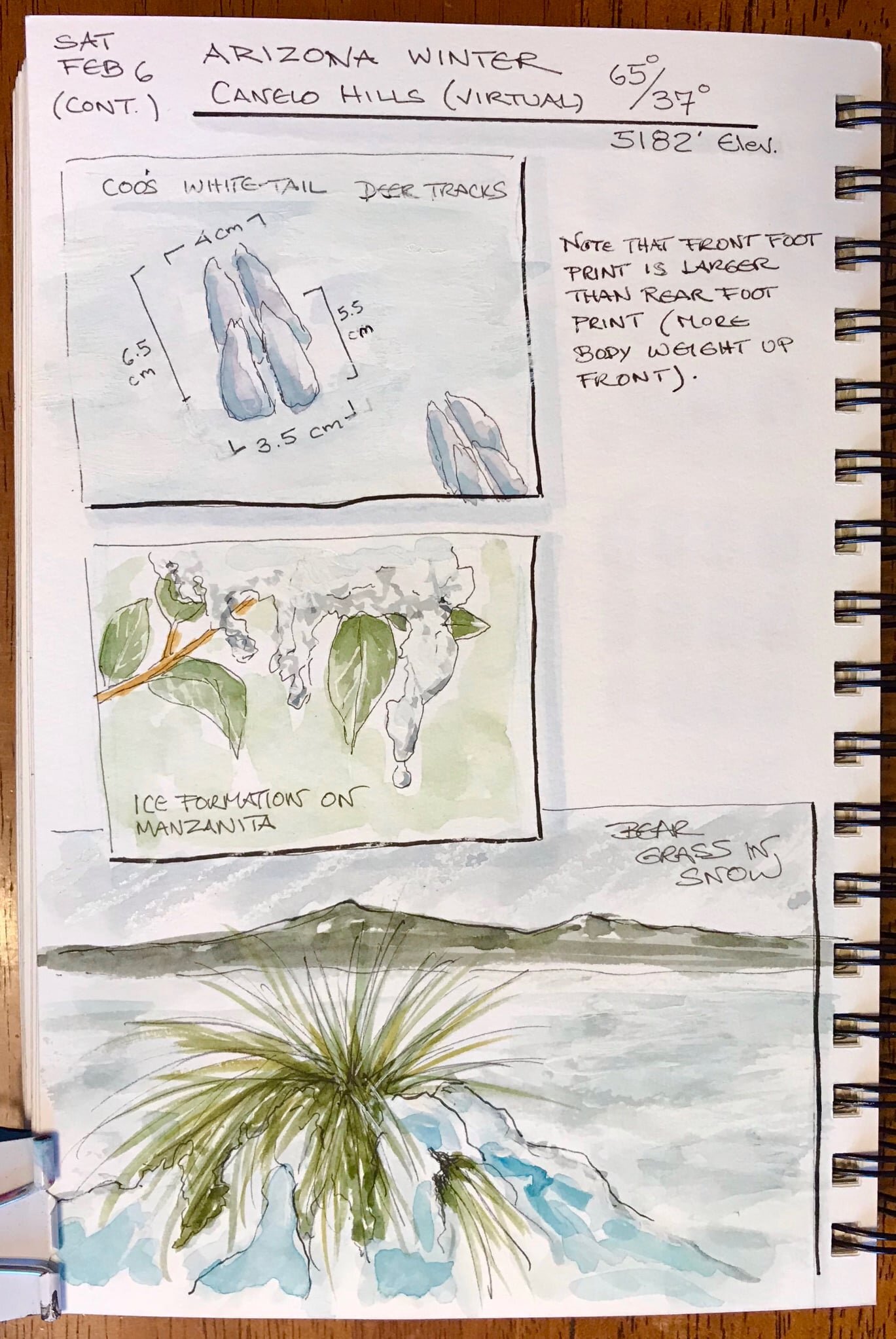
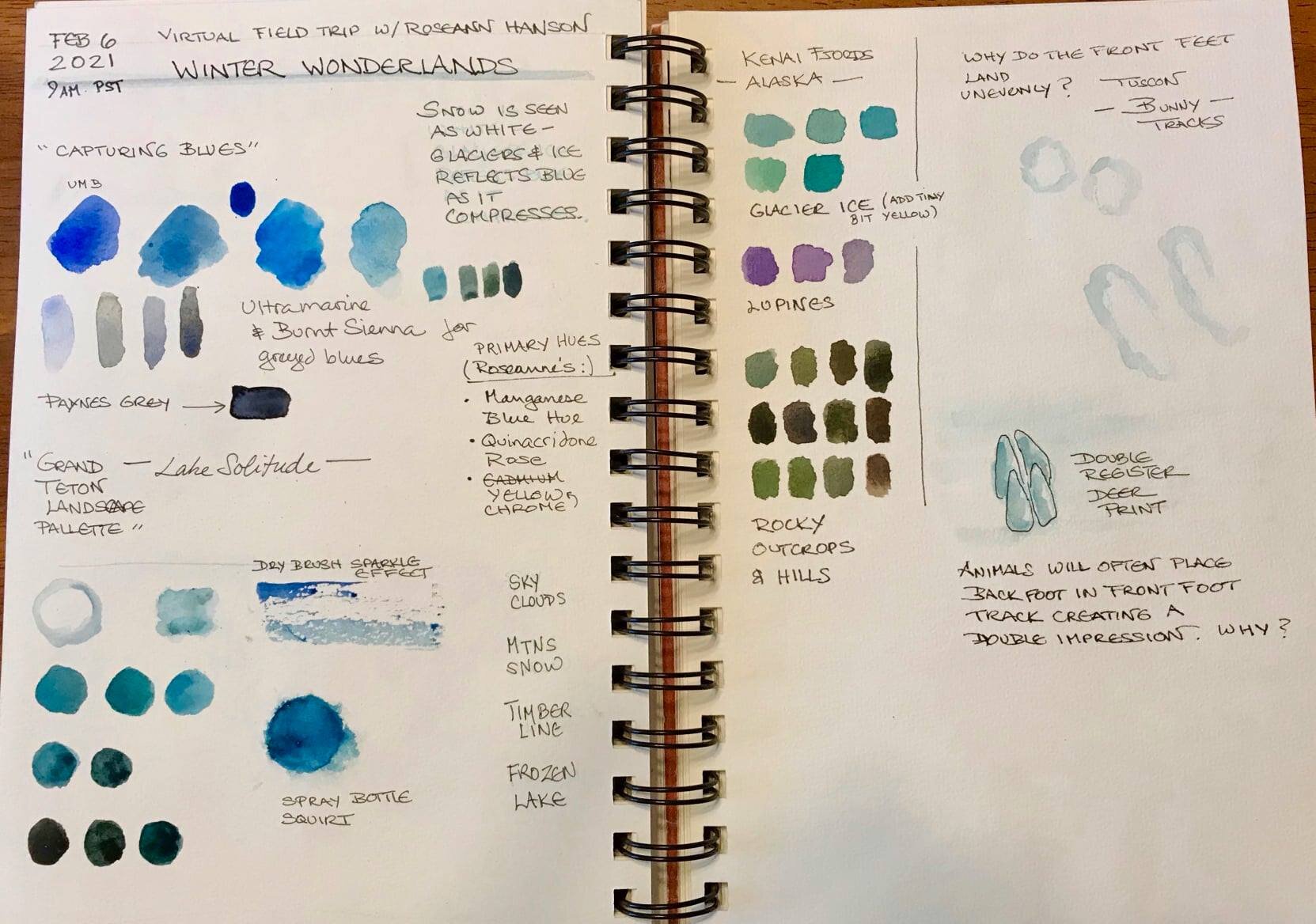
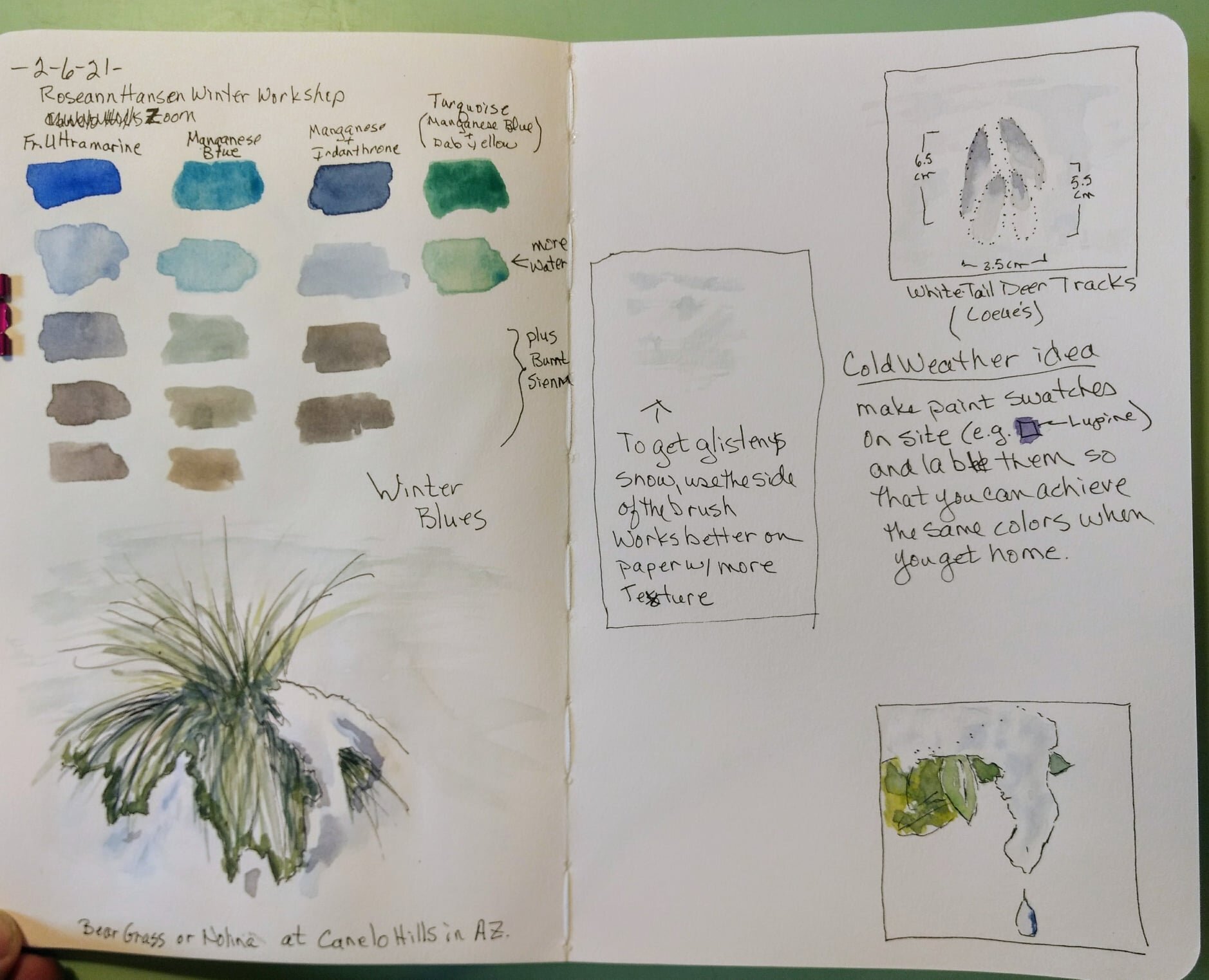
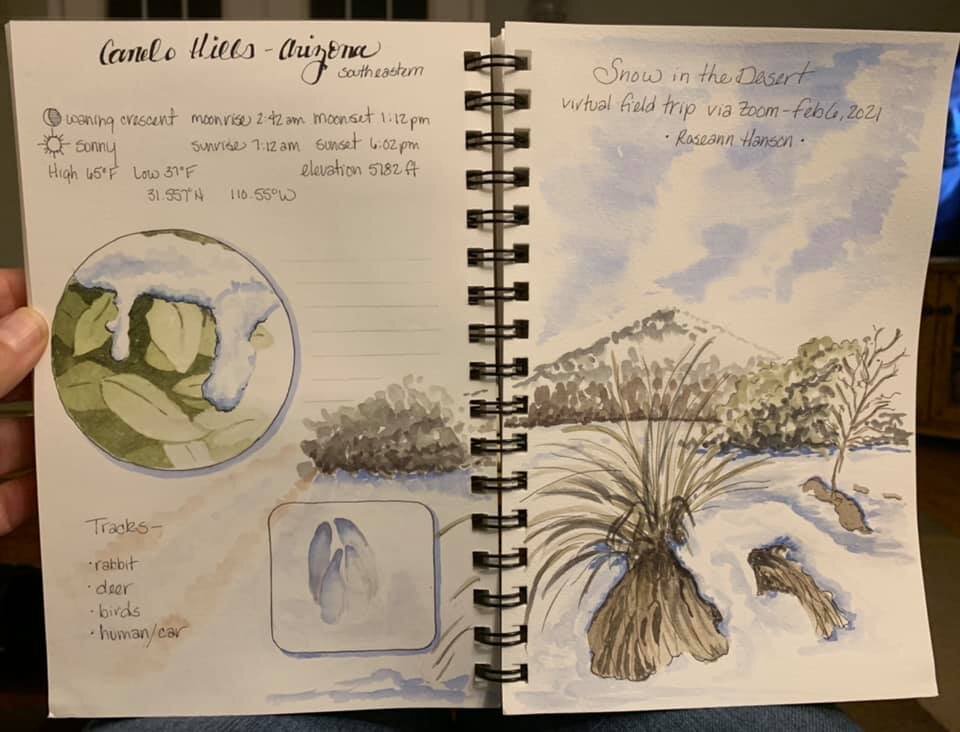
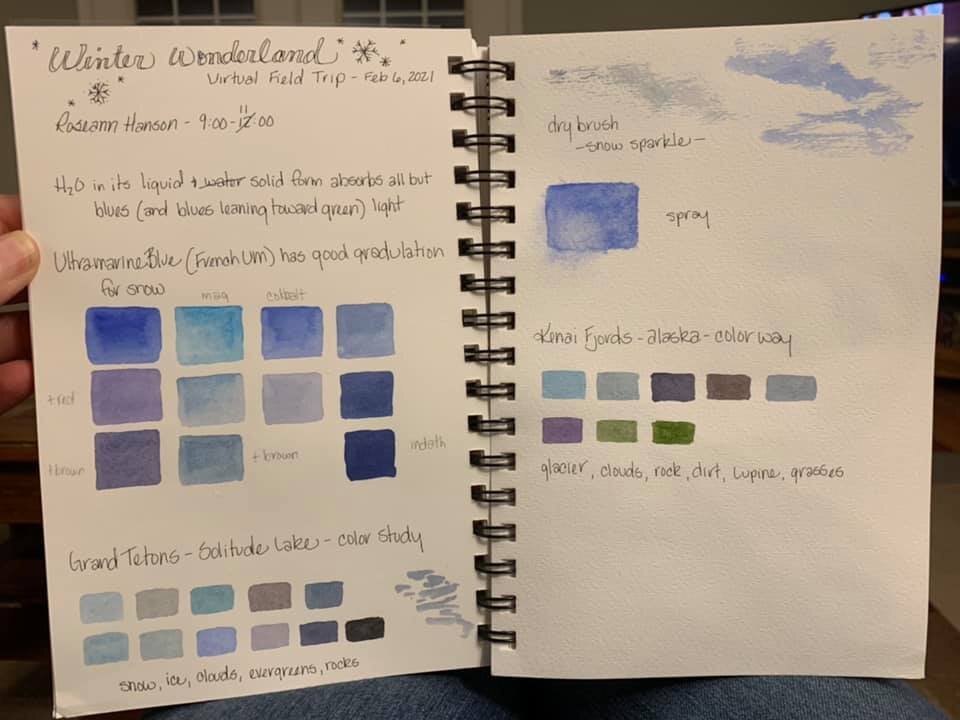
Support free tutorials! Click to contribute to the Tip Jar!
Using Grids: 3D cube landscapes and more
Join me for a free online workshop on how to draw “3-D” landscape cubes — in which you envision taking a giant cutter and pulling a cube out of a landscape, showing the sliced edges and details such as soil and creeks and roots (see here and here for examples). John Muir Laws details them in his wonderful book The Laws Guide to Nature Drawing and Journaling.
These are not easy to do— I struggled with these complex drawings “live” in the field. Where to place the cube, how to envision placing the elements correctly. I always drew mine from photos, then actually printed them and sketched the cube over the photo, or used Photoshop to put a cube over the digital photo.
But with a fun new tool ( the new clear Perspex Palette-Easel ) I will show you how to easily capture a very fun view of a landscape. Make your own (I’ll include instructions), or order one from my shop ($13 with a dry-erase marker or $12 without).
Length: 2 hours
Resources from the Workshop
IMAGE FOR PRACTICE DRAWING GRID LANDSCAPITO
IMAGE FOR PRACTICE-DRAWING CUBE LANDSCAPE
METADATA AND NATURE DATA for ROMERO POOLS, SANTA CATALINA MOUNTAINS, TUCSON, ARIZONA, USA:
32.414359 N, -110.872213 W
3713 feet elevation
Sunrise 0722 am
Sunset 0529 pm
Moonrise 0136 pm
Moonset 0258 am
Moonphase 75% illumination / waxing
High / Low temperatures - High 63/ Low 45 (degrees F)

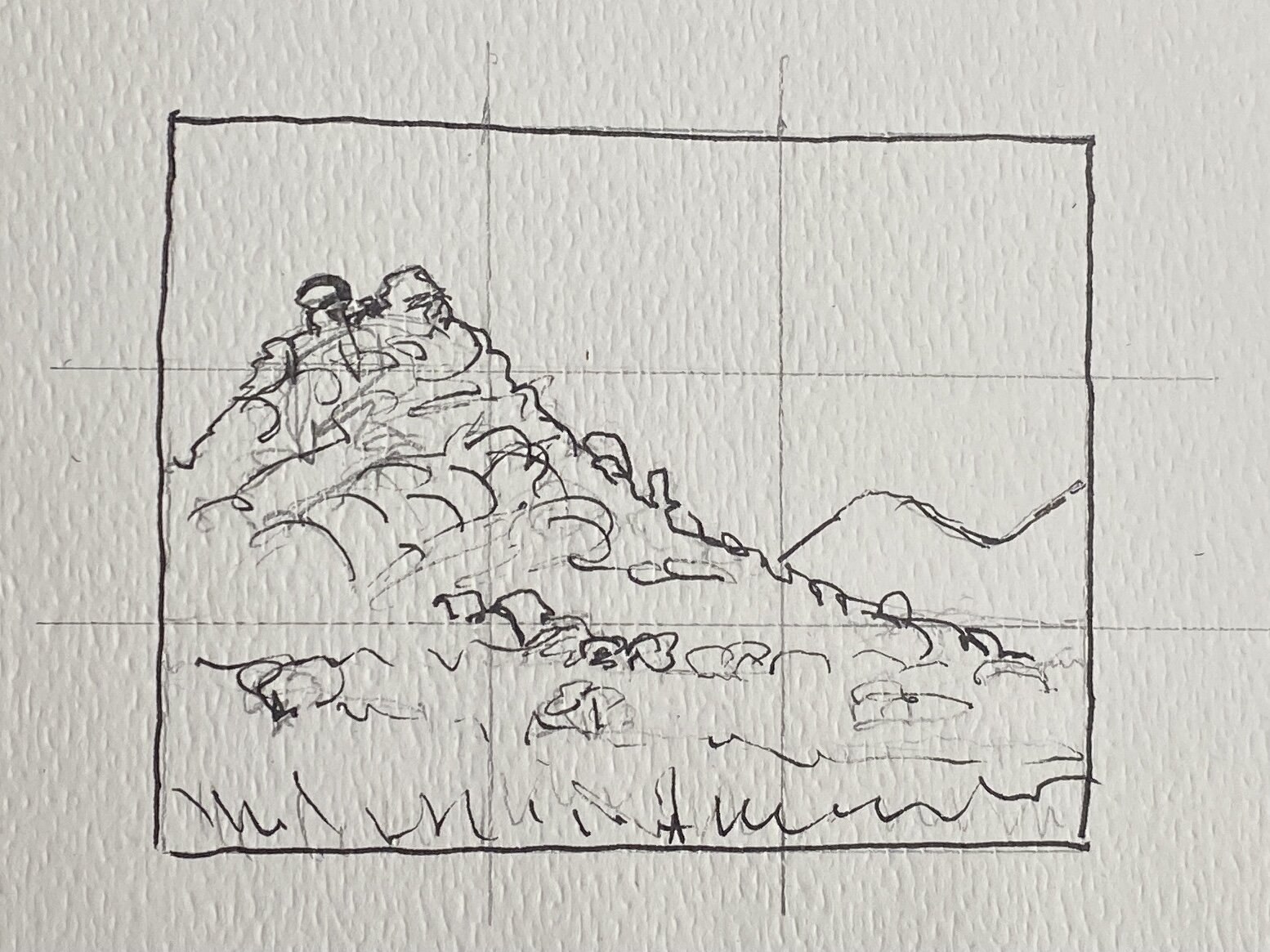
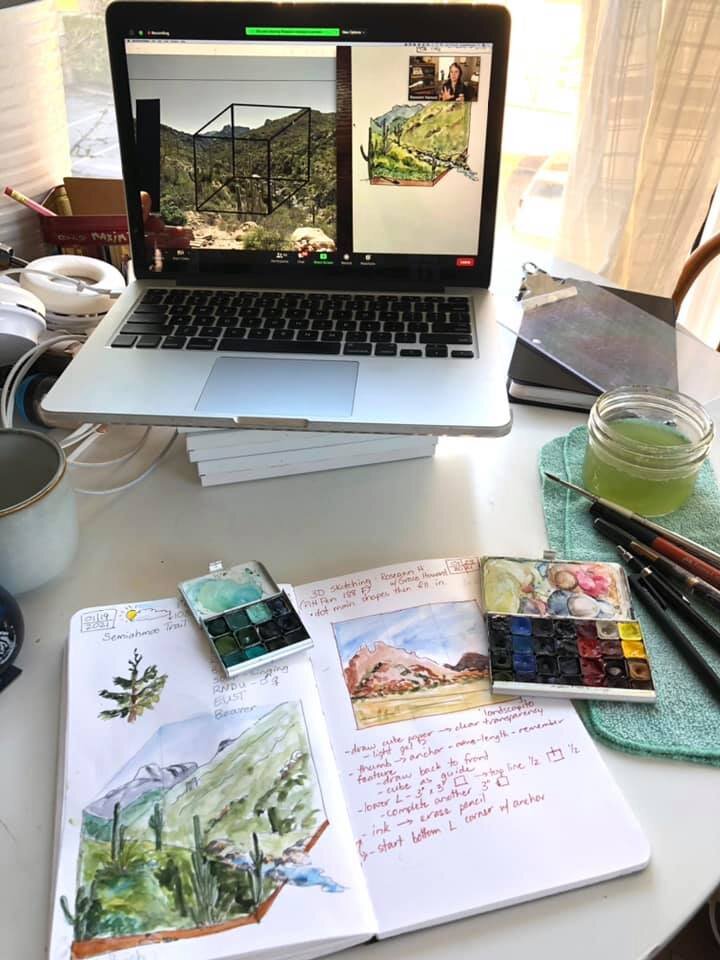
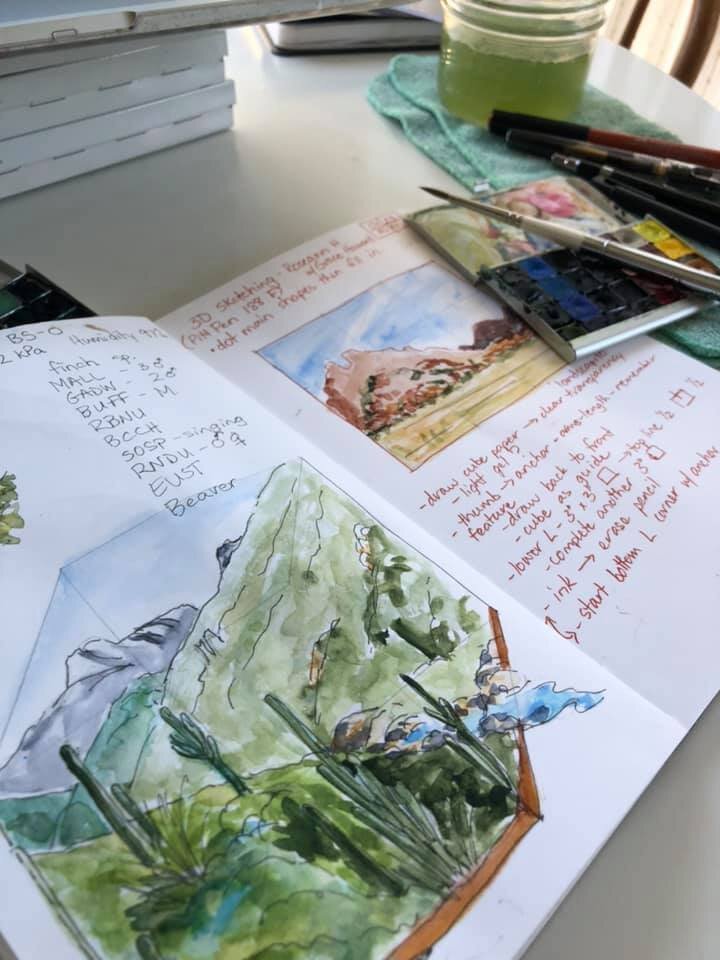
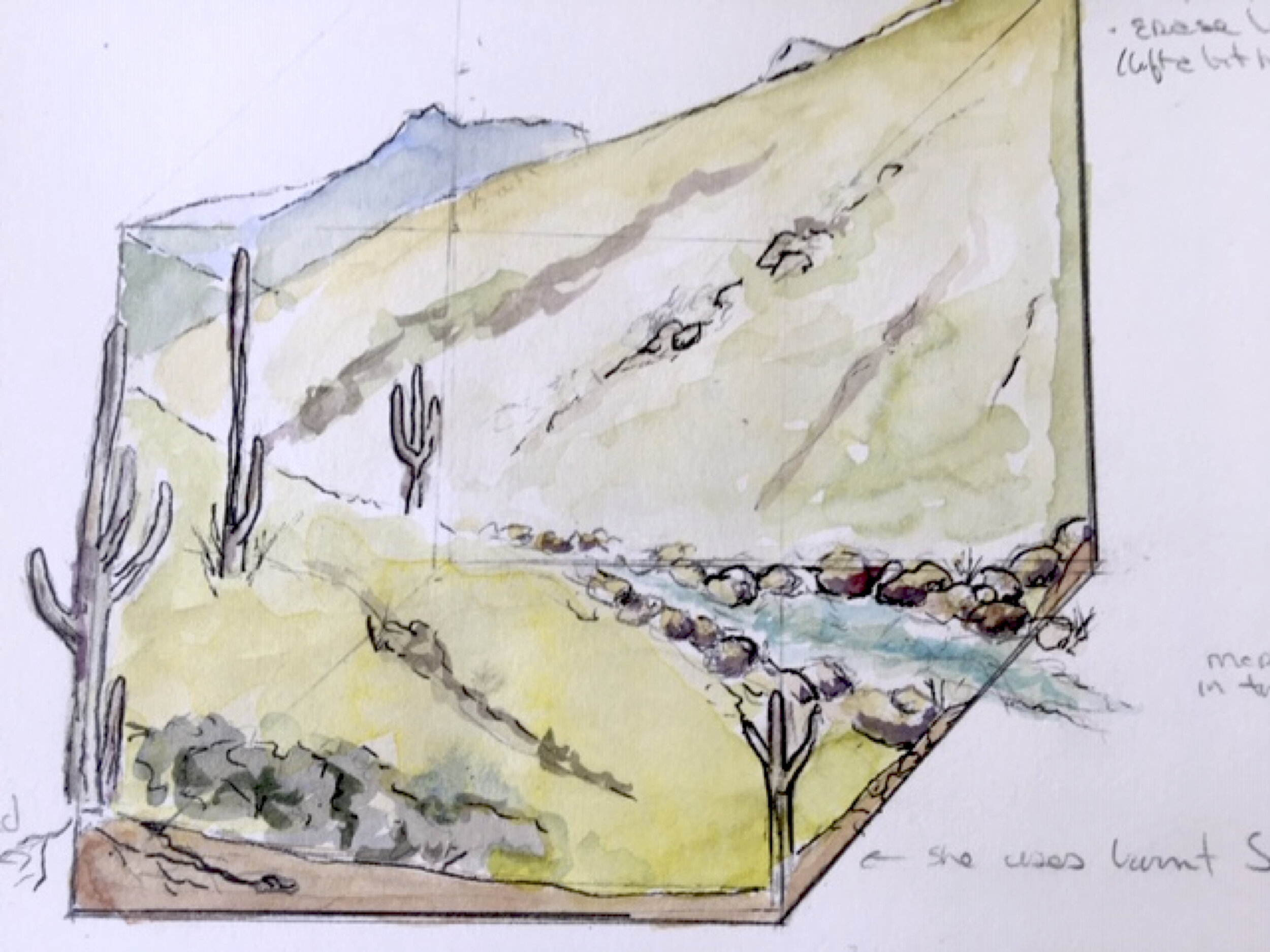
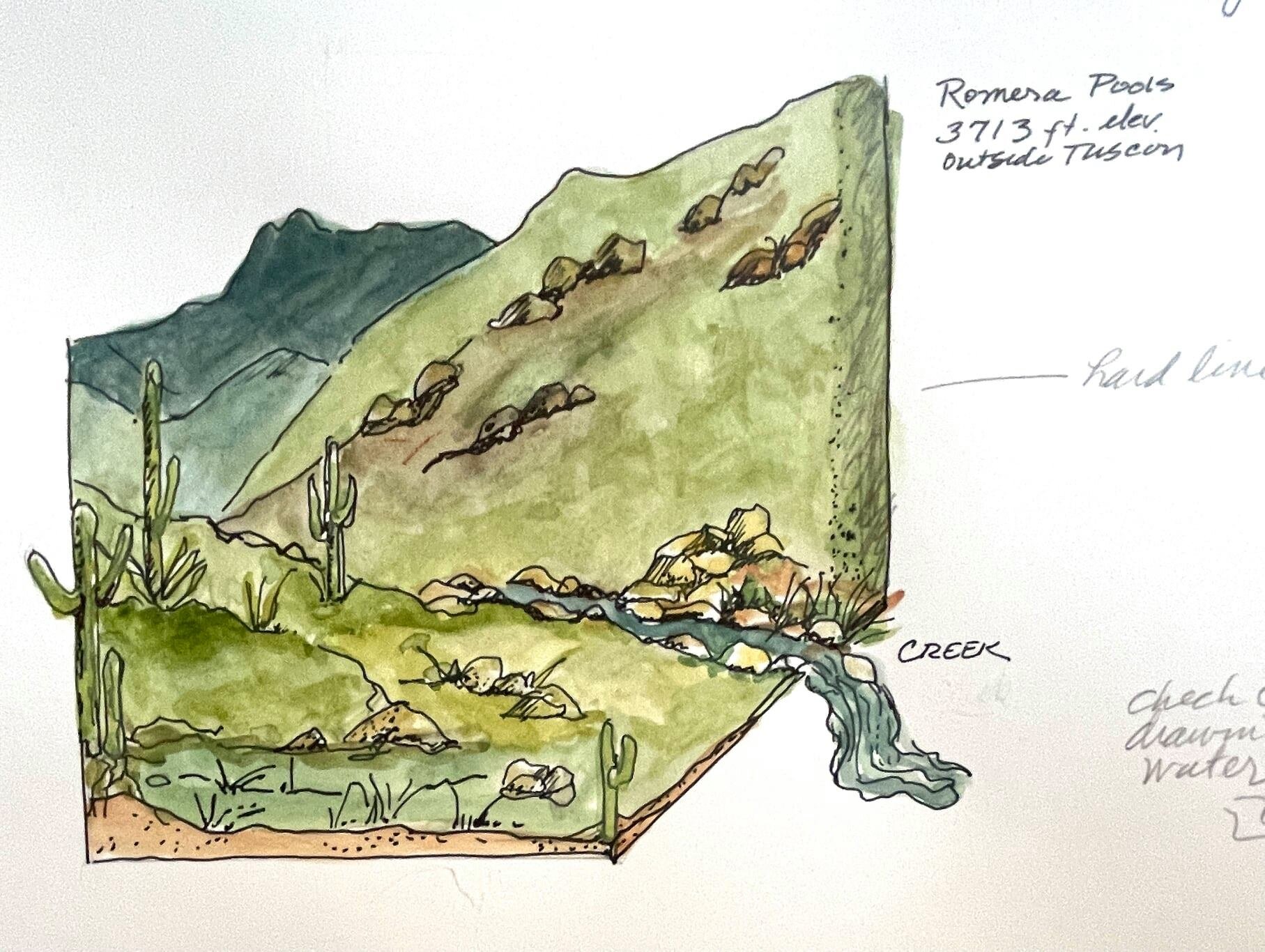


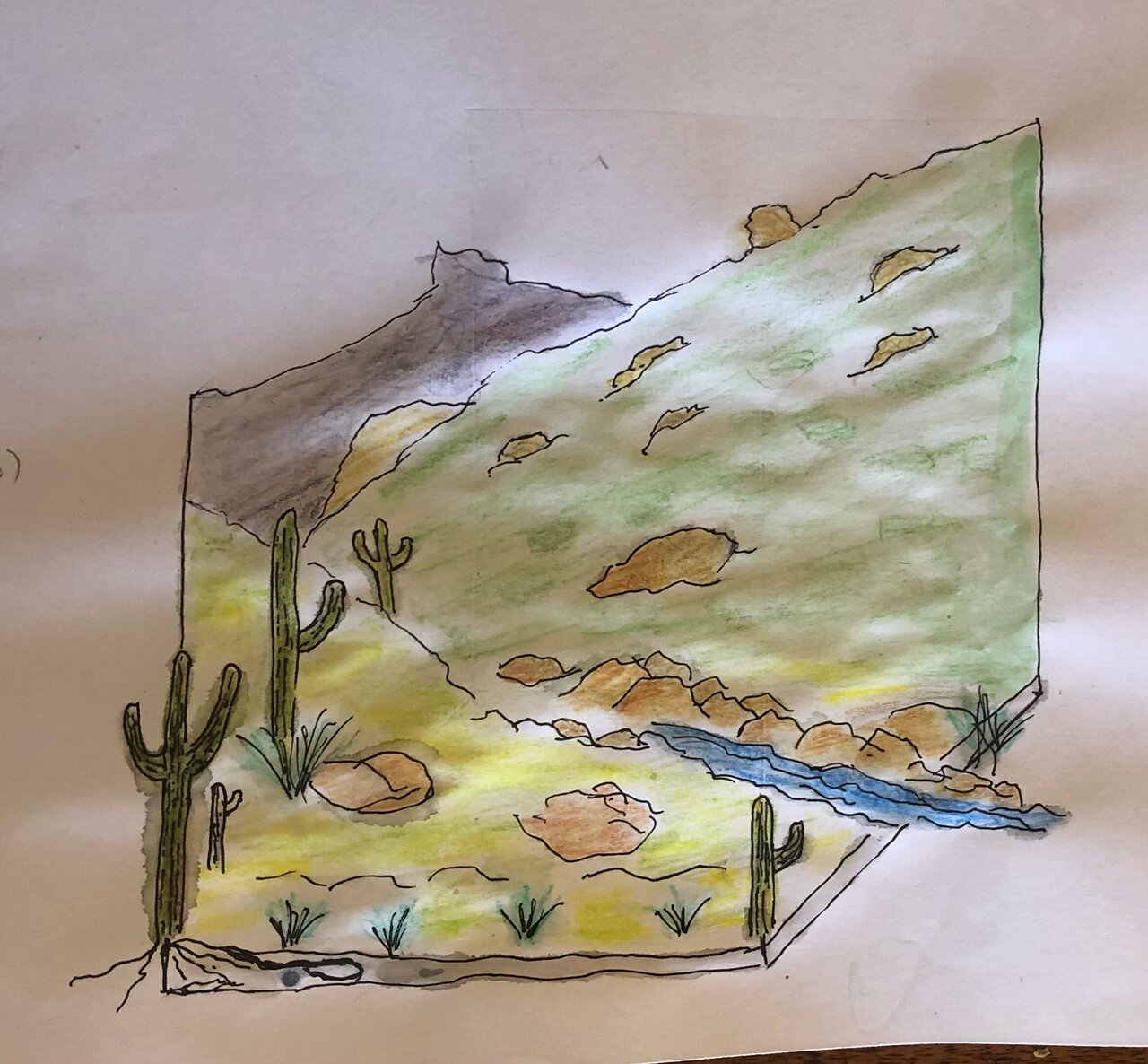
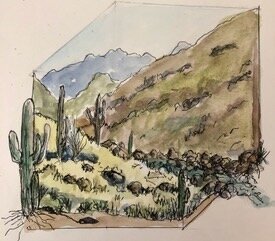
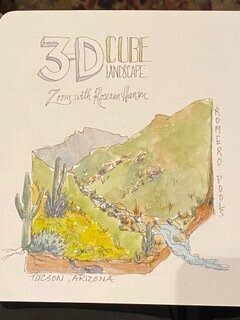
Support free tutorials! Click to contribute to the Tip Jar!
Virtual Field Trip: Mountains and Mesas
Join me on a virtual field trip from Moab, Utah, to Aspen, Colorado, all along backcountry roads through some of North America’s most spectacular scenery as the colors begin turning fiery yellow and red.
Sketch along or just observe, I’ll narrate as I go to demonstrate why I choose to focus on what subjects and how to quickly capture them in your field notebooks and nature journals.
Here is the link to my special Virtual Field Trip experience online so you can explore on your own, at your own pace; click on the “i” icon at the beginning of the “tour” so you can get the instructions on accessing the images and videos (the only scene I sketched that isn’t on the tour is the Gunnison River, which I included below):
https://360exploring.s3-us-west-1.amazonaws.com/Mountains-Mesas-2020/output/index.html
Resources from the Workshop
METADATA AND NATURE DATA:
Gunnison River fall scene.
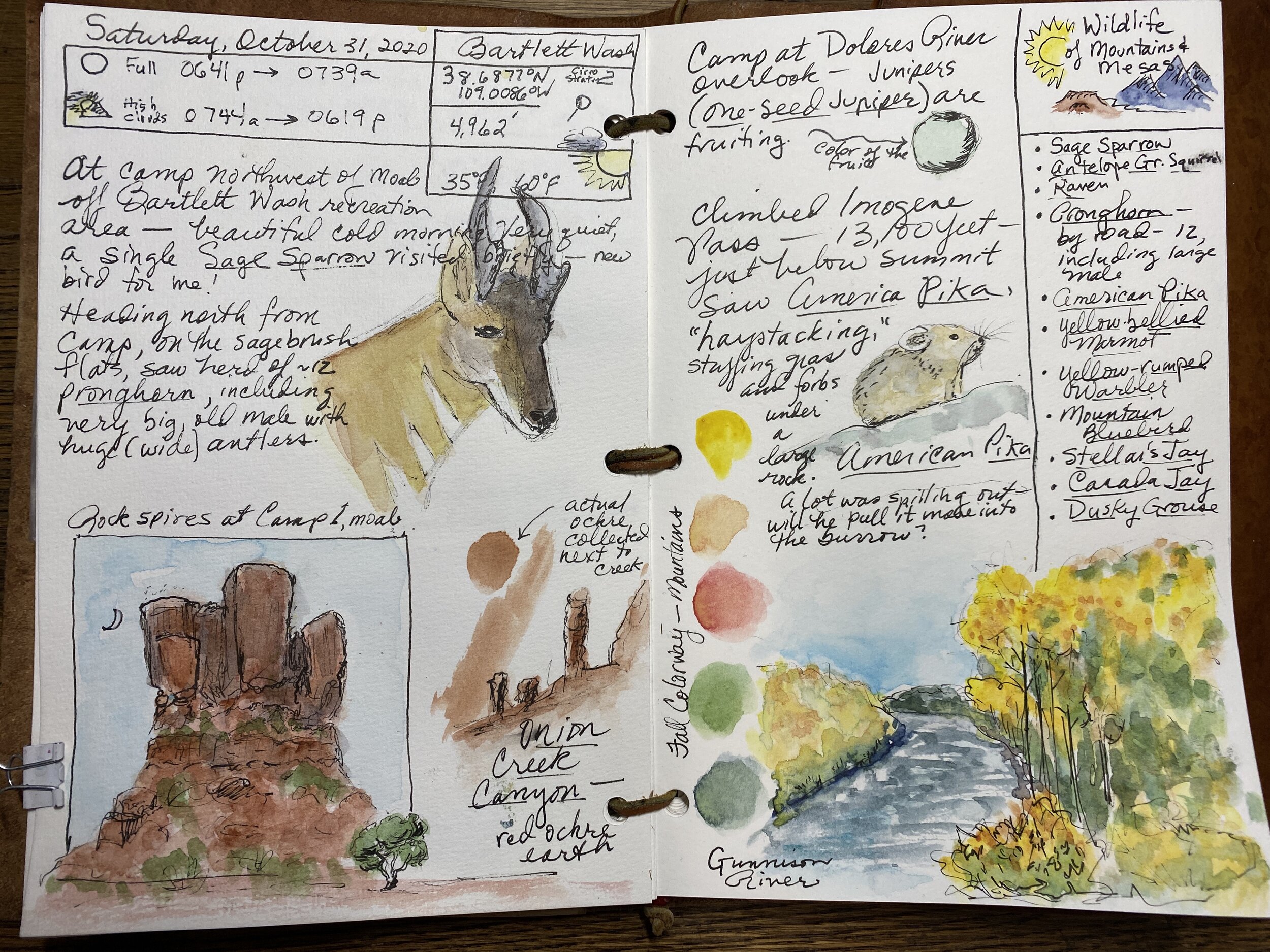
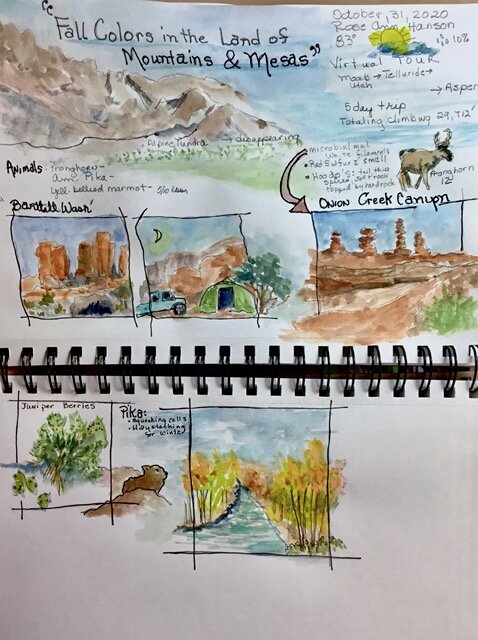
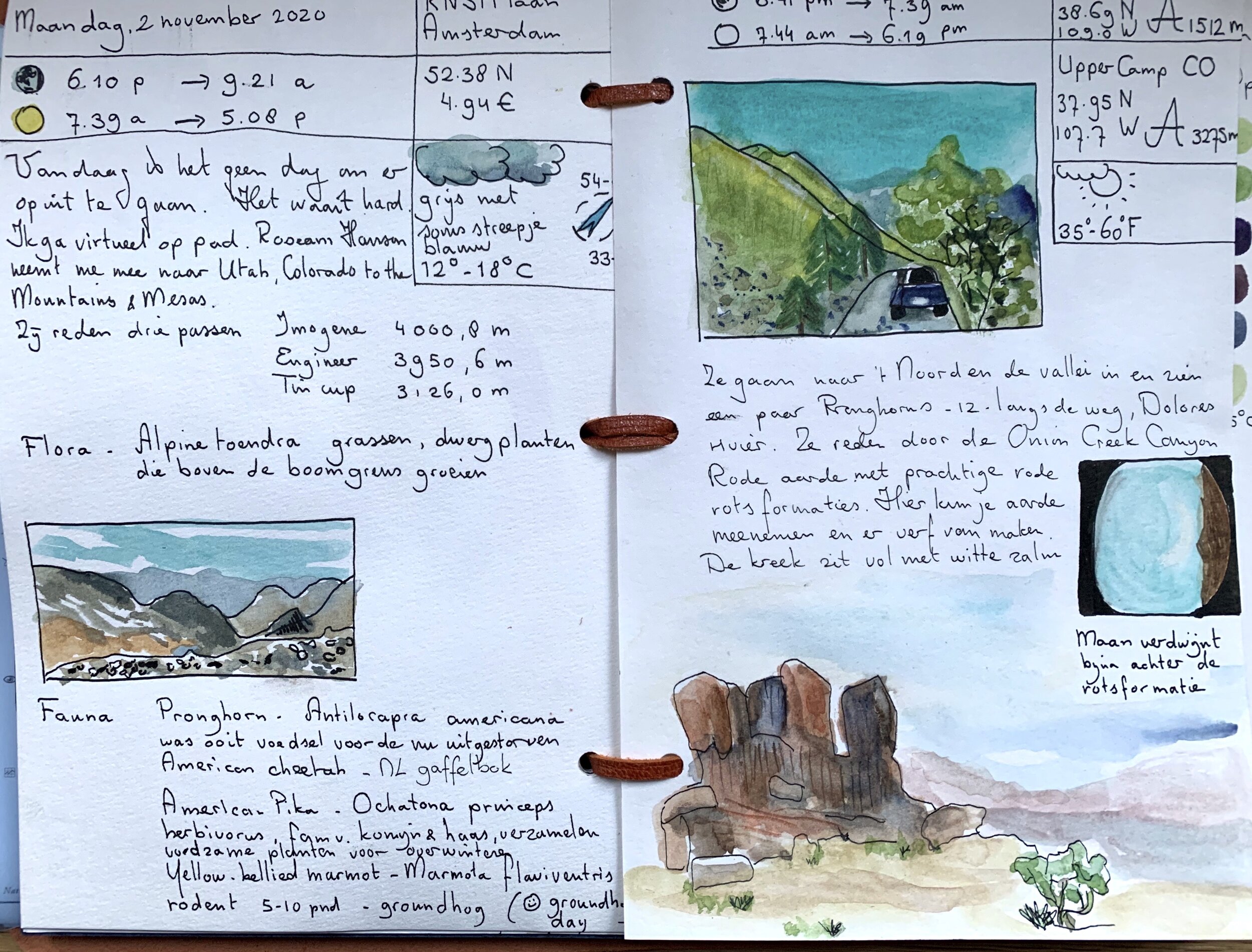
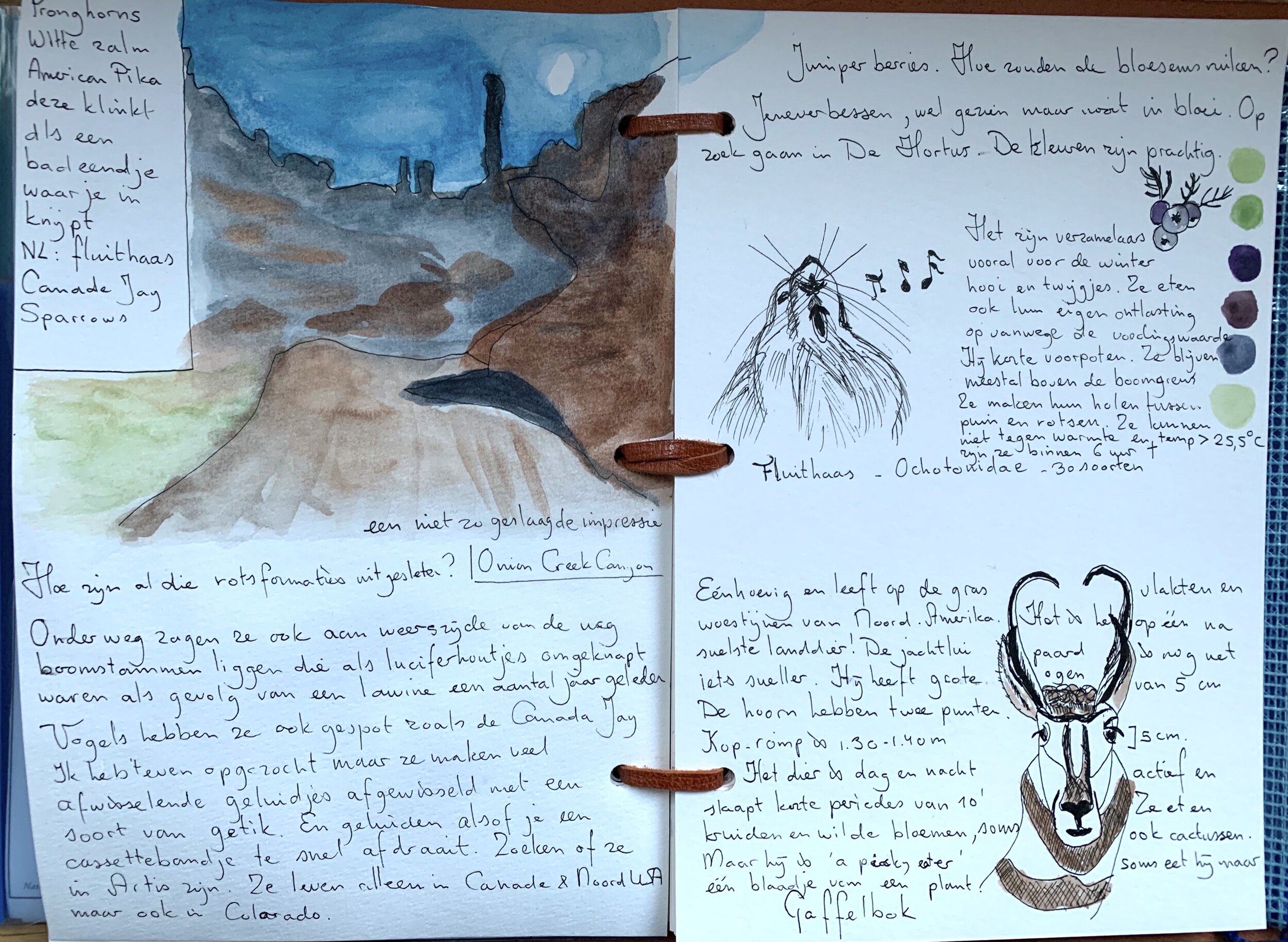
Support free tutorials! Click to contribute to the Tip Jar!
Virtual Field Trip: Monarchs & Milkweeds Micro Safari
Join me on a new kind of exploration—a micro safari! You don’t have to go far to discover wonderful things. We’ll hunker down in a field of milkweed and observe, learn about, and sketch monarchs, as well as many other insects. BONUS: If we have time we might just scoot down to Mexico to observe winter monarch habitat as well. (EDITING NOTE: We had to blur-out some of video at the end; I didn’t have permission to use the PBS / BBC footage even for a free education clip! Sorry about that! You can see the video clip in the link below.)
Footage in the explorations is from: Yosemite Nature Notes; Dominique Lalond Nature Films on YouTube; PBS Nature.
Roseann’s pages from the demonstrations in the workshop.
I mostly use a limited palette of five transparent watercolors (all Daniel Smith): aerolin yellow; quinacridone rose; manganese blue; burn Sienna; indanthrone blue). For the iridescent beetle, though, I followed John Muir Laws’ tutorial in his book The Laws Guide to Nature Drawing and Journaling, and first laid down a pthalo green and a little bit of pthalo blue, then added the darks with blue-black mixed with ultramarine blue and burn Sienna, which lifts off easily. The pthalos are very staining so are good to use if you are lifting color from on top of them.
Resources from the Workshop
Metadata and Nature data:
IMAGES FROM EACH STOP (CLICK TO ENLARGE; RIGHT-CLICK TO DOWNLOAD):
Workshop Attendees’ Pages
Virtual Field Trip: Unique Grasslands of the World
Join me as we explore three of the world’s grasslands—Australia’s Southern Tablelands in New South Wales, Brazil’s Cerrado, and Alberta’s Southern Prairies—to observe, take notes on, and sketch some well-known animals as well as some lesser-known and fascinating creatures! Sketch along or just observe, I’ll narrate as I go to demonstrate why I choose to focus on what subjects and how to quickly capture them in your field notebooks and nature journals.
Resources from the Workshop
Metadata and Nature data:
Images from each stop (click to enlarge; right-click to download):
Virtual Field Trip: Safari to Botswana
Join me as we head to Botswana for a special virtual safari!
We’ll explore, sketch, and take notes on elephants and their behavior, all virtually.
If you haven't started adding sketches to your field journals yet, don't worry—this session is going to focus on observational skills and recording data in the field. I might do a sketch or two, but definitely demonstrate survey counts and behavior tallies. Or just sit back and enjoy watching elephant antics. If you’re shy, don’t worry—we don’t require anyone to share their work and you can remain completely anonymous and worry-free!
RESOURCES FROM THIS VIRTUAL FIELD TRIP:
Practice identifying three basic age groups by learning to sketch them, thus learning their key features.
ON ELEPHANT BIOLOGY:
This article has a cool diagram of the bones of the foot (h/t Olivia C.):
http://elephant.elehost.com/About_Elephants/Anatomy/The_Feet/the_feet.html
PARTICIPANTS’ PAGES:
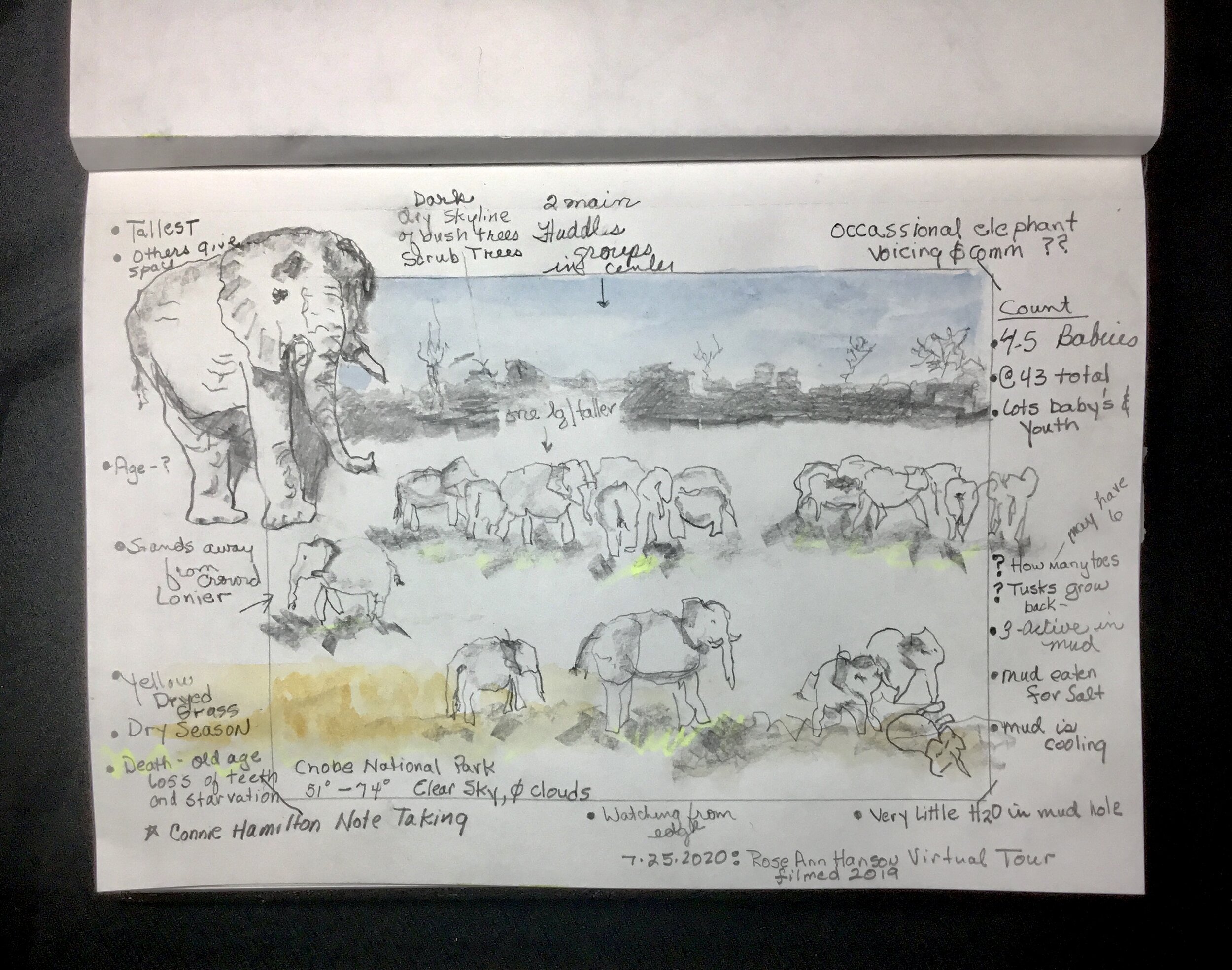
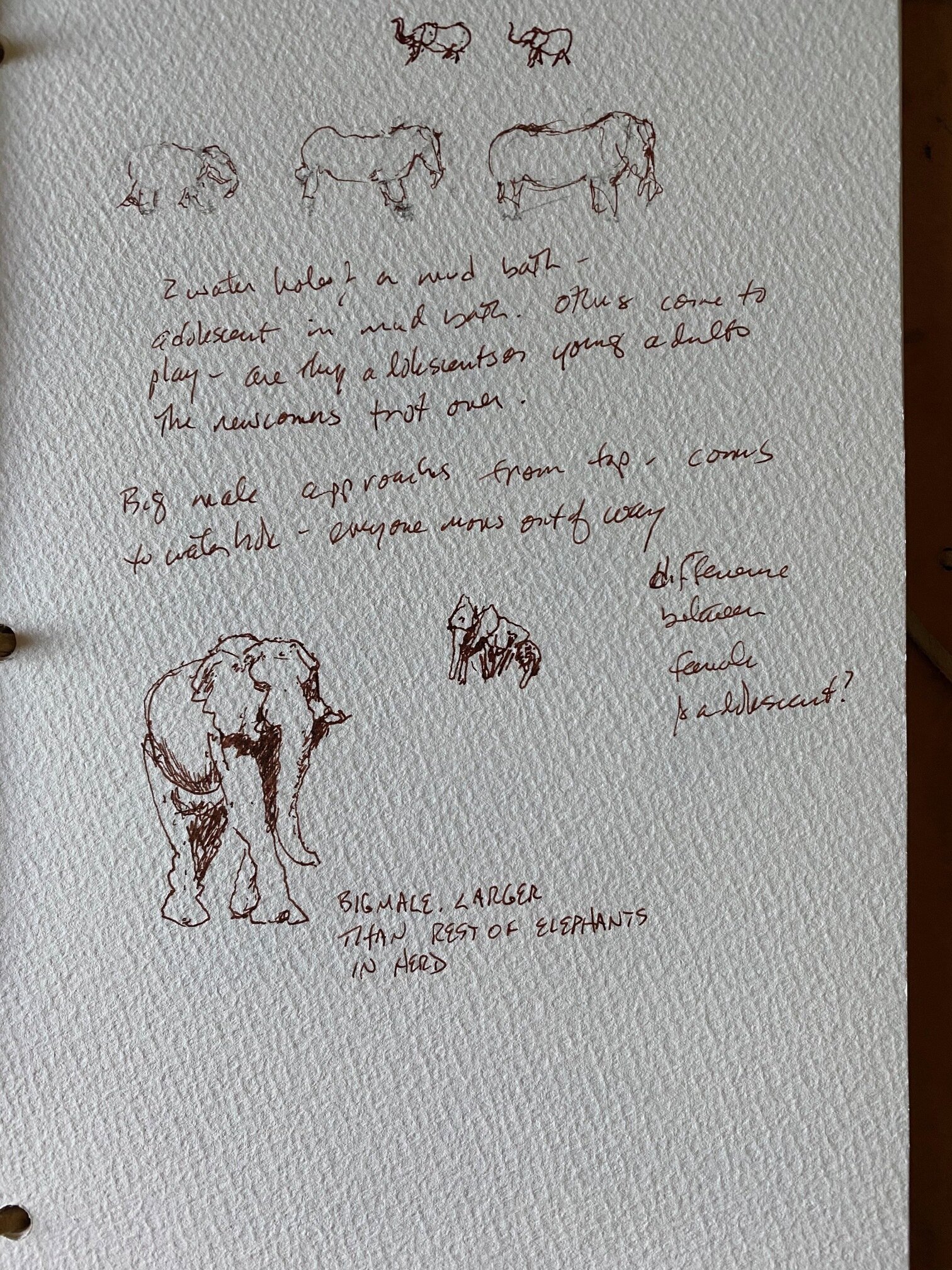
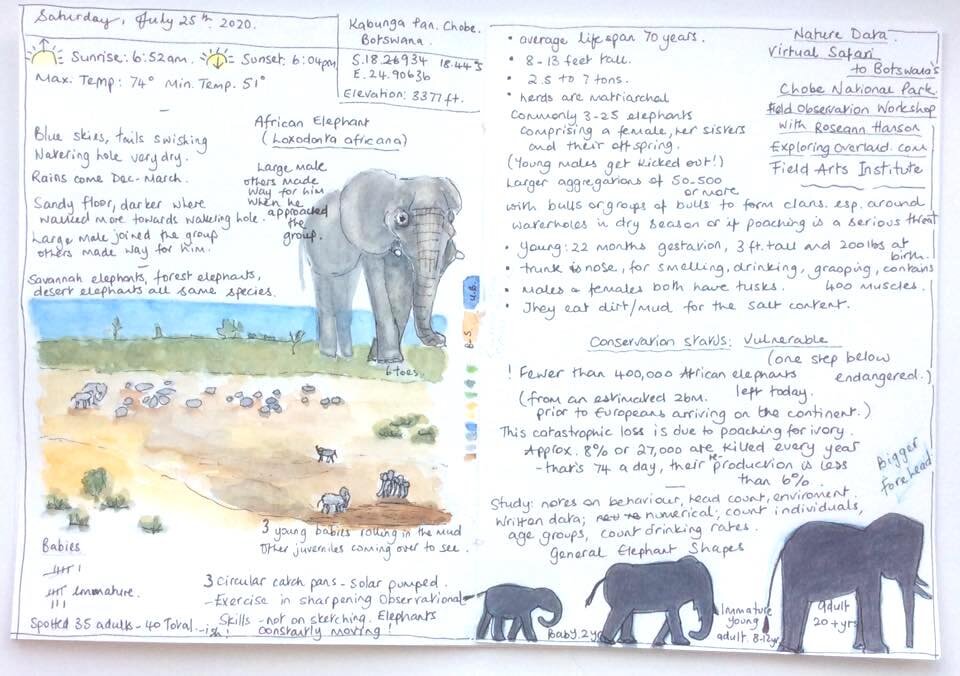
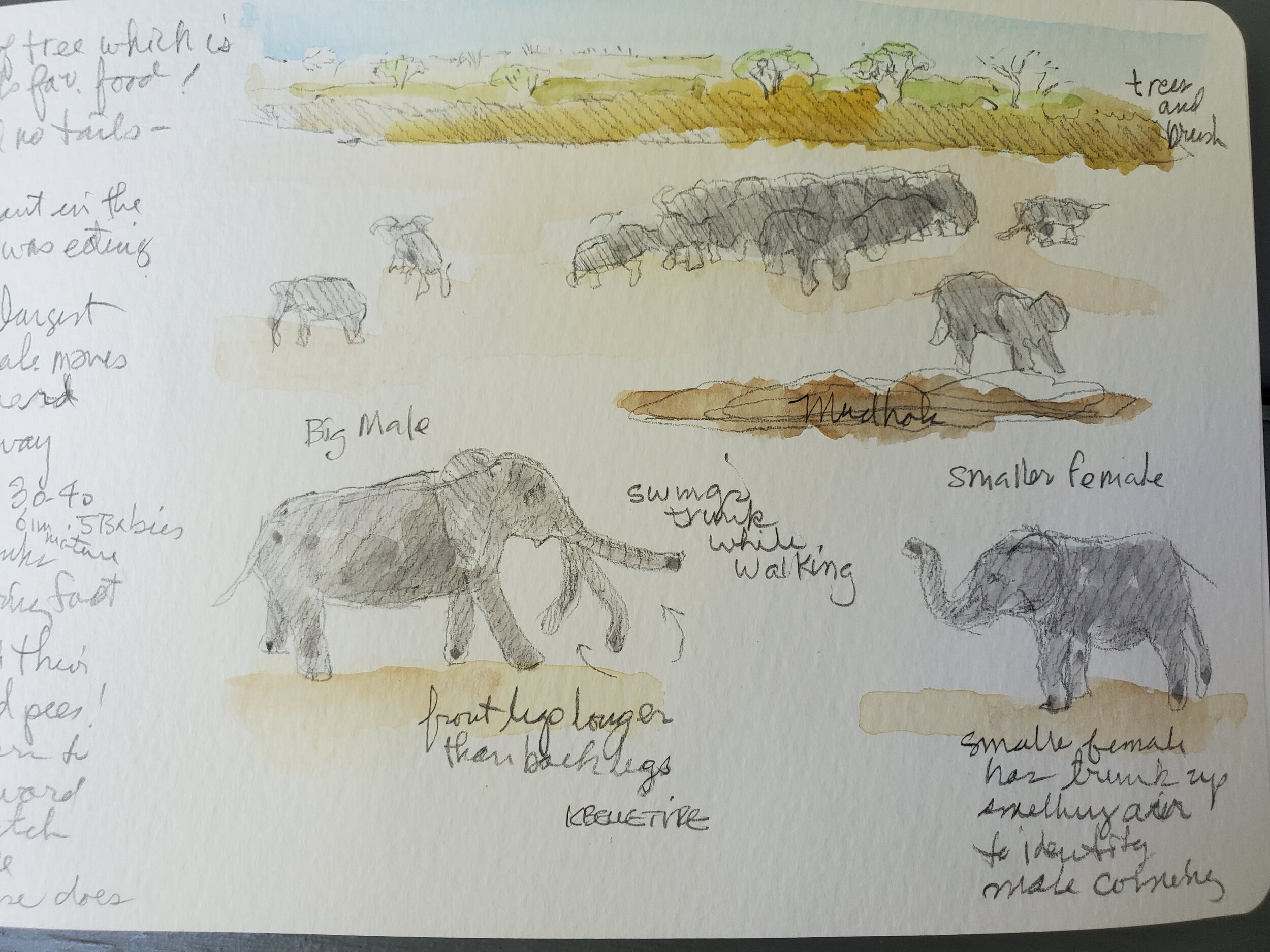
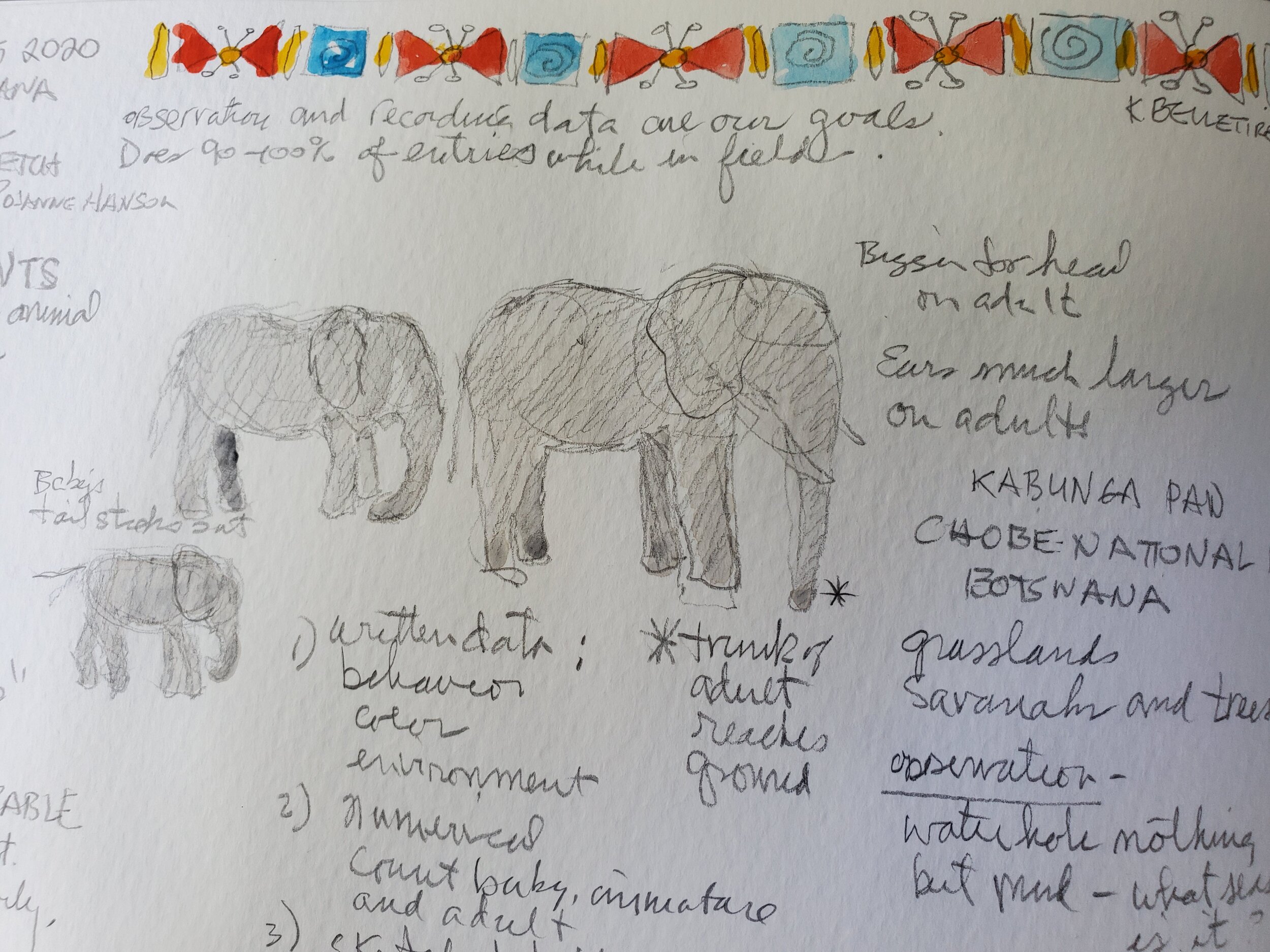
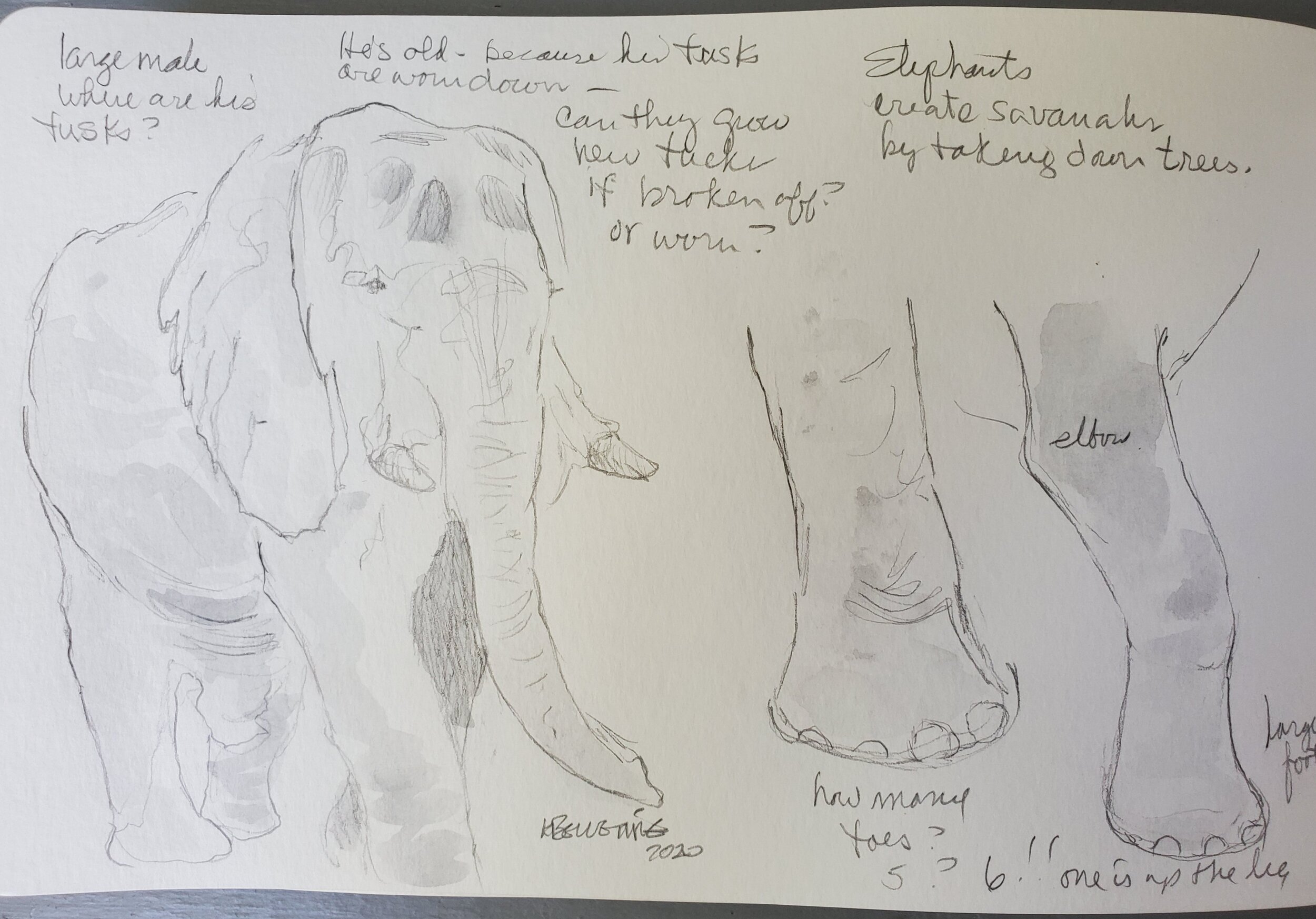
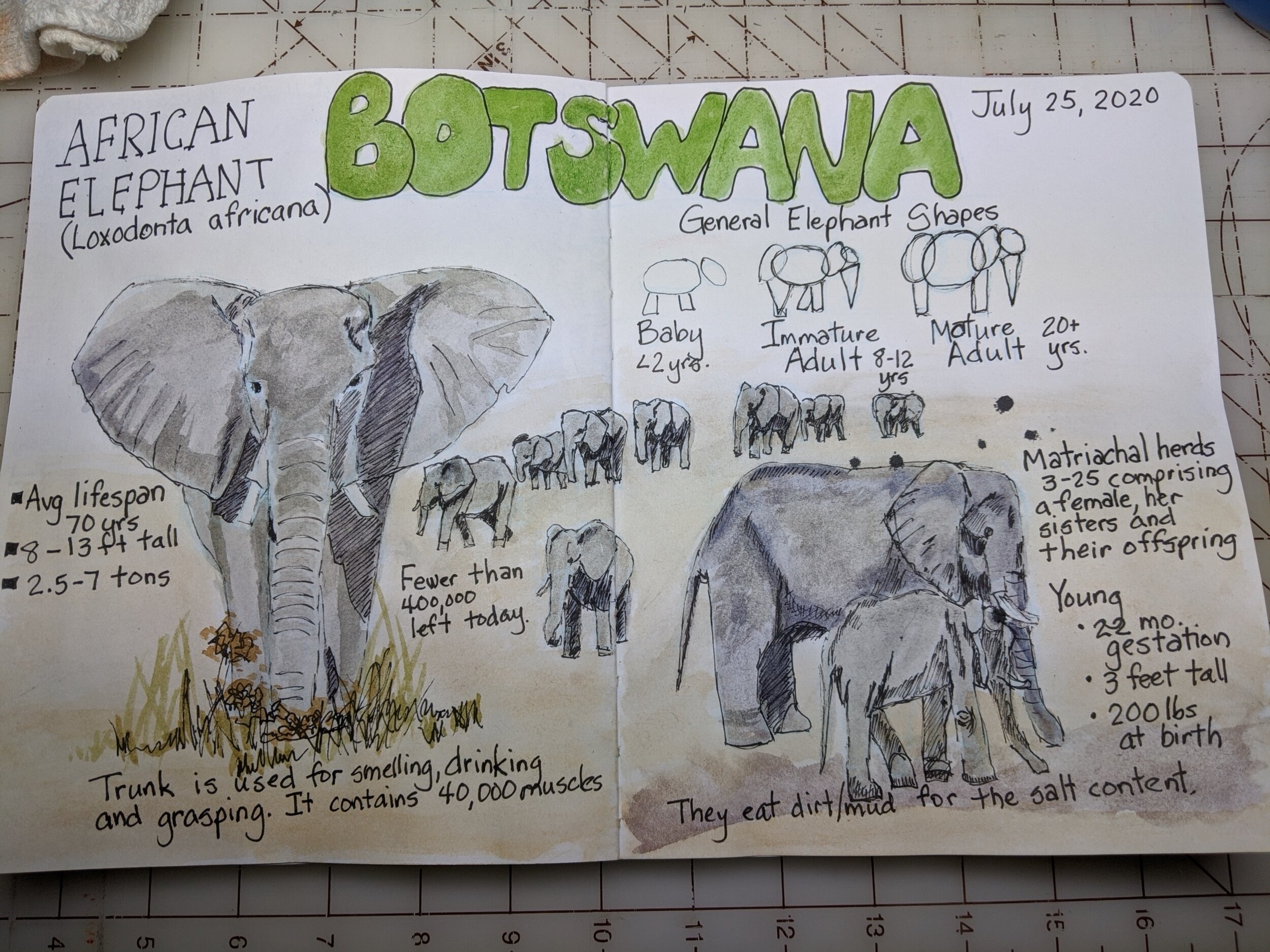
Virtual Field Trip: Yellowstone National Park
Join us as we head to Yellowstone National Park—without the crowds! We explore, sketch, and take notes on geyser basins, plants, wildlife, and the Grand Canyon of the Yellowstone, all virtually. Sketch along, or just watch, I explain how I pick what to sketch, where I put it on a page, and plan to leave room for nature data and notes.
Some tips and resources mentioned in the workshop:
Google Earth tour of Yellowstone: use this link here
PDF with metadata and nature data for each of the stops we made in the park. Download here.
Here are the images we used for sketching (all from the Google Earth tour, in the public domain; credit named where given):
Roseann’s finished pages:
Participants’ pages:
Don’t miss out! Get notifications of new tutorials, upcoming workshops, books, and more right to your in-box. We don’t over-do it, and we always respect your privacy. Promise!
#fieldarts #sketching #naturejournal #watercolor @swarovskioptik_nature #swarovskioptik_nature
Virtual Field Trip: Lake District National Park
[Scroll down for resources for the workshop.]
May 24, 2020 — Zoom workshop-demonstration on quickly sketching landscapes in the field, by Roseann Hanson (University of Arizona Desert Laboratory on Tumamoc Hill / ExploringOverland.com Field Arts Institute) and Ryan Petterson (Stanford University School of Earth Energy and Environmental Sciences).
Roseann and Ryan are both field scientists and naturalists, and keep field journals / nature journals with notes and sketches in pen, pencil, and watercolor.
In this workshop, we take you on a virtual field trip to the Lake District in England using a 360-degree-view website, and then each of us demonstrates how we zero in on a scene, and then do a live sketch and discussion of our thinking and drawing process and techniques, adding color at the end.
Plan to draw along, and we answer questions as we go.
[Please note: during Ryan's sessions a camera / Zoom malfunction created a less-than-ideal resolution, which we are trying to fix.]
----------------------------------------------------------
RESOURCES FOR THE WORKSHOP:
Explore the region we’ll be visiting on our virtual field trip, Mosedale, Wasdale Head, Ritson’s Force, Lake District, NW England:
VRGlaciers, University of Worcester website
Click on the orange “TAKE ME THERE” to go to the 360-degree view; we’ll be at site #4 and later, #3 and #6.
To see Wasdale Head region on Google Maps, click here.
If you would like to sketch and paint along with me and Ryan, have your field notebook / nature journal handy, and a waterproof pen (if doing watercolor, too) or pencil.
John Muir Laws on sketching “landscapitos”— here, and peruse Instagram for great quick-sketches hash tagged #landscapito here.
Screen shots for our sketching demos:
Instructor and participant sketches from the workshop:
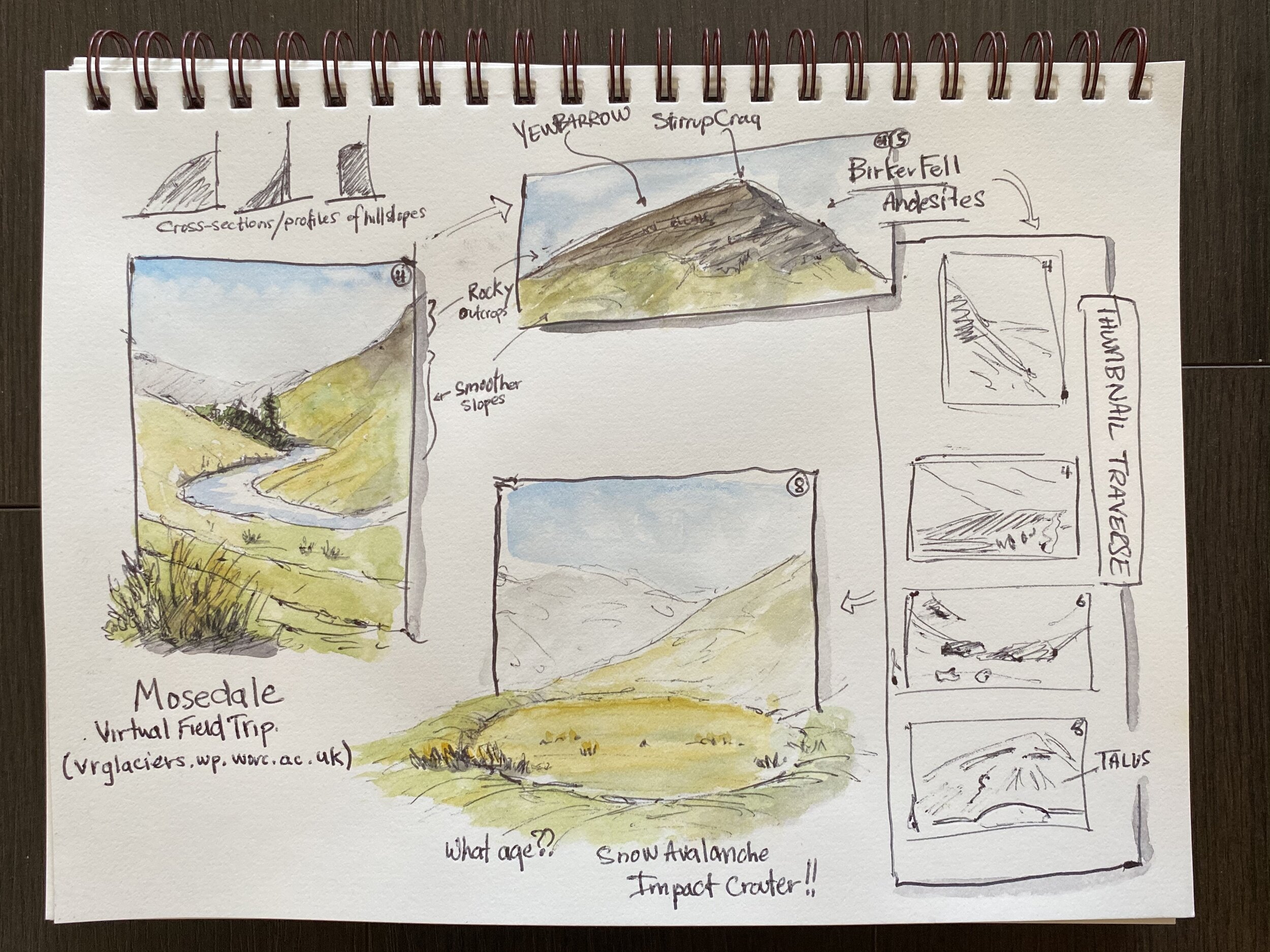
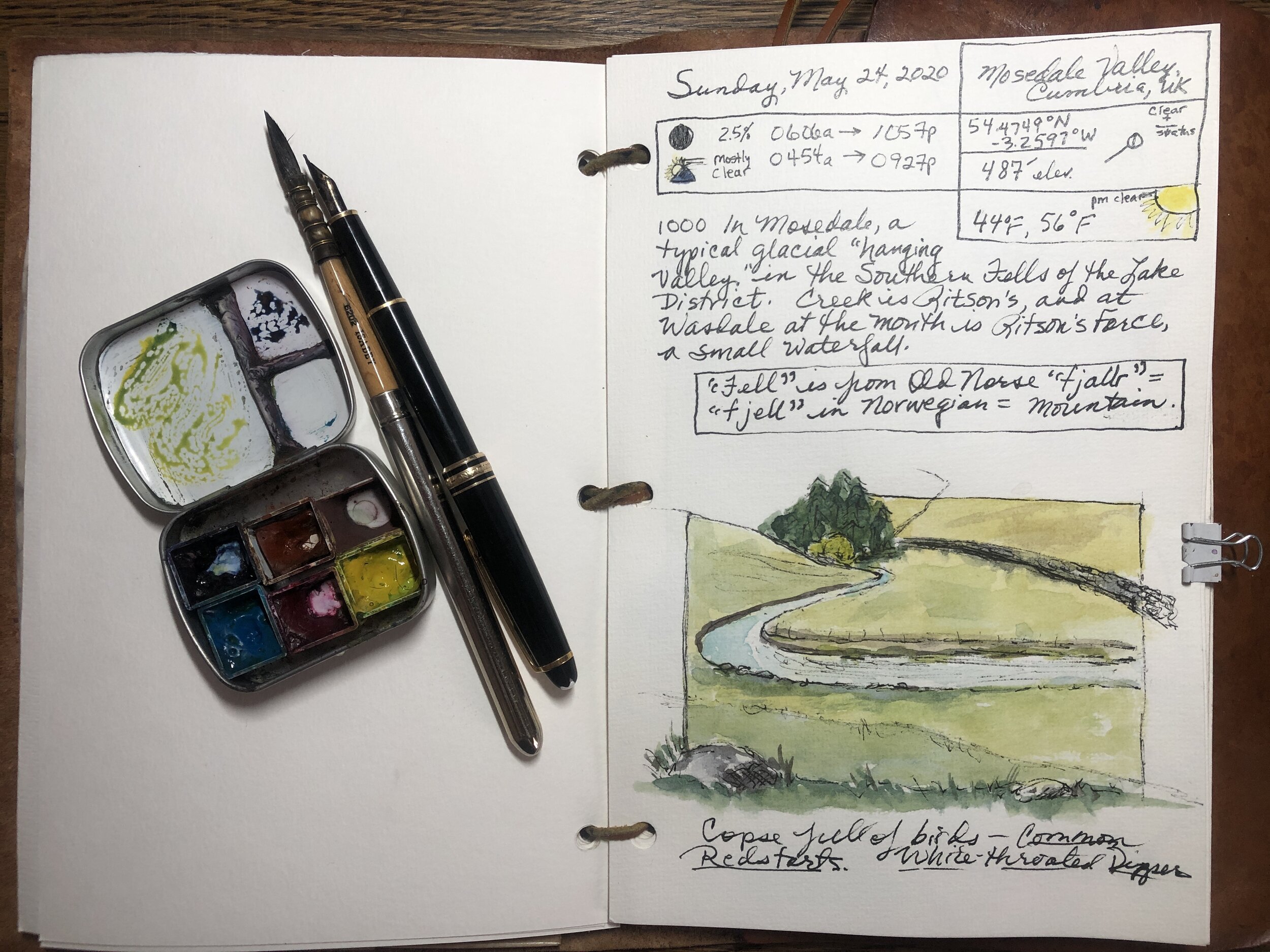
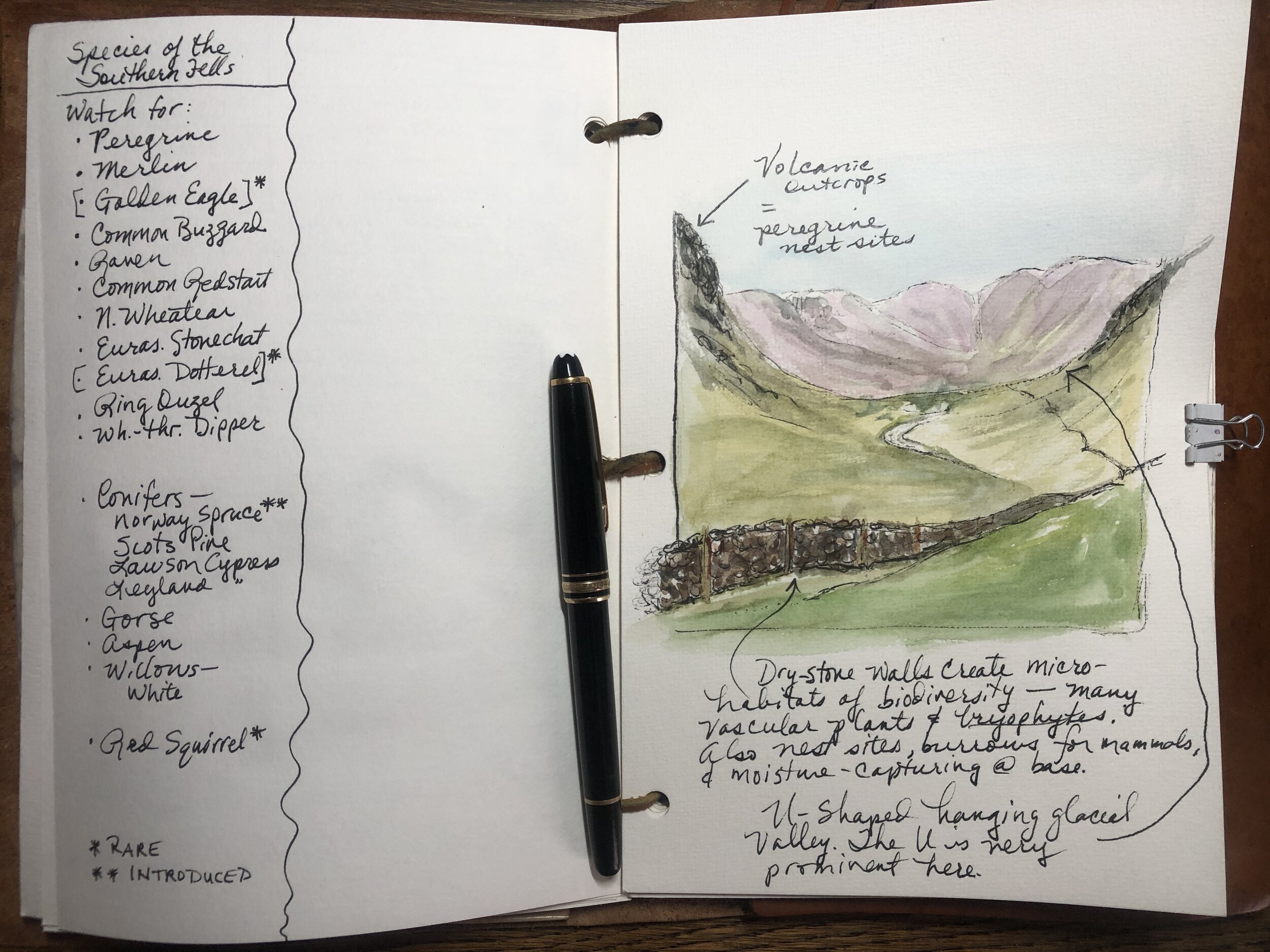

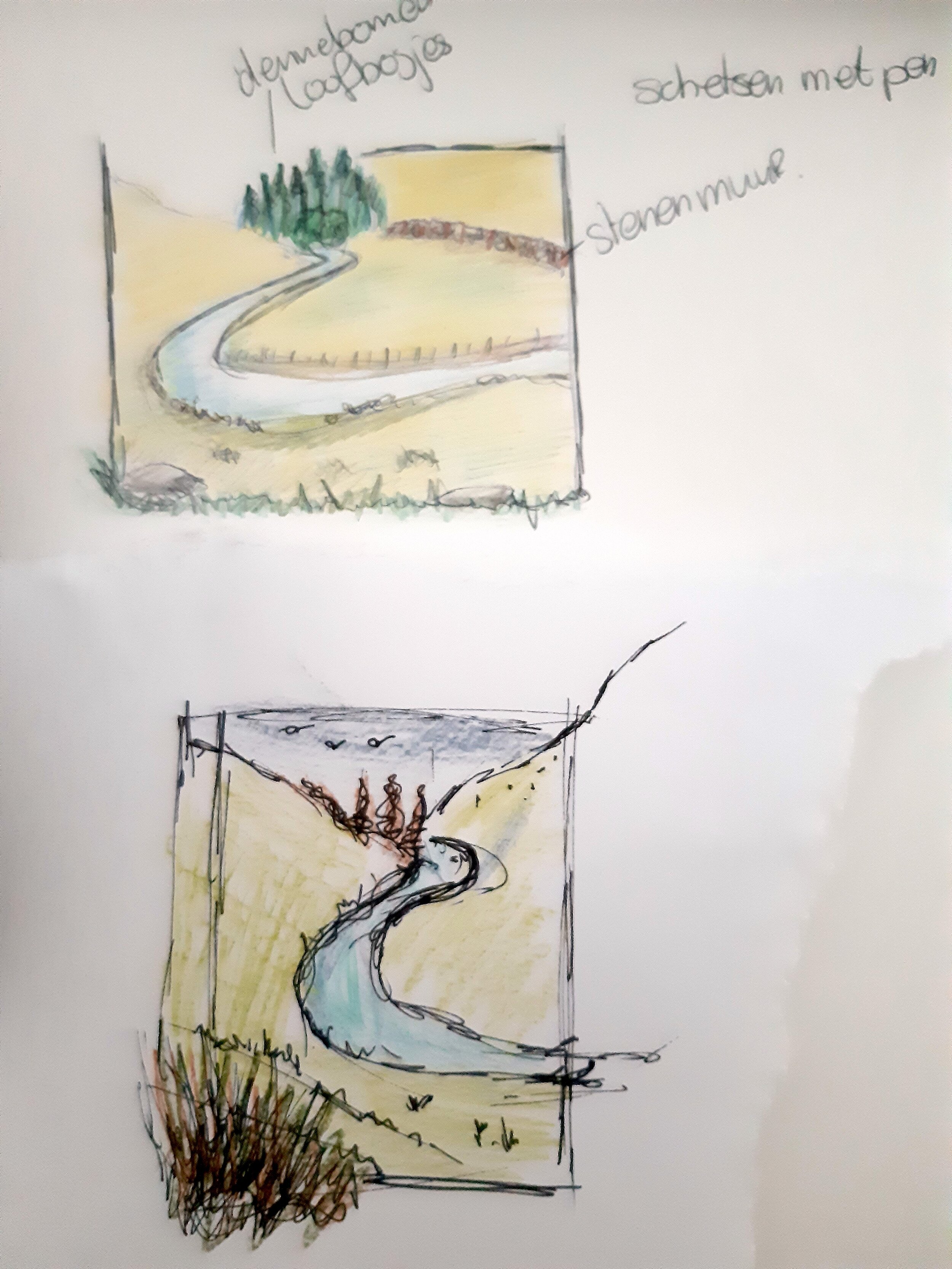
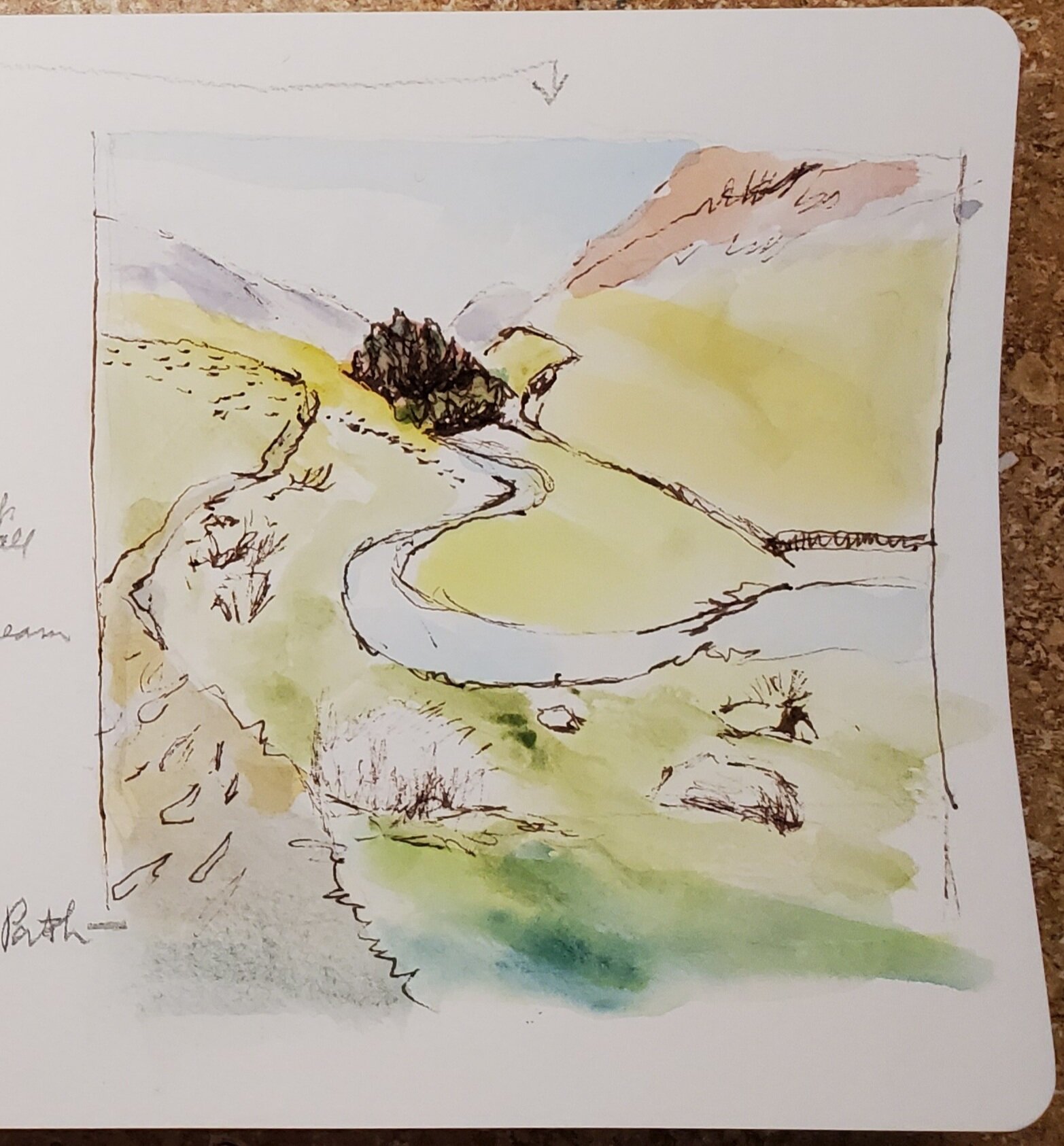
Roseann's palette in a small tin (see here):
Ryan’s palette (in ExpeditionaryArt.com’s mini paint kit):
----------------------------------------------------------
Online resources:
John Muir Laws' Nature Journal Club:
facebook.com/groups/naturejournalclub/
----------------------------------------------------------
Books:
Nature Journaling for a Wild Life by Roseann Hanson
Available at ExploringOverland.com through our Field Arts Institute:
exploringoverland.com/field-arts-shop
Laws Guide to Nature Drawing and Journaling:
----------------------------------------------------------
Follow us on IG:
@roseannhanson @desert.laboratory @ry_pett @stanfordearth
Facebook/roseannhansonexplore
#fieldarts #sketching #naturejournal #watercolor @swarovskioptik_nature #swarovskioptik_nature
Exploring New Views – with a Virtual Field Trip to Sabino Canyon
Whether you’re an old hand or a beginner at nature journaling and field sketching, learning to visualize subjects in new ways is really helpful for breaking out of ruts—plus it’s just fun. In this online workshop, we explore three unique views: side-view; top-view; and, my current favorite, zoom in / zoom out. [For those of you who took the workshop, to jump to the section where I finished the pages with watercolor and more ink line work, go to the 1:00:00 time frame in the video.]
Some tips and resources mentioned in the workshop:
Technology-assisted views:
How to use the magnifier function on your iPhone or Android
Metadata—what to include and where to find the information: on my blog
Other tutorials on visualizing landscapes in different ways: on my blog
Below are the finished pages from the workshop, demonstrating a “3D” view, a zoom-out (world) view, a cutaway view, and a zoom-in view.
I darkened the New Moon a bit more, and added more information about axial tilt during the solstice. In the 3D landscape I enhanced the ink line work a little bit, and put a blue wash (indanthrone) over the far ridge to help push it back visually.
In the cutaway view, I used pen line work to outline shrubs and enhance the grass and roots. I also added shading to the snail shell, and more written information.
Using Simple Shapes and Proportion Tips to Draw Difficult Subjects
An excerpt—in 4X time—showing Roseann Hanson's process for simplifying difficult subjects into shapes and then checking proportions using simple measuring tricks. Full workshop demo is here.
Minimalist Watercolor for Nature Journaling
If you are new to watercoloring in your nature journal or field notes—or to using a waterbrush instead of a traditional brush—here is a short tutorial on using a minimalist approach, using just five colors (a cyan-magenta-yellow triad + burnt sienna and a dark blue) from my Minimalist Paint Kit. My workbook, Nature Journaling for a Wild Life, includes a section on how to start using simple colors and which ones are easiest to use and why. I use transparent, non-staining ("liftable") colors from Daniel Smith: Cerulean or Manganese Blue Hue (="cyan"), Quinacridone Rose (="magenta”), and Aureolin (="yellow”) plus Burnt Sienna and Indanthrone Blue.
Below is a link for a downloadable PDF of my Minimalist Watercolor Worksheets.
Triad + 2 color Minimalist Watercolor Technique – Printable color mixing practice sheets
Click HERE to download a PDF. Tip: if you have 8 1/2 x 11 watercolor paper that is 90-lb or lighter, you can print on a laser printer (not an inkjet, which will smear).
Fellow teachers: If you use my PDF in a class, please make sure to include the attribution for my work; I created these resources for my book and for my classes, and I appreciate the attribution!


